Microsoft RM-128 Quad band GSM, US Dual band WCDMA, BT, Smart phone User Manual R1114 en
Microsoft Mobile Oy Quad band GSM, US Dual band WCDMA, BT, Smart phone R1114 en
Contents
- 1. Manual 1
- 2. Manual 2
Manual 2
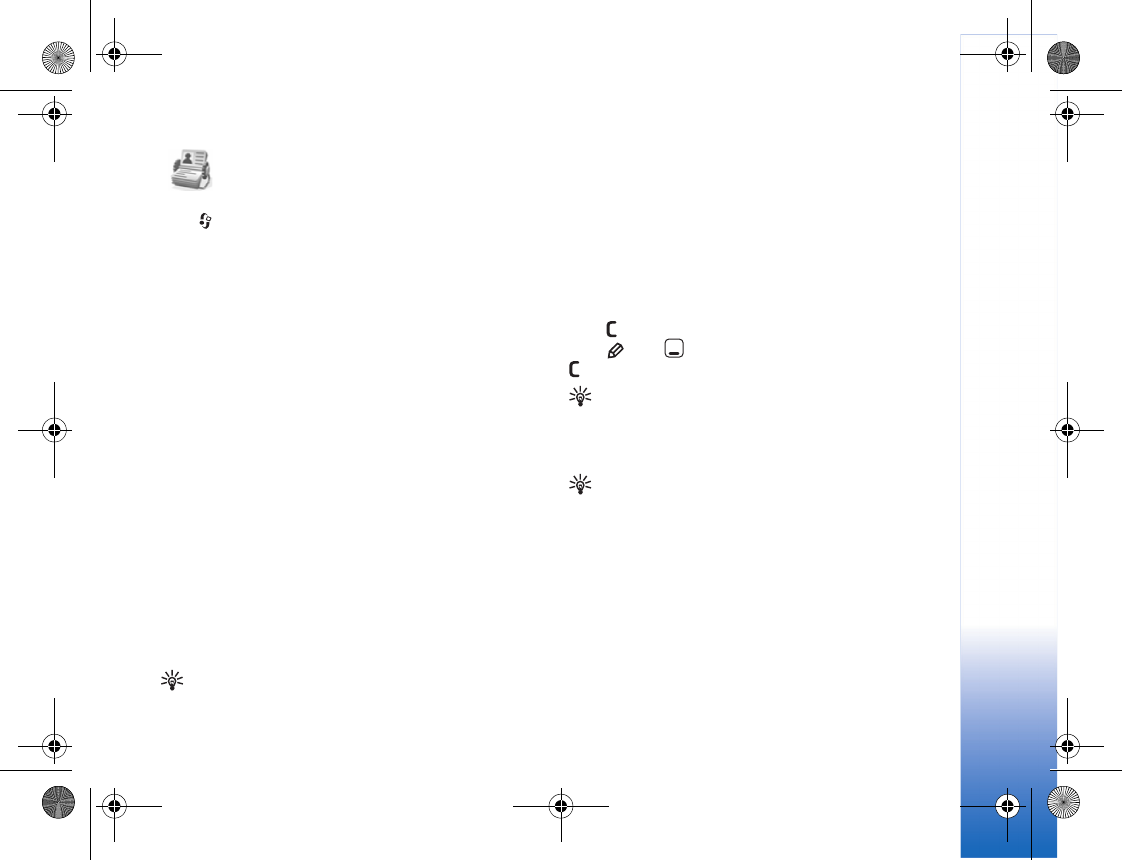
Address book
69
Address book
Press , and select Addr. Book. Addr. Book holds details
of your contacts, such as phone numbers and e-mail
addresses. Each contact’s details are stored on a contact
card, which can include a personal ringing tone (see "Add
ringing tones for addresses," p. 70) or a thumbnail image
for the contact. You can also create contact groups, which
allow you to send text messages or e-mail to many
recipients at the same time. See "Contact groups," p. 70.
You can add received address information (business cards)
to Addr. Book. See "Data and settings," p. 61. Address
information can only be sent to or received from
compatible devices.
Contact cards
To add details of a new contact in Addr. Book, select
Options > New contact.
To edit a contact card in Addr. Book, select it
and Options >Edit. You can search for the desired
contact by entering the first letters of the name to the
search field. A list of contacts, starting with the letters,
appears on the display.
Tip! To add or edit several contact cards, use Nokia
Contacts Editor available in Nokia PC Suite.
To attach a small thumbnail image to a contact card, open
the contact card, and select Options > Edit > Options >
Add thumbnail. The thumbnail image is shown when the
contact calls.
To delete a contact card in Addr. Book, select a card, and
press . To delete several contact cards at the same time,
press and to mark the contact cards , and press
to delete.
Tip! 1-touch dialing is a quick way to call frequently
used numbers. You can assign 1-touch dialing keys to
eight phone numbers. See "1-touch dial a phone
number," p. 73.
Tip! To send contact information, select the contact
card you want to send. Select Options > Send > Via
text message, Via multimedia, Via Bluetooth, or Via
infrared. See "Messaging," p. 55 and "Send data using
Bluetooth connectivity," p. 114.
To view the amount of addresses, groups, and the
available memory in Addr. Book, select Options > Check
memory.
R1114_en.book Page 69 Thursday, October 19, 2006 3:43 PM
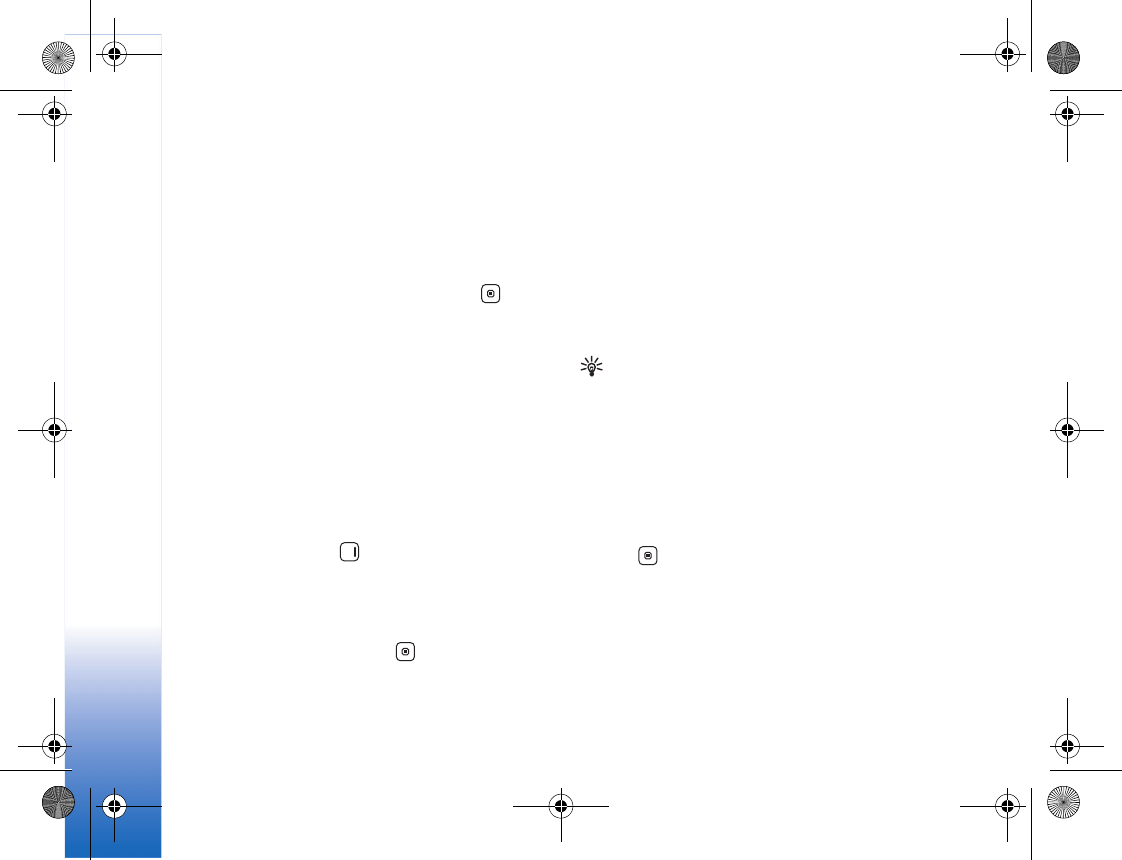
Address book
70
Default numbers and addresses
You can assign default numbers or addresses to a contact
card. In this way if a contact has several numbers or
addresses, you can easily call or send a message to the
contact to a certain number or address. The default
number is also used in voice dialing.
1In Addr. Book, select a contact, and press .
2Select Options > Defaults.
3Select the number or address to which you want to
add a default value, and select Assign.
4Select a number or an address you want to set as a
default.
The default number or address is underlined in the contact
card.
Contact groups
To create a contact group, do the following:
1In Addr. Book, press to open the groups list.
2Select Options > New group.
3Write a name for the group or use the default name
Group %N, and select OK.
4Open the group, and select Options > Add members.
5Scroll to a contact, and press to mark it. To add
multiple members at a time, repeat this action on all
the contacts you want to add.
6Select OK to add the contact to the group.
To rename a group, select Options > Rename, enter the
new name, and select OK.
To add a contact to an existing contact group, select
Options > Add to group: .
To remove contacts from a group, do the following:
1In the groups list, open the group you want to modify.
2Select the contact and Options > Remove from group.
3Select Yes to remove the contact from the group.
Tip! To check to which groups a contact belongs,
scroll to the contact, and select Options > Belongs to
groups.
Add ringing tones for addresses
When a contact or group member calls you, the device
plays the chosen ringing tone (if the caller’s telephone
number is sent with the call and your device recognizes it).
1Press to open a contact card or go to the groups list,
and select a contact group.
2Select Options > Ringing tone. A list of ringing tones
opens.
3Select the ringing tone you want to use for the
individual contact or the selected group.
R1114_en.book Page 70 Thursday, October 19, 2006 3:43 PM
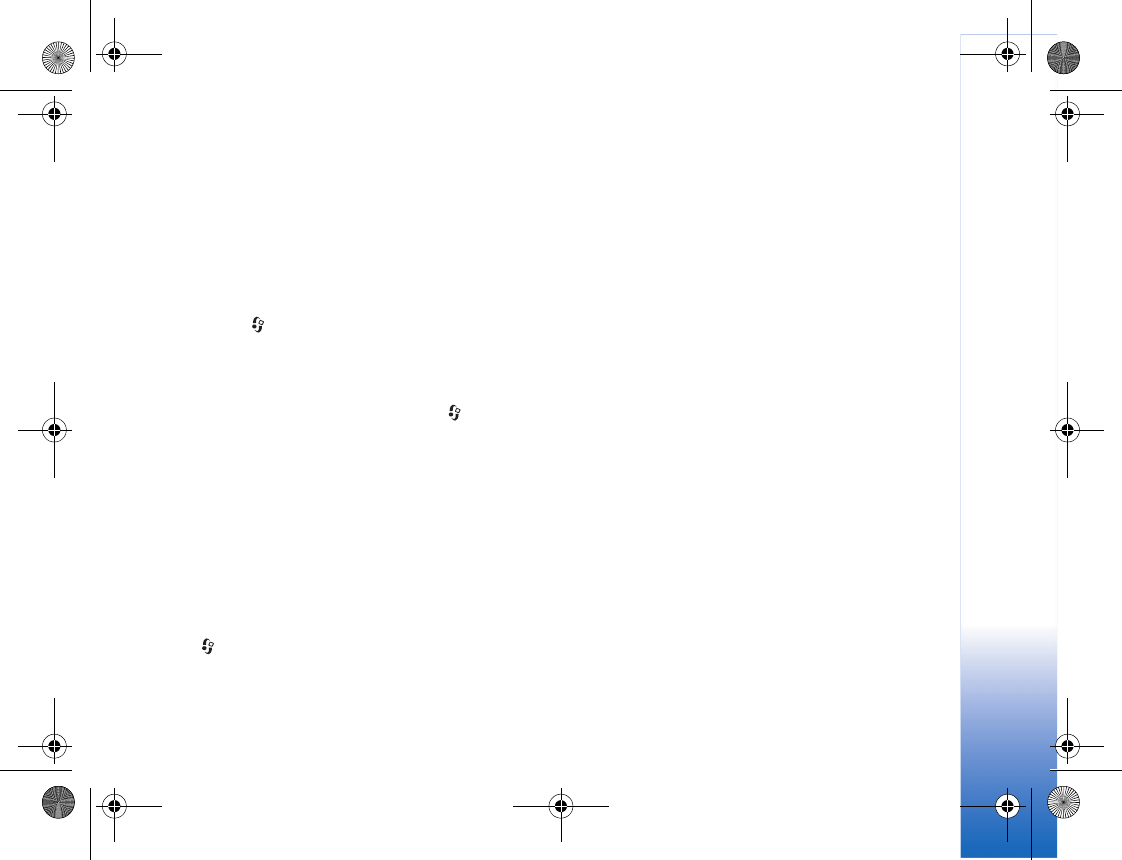
Address book
71
You can also use a song as a ringing tone. See "Set a song
as a ringing tone," p. 39.
To remove the ringing tone, select Default tone from the
list of ringing tones.
Copy contacts
To copy names and numbers from a SmartChip to your
device, press , and select Addr. Book > Options >
SmartChip contacts > SmartChip directory. Select the
names you want to copy and Options > Copy to Address
Book.
To copy addresses to your SmartChip, press , and select
Addr. Book. Select the names you want to copy and
Options > Copy to SChip direct. or Options > Copy > To
SmartChip directory. Only the contact card fields
supported by your SmartChip are copied.
SChip directory and other SmartChip
services
For availability and information on using SmartChip
services, contact your service provider.
Press , and select Addr. Book > Options > SmartChip
contacts > SChip directory to see the names and numbers
stored on the SmartChip. In the SmartChip directory you
can add, edit, or copy numbers to Addr. Book, and make
calls.
To view the list of fixed dialing numbers, select Options >
SmartChip contacts > Fixed dialing contacts. This
setting is only shown if supported by your SmartChip.
To restrict calls from your device to selected phone
numbers, select Options > Activ. fixed dialing. To add
new numbers to the fixed dialing list, select Options >
New SmartChip contact. You need the PIN2 code for
these functions.
When you use Fixed dialing, packet data connections are
not possible, except when sending text messages over a
packet data connection. In this case, the message center
number and the recipient’s phone number must be
included on the fixed dialing list.
When fixed dialing is activated, calls may be possible to
the official emergency number programmed into your
device.
R1114_en.book Page 71 Thursday, October 19, 2006 3:43 PM

Make calls
72
Make calls
Voice calls
Tip! To increase or decrease the volume during a
call, use the volume keys, or scroll left and right. If you
have set the volume to Mute, select Unmute first, and
then scroll left or right.
1In the idle mode, enter the phone number, including
the area code. To remove a number, press .
For international calls, press twice for the +
character (replaces the international access code), and
enter the country code, area code (omit the leading
zero if necessary), and phone number.
2Press to call the number.
3Press to end the call (or to cancel the call
attempt).
Pressing always ends a call, even if another
application is active.
To make a call from Addr. Book, press , and select
Addr. Book. Scroll to the desired name, or enter the first
letters of the name to the search field. Matching
addresses are listed. To call, press . Select the call type
Voice call.
You must copy the address from your SmartChip to Addr.
Book before you can make a call this way. See "Copy
contacts," p. 71.
To call your voice mailbox (network service), press and hold
in the idle mode. See also "Call forwarding," p. 107.
Tip! To change the phone number of your voice
mailbox, press , and select Settings > Voice mail >
Options > Change number. Enter the number
(obtained from your service provider), and select OK.
To call a recently dialed number in the idle mode, press
. Scroll to the number, and press .
Make a conference call
1Make a call to the first participant.
2To make a call to another participant, select Options >
New call. The first call is automatically put on hold.
3When the new call is answered, to join the first
participant in the conference call, select Options >
Conference (network service).
To add a new person to the call, repeat step 2, and
select Options > Conference > Add to conference.
Your device supports conference calls between a
maximum of six participants, including yourself.
R1114_en.book Page 72 Thursday, October 19, 2006 3:43 PM
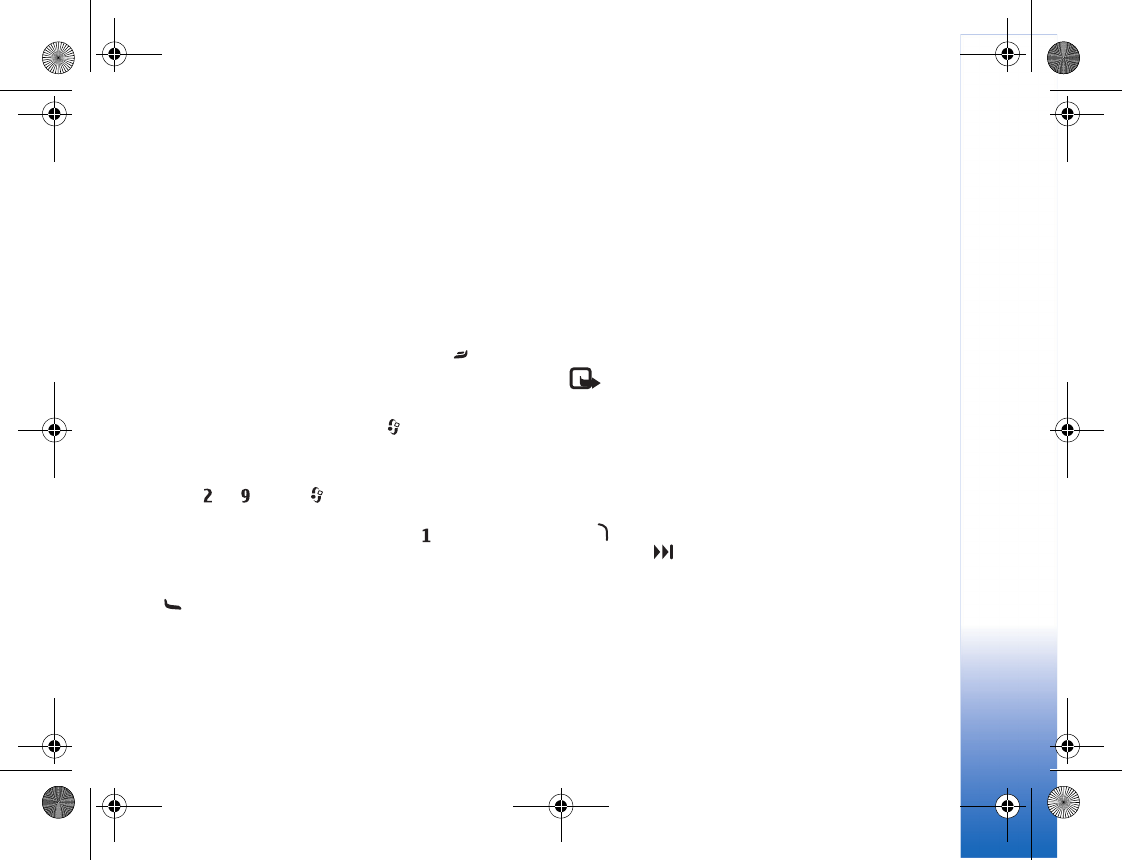
Make calls
73
To have a private conversation with one of the
participants, select Options > Conference > Private.
Select a participant and Private. The conference call is
put on hold on your device. The other participants can
still continue the conference call. After you finish the
private conversation, select Options > Add to
conference to return to the conference call.
To drop a participant, select Options > Conference >
Drop participant, scroll to the participant, and select
Drop.
4To end the active conference call, press .
1-touch dial a phone number
To activate 1-touch dialing, press , and select
Settings > Config. > Call > 1-touch dialing> On.
To assign a phone number to one of the 1-touch dialing
keys ( — ), press , and select Settings > Spd. dial.
Scroll to the key to which you want to assign the phone
number, and select Options > Assign. is reserved for
the voice mailbox.
To call in the idle mode, press the 1-touch dial key and
.
Voice dialing
Your device supports enhanced voice commands.
Enhanced voice commands are not dependent on the
speaker’s voice, so the user does not record voice tags in
advance. Instead, the device creates a voice tag for the
entries in Addr. Book, and compares the spoken voice tag
to it. The voice recognition in the device adapts to the
main user’s voice to recognize the voice commands better.
The voice tag for an address is the name or nickname that
is saved on the contact card. To listen to the synthesized
voice tag, open the contact card, and select Options >
Play voice tag.
Make a call with a voice tag
Note: Using voice tags may be difficult in a noisy
environment or during an emergency, so you should
not rely solely upon voice dialing in all circumstances.
When you use voice dialing, the loudspeaker is in use. Hold
the device at a short distance away when you say the
voice tag.
1To start voice dialing, in the idle mode, press and hold
. To start voice dialing with the fold closed, press
and hold . If you are using a compatible headset
with the headset key, press and hold the headset key
to start voice dialing.
2A short tone is played, and Speak now is displayed. Say
clearly the name or nickname that is saved on the
address card.
3The device plays a synthesized voice tag for the
recognized address in the selected device language,
R1114_en.book Page 73 Thursday, October 19, 2006 3:43 PM
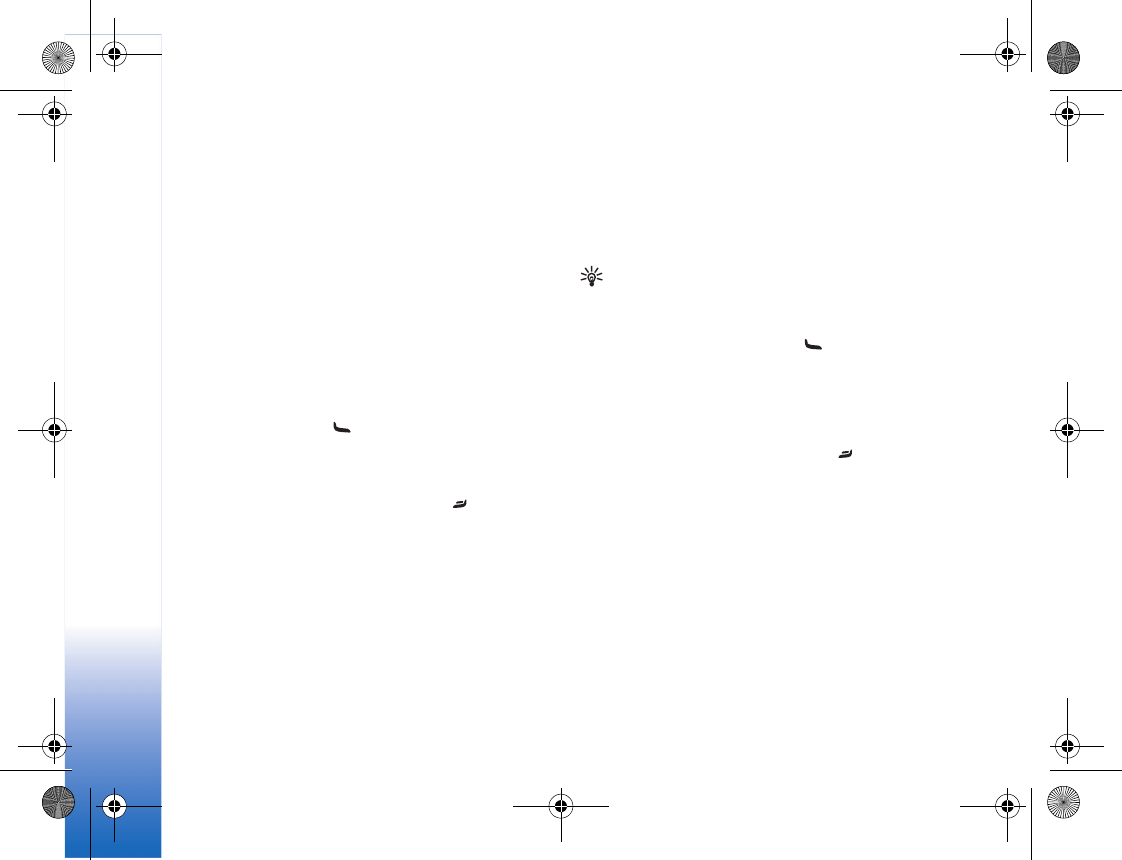
Make calls
74
and displays the name and number. After a timeout of
approximate 2.5 seconds, the device dials the number.
If the recognized address is not correct, select Next to
view a list of other matches, or Quit to cancel voice
dialing.
If several numbers are saved under the name, the device
selects the default number, if it has been set. Otherwise,
the device selects the first available number of the
following: Mobile, Mobile (home), Mobile (work),
Telephone, Tel. (home), and Tel. (work).
Answer or decline a call
To answer a call, press .
To mute the ringing tone when a call comes in, select
Silence.
If you do not want to answer a call, press . If you have
activated the Call forward > If busy function to forward
calls, declining an incoming call also forwards the call.
See "Call forwarding," p. 107.
When you decline an incoming call, you can send a text
message to the caller informing why you cannot answer
the call. Select Options > Send text message. You can
edit the text before sending it. To set up this option and
write a standard text message, see "Call config.," p. 101.
Call waiting
You can answer a call while you have another call in
progess if you have activated Call waiting in Settings >
Configuration > Call > Call waiting. Call waiting is a
network service.
Tip! To change the device tones for different
environments and events, for example, when you want
your device to be silent, see "Profiles—set tones," p. 95.
To answer the waiting call, press . The first call is put
on hold.
To switch between the two calls, select Swap. To connect
an incoming call or a call on hold with an active call and
to disconnect yourself from the calls, select Options >
Transfer. To end the active call, press . The first call
remains active. To end both calls, select Options > End all
calls.
Options during a voice call
Many of the options that you can use during a voice call
are network services. Select Options > Mute or Unmute,
Answer, Decline, Swap, Hold or Unhold, Activate
handset, Activate loudsp., or Activate handsfree (if a
compatible headset with Bluetooth connectivity is
attached), End active call or End all calls, New call,
R1114_en.book Page 74 Thursday, October 19, 2006 3:43 PM
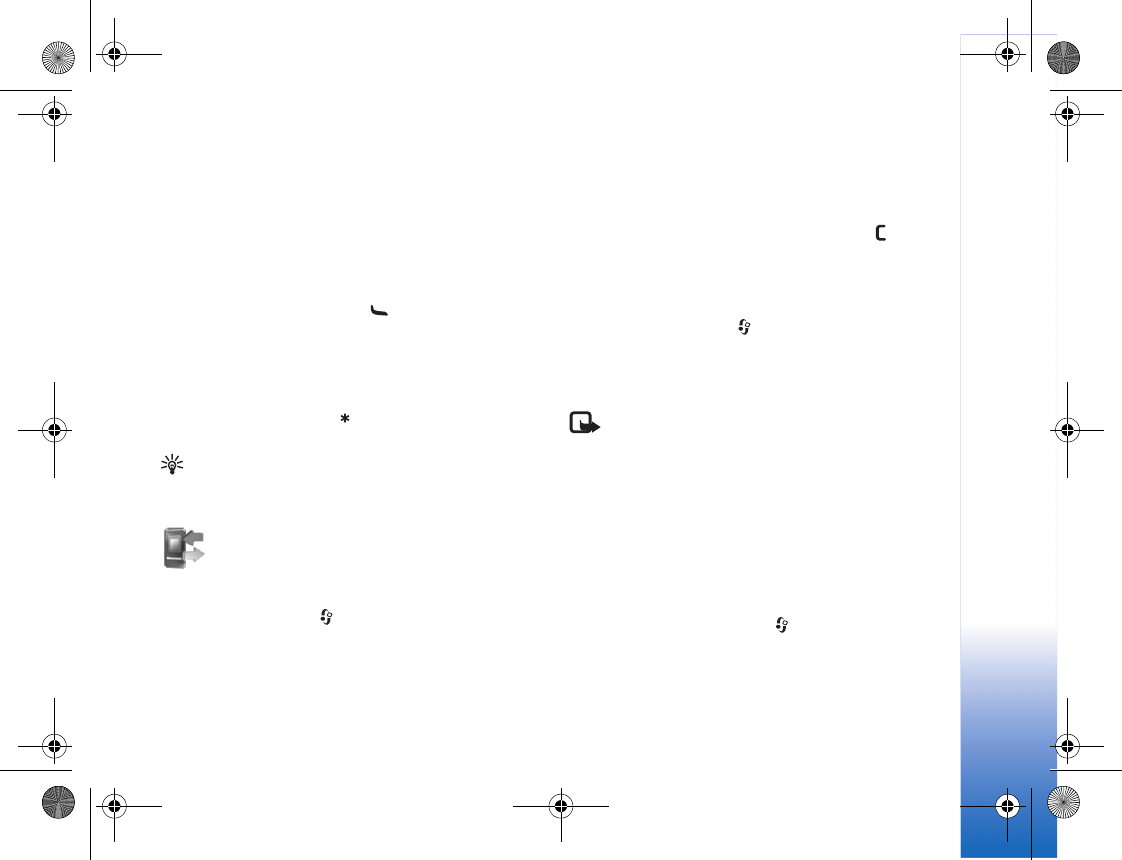
Make calls
75
Conference, Transfer, and Open active idle. Select from
the following:
Replace—to end an active call and replace it by answering
the waiting call
Send MMS (in UMTS networks only)—to send an image or
a video in a multimedia message to the other participant
of the call. You can edit the message and change the
recipient before sending. Press to send the file to a
compatible device (network service).
Send touch tones—to send touch tone strings, for
example, a password. Enter the touch tone string or search
for it in Address Book. To enter a wait character (w) or a
pause character (p), press repeatedly. Select OK to
send the tone.
Tip! You can add touch tones to the Phone number
or Touch tones fields in a contact card.
Log
To monitor the phone numbers of missed, received, and
dialed voice calls, press , and select Log. The device
registers missed and received calls only if the network
supports these functions, the device is switched on, and
within the network service area.
To clear all recent call lists, select Options > Delete
recent calls in the recent calls main view. To clear one of
the call logs, open the register you want to erase, and
select Options > Clear list. To clear an individual event,
open a register, scroll to the event, and press .
Call time
To monitor the approximate duration of your incoming
and outgoing calls, press , and select Log> Call time.
To set the display of the call timers while a call is active,
select Log > Options > Settings > Show call time > Yes
or No.
Note: The actual time invoiced for calls by your
service provider may vary, depending on network
features, rounding off for billing, and so forth.
To clear call duration timers, select Options > Clear
timers. For this you need the lock code. See "Phone and
SmartChip," p. 104.
Data counter
To check the amount of data sent and received during
packet data connections, press , and select Log > Data
counter. For example, you may be charged for your packet
data connections by the amount of data sent and received.
R1114_en.book Page 75 Thursday, October 19, 2006 3:43 PM
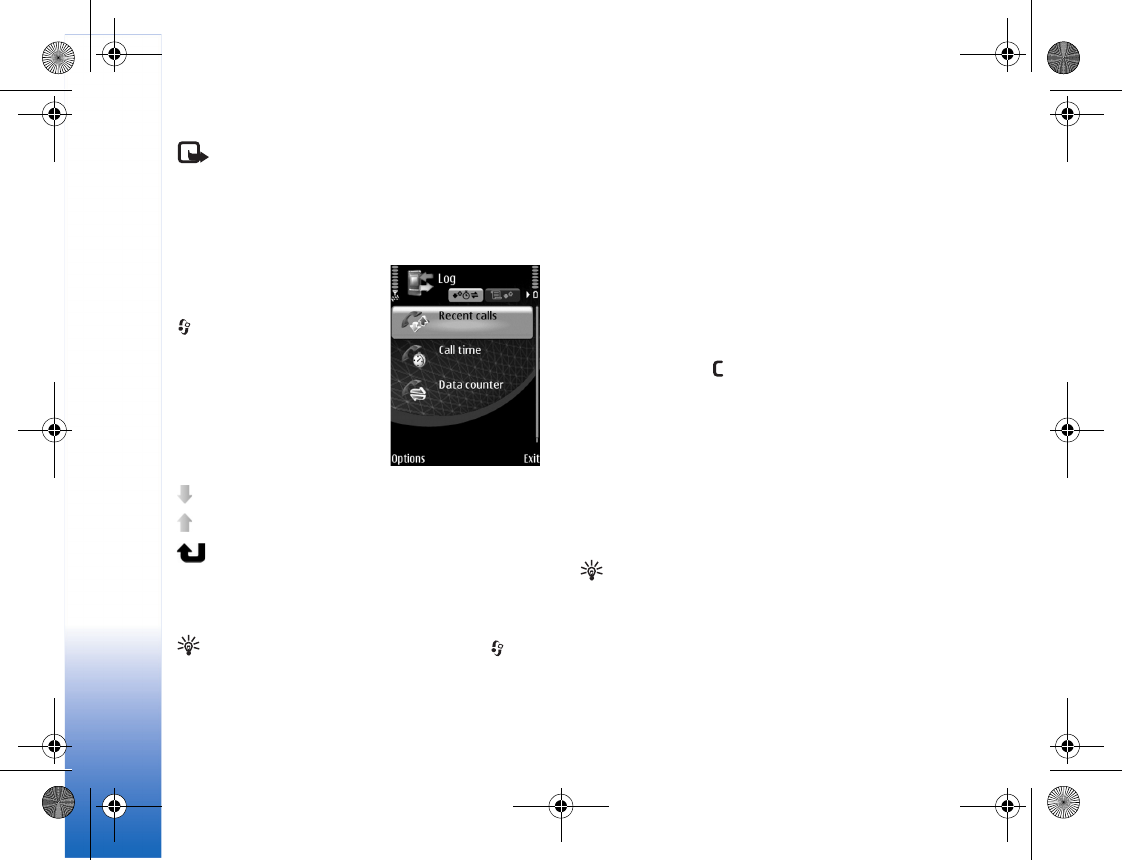
Make calls
76
Note: The packet data charges invoiced by your
service provider may vary, depending on network
features, rounding off for billing, and so forth.
Monitor all communication events
To monitor all voice calls, text
messages, or data connections
registered by the device, press
, select Log, and scroll right
to open the general log. For
each communication event,
you can see the sender or
recipient name, phone
number, name of the service
provider, or access point, and
one of the following icons:
Incoming
Outgoing
Missed
You can filter the general log to view just one type of
event, and create new contact cards based on the log
information.
Tip! To view a list of sent messages, press , and
select Messaging > Sent.
Subevents, such as a text message sent in more than one
part and packet data connections, are logged as one
communication event. Connections to your mailbox,
multimedia messaging center, or Web pages are shown as
packet data connections.
To add an unknown phone number from Log to Addr.
Book, select Options > Add to Address Book.
To erase the contents of the log, recent calls register, and
messaging delivery reports permanently, select Options >
Clear log. Select Yes to confirm. To remove a single event
from the log, press .
To set the Log duration, select Options > Settings > Log
duration. The log events remain in the device memory for
a set number of days after which they are automatically
erased to free memory. If you select No log, all the log
contents, recent calls register, and messaging delivery
reports are permanently deleted.
To view the details of a communication event, in the
general log view, select an event.
Tip! In the details view you can copy a phone number
to the clipboard and paste it to a text message. Select
Options > Copy Number.
Packet data counter and connection timer: To view how
much data, measured in kilobytes, is transferred and how
long a certain packet data connection lasts, scroll to an
R1114_en.book Page 76 Thursday, October 19, 2006 3:43 PM

Make calls
77
incoming or outgoing event indicated by Pack., and select
Options > View details.
R1114_en.book Page 77 Thursday, October 19, 2006 3:43 PM
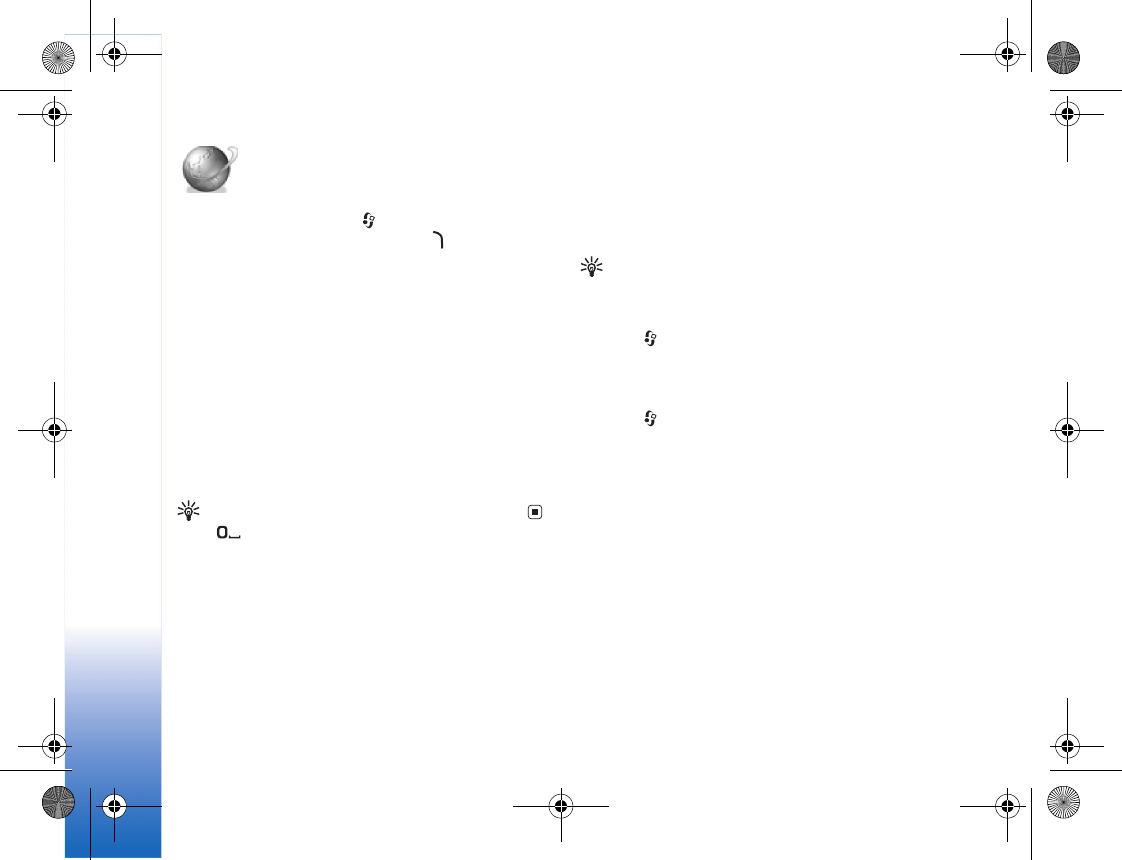
MEdia Net
78
MEdia Net
To access MEdia Net, press , and select MEdia Net
(network service). Alternatively, press .
MEdia Net provides wireless internet access to your
device.
Various service providers maintain pages specifically
designed for mobile devices that you can view with the
MEdia Net browser. These pages use the wireless markup
language (WML), extensible hypertext markup language
(XHTML), or hypertext markup language (HTML).
Check the availability of services, pricing, and fees with
your network operator or service provider. Service
providers will also give you instructions on how to use
their services.
Shortcut: To start a connection, press and hold
or in the idle mode.
Access point
To access pages, you need service settings for the page
that you want to use. You may receive the settings in a
special text message from the network operator or service
provider that offers the page. See "Data and settings,"
p. 61. For more information, contact your network
operator or service provider.
Tip! Settings may be available on the Web site of a
network operator or service provider.
Enter settings manually
1Press , select Settings > Config. > Connection >
Access points, and define the settings for an access
point. Follow the instructions given to you by your
service provider. See "Connection," p. 102.
2Press , and select MEdia Net > Options >
Bookmark manager > Add bookmark. Write a name
for the bookmark and the address of the page defined
for the current access point.
3To set the created access point as the default access
point, select Options > Settings > Access point.
Bookmarks view
The bookmarks view opens when you open MEdia Net.
Your device may have some bookmarks loaded for sites not
affiliated with Nokia. Nokia does not warrant or endorse
these sites. If you choose to access them, you should take
R1114_en.book Page 78 Thursday, October 19, 2006 3:43 PM
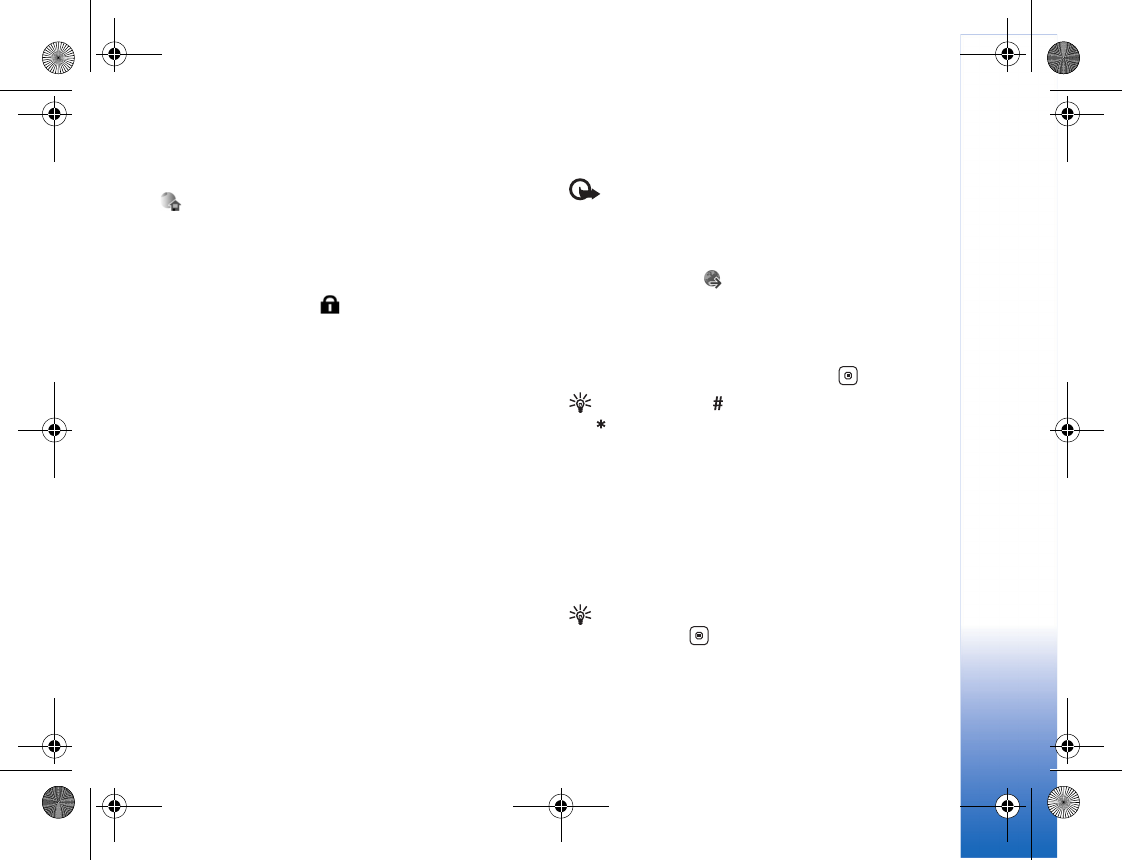
MEdia Net
79
the same precautions, for security or content, as you would
with any Internet site.
indicates the starting page defined for the default
access point.
Connection security
If the security indicator is displayed during a
connection, the data transmission between the device and
the Internet gateway or server is encrypted.
The security icon does not indicate that the data
transmission between the gateway and the content server
(or place where the requested resource is stored) is secure.
The service provider secures the data transmission
between the gateway and the content server.
Select Options > Details > Security to view details about
the connection, encryption status, and information about
server and user authentication.
Security certificates may be required for some services,
such as banking services. For more information, contact
your service provider. See also "Certif. management,"
p. 105.
Browse
Important: Use only services that you trust and that
offer adequate security and protection against harmful
software.
To download a page, select a bookmark, or enter the
address in the field ( ).
On a browser page, new links appear underlined in blue
and previously visited links in purple. Images that act as
links have a blue border around them.
To open links and make selections, press .
Shortcut: Press to jump to the end of a page and
to the beginning of a page.
To go to the previous page while browsing, select Back. If
Back is not available, select Options > Navigation
options > History to view a chronological list of the pages
you visited during a browsing session.
To retrieve the latest content from the server, select
Options > Navigation options > Reload.
To save a bookmark, select Options > Save as bookmark.
Tip! To access the bookmarks view while browsing,
press and hold . To return to the browser view,
select Options > Back to page.
R1114_en.book Page 79 Thursday, October 19, 2006 3:43 PM
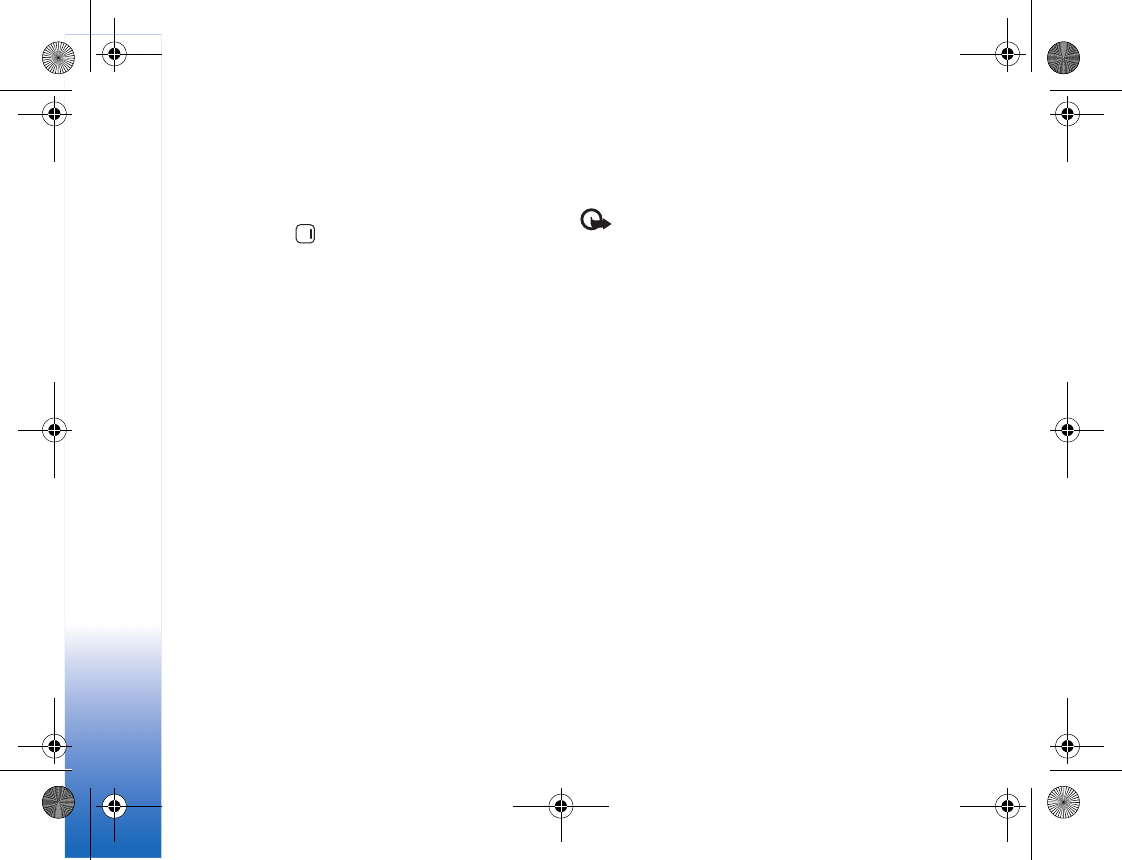
MEdia Net
80
To save a page while browsing, select Options >
Advanced options > Save page. You can save pages to
the device memory or compatible memory card (if
inserted), and browse them when offline. To access the
pages later, press in the bookmarks view to open the
Saved pages view.
To enter a new URL address, select Options > Navigation
options > Go to web address.
To open a sublist of commands or actions for the currently
open page, select Options > Service options.
You can download files that cannot be shown on the
browser page, such as ringing tones, images, operator
logos, themes, and video clips. To download an item,
select the link.
When you start a download, a list of ongoing, paused, and
completed downloads from the current browsing session
is displayed. To view the list, select Options > Downloads.
In the list, scroll to an item, and select Options to pause,
resume, or cancel ongoing downloads, or open, save, or
delete completed downloads.
Download and purchase items
You can download items such as ringing tones, images,
operator logos, themes, and video clips. These items can
be provided free, or you can purchase them. Downloaded
items are handled by the respective applications in your
device, for example, a downloaded photo can be saved in
My Stuff.
Important: Only install and use applications and
other software from sources that offer adequate security
and protection against harmful software.
1To download the item, select the link.
2Select the appropriate option to purchase the item (for
example, ‘Buy’).
3Carefully read all the information provided.
To continue the download, select Accept. To cancel the
download, select Cancel.
End a connection
To end the connection and view the browser page offline,
select Options > Advanced options > Disconnect. To end
the connection and close the browser, select Options >
Exit.
Empty the cache
The information or services you have accessed are stored in
the cache memory of the device.
A cache is a memory location that is used to store data
temporarily. If you have tried to access or have accessed
confidential information requiring passwords, empty the
R1114_en.book Page 80 Thursday, October 19, 2006 3:43 PM
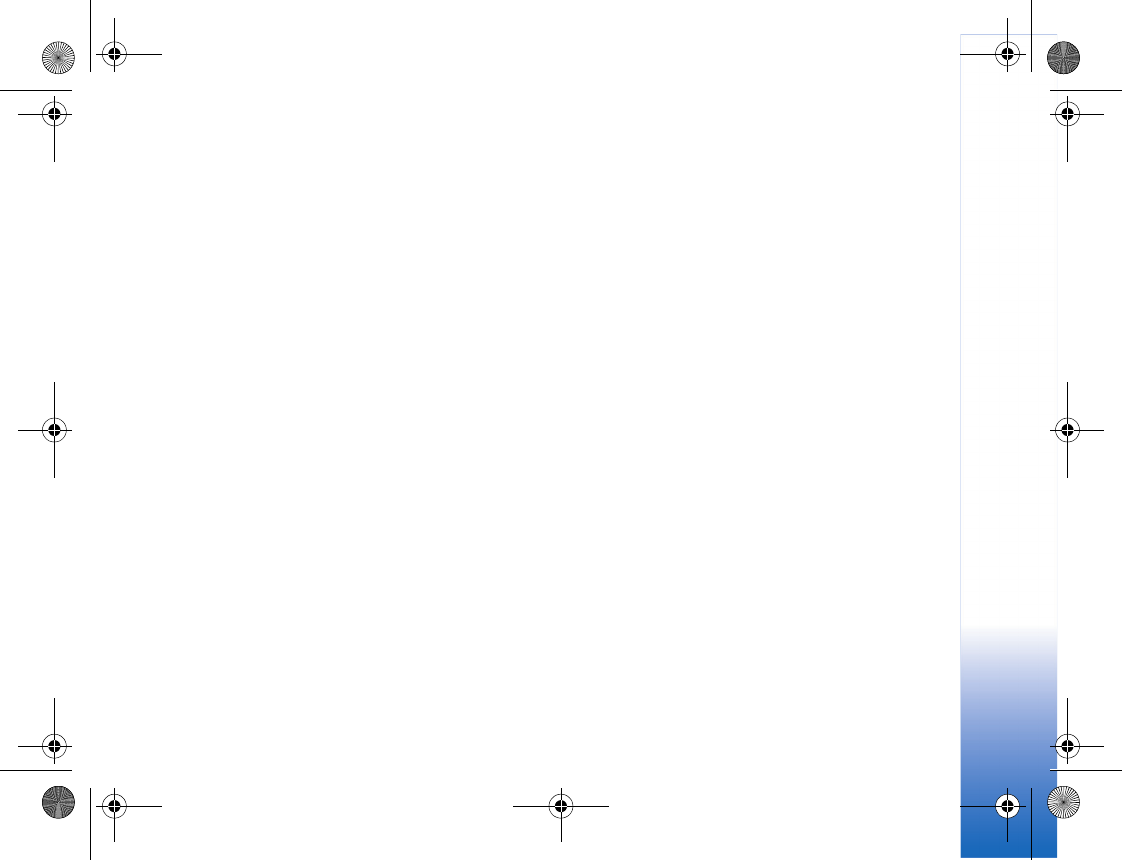
MEdia Net
81
cache after each use. The information or services you have
accessed are stored in the cache. To empty the cache,
select Options > Advanced options > Clear cache.
Settings
Select Options > Settings and from the following:
Access point—Change the default access point. See
"Connection," p. 102. Some or all access points may be
preset for your device by your service provider or network
operator, and you may not be able to change, create, edit,
or remove them.
Homepage—Define the home page.
Load imgs. & audio—Select whether you want to load
images while browsing. If you select No, to load images
later during browsing, select Options > Show images.
Font size—Select the text size.
Default encoding—If text characters are not shown
correctly, you can select another encoding according to
language.
Auto. bookmarks—Enable or disable automatic bookmark
collecting. If you want to continue collecting automatic
bookmarks but hide the folder from the bookmarks view,
select Hide folder.
Screen size—Select what is shown when you are
browsing: Select. keys only or Full screen.
Search page—Define a Web page that is downloaded
when you select Navigation options > Open search page
in the bookmarks view or when browsing.
Rendering—If you want the page layout shown as
accurately as possible when in Small screen mode, select
By quality. If you do not want external cascading style
sheets to be downloaded, select By speed.
Cookies—Enable or disable the receiving and sending of
cookies.
Java/ECMA script—Enable or disable the use of scripts.
Security warnings—Hide or show security notifications.
Confirm touch tones—Select whether you want to
confirm before the device sends touch tones during a
voice call. See also "Options during a voice call," p. 74.
R1114_en.book Page 81 Thursday, October 19, 2006 3:43 PM
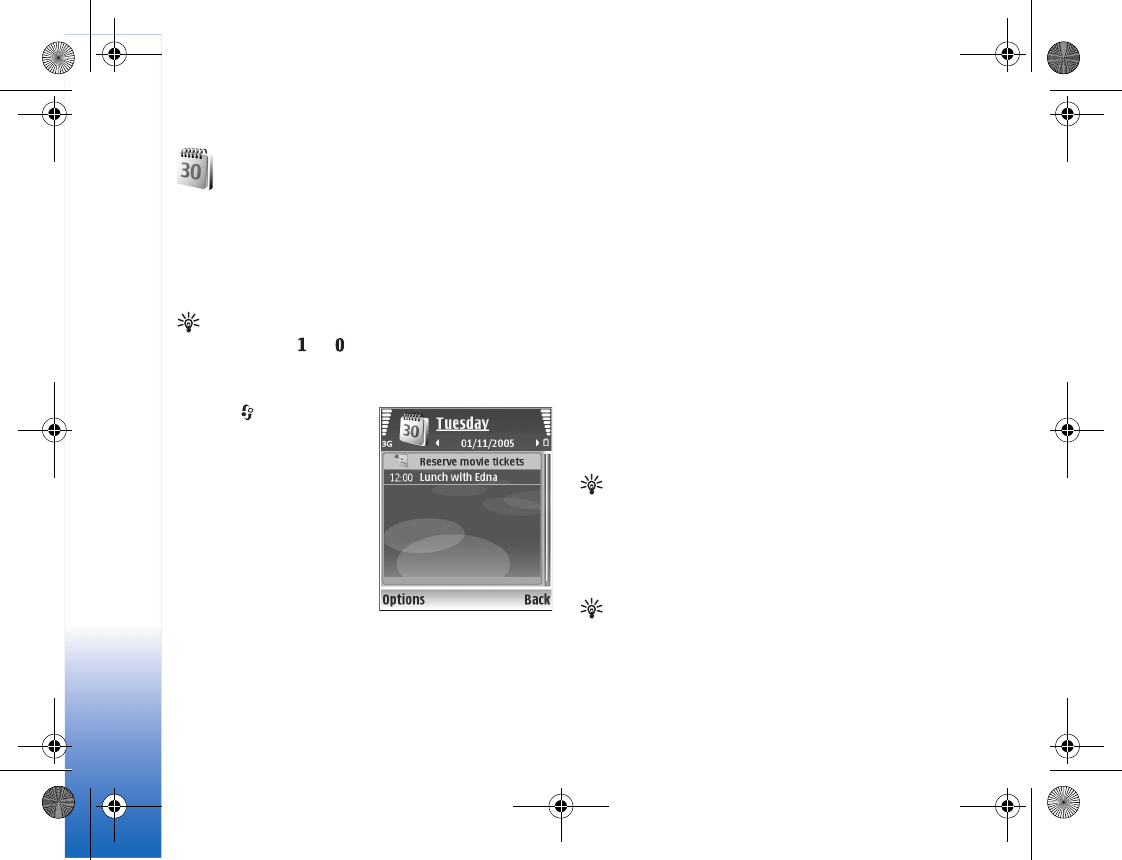
Calendar
82
Calendar
The Calendar reminds you of meetings and anniversaries,
and keeps track of your tasks and other notes.
Create calendar entries
Shortcut: In the day, week, or month calendar view,
press any key ( — ). An appointment entry opens,
and the characters you enter are added to the Subject
field. In the to-do view, a to-do note entry opens.
1Press , and select
Tools > Calendar >
Options > New entry
and one of the following:
Meeting—to remind you
of an appointment that
has a specific date and
time
Memo—to write a
general entry for a day
Anniversary—to remind
you of birthdays or
special dates (entries are repeated every year)
To-do—to remind you of a task that needs doing by a
specific date
2Fill in the fields.
3To set an alarm, select Alarm > On, and enter the
Alarm time and Alarm date.
4To add a description for an appointment or a meeting,
select Options > Add description.
5To save the entry, select Done.
When the calendar alarm sounds, select Silence to turn off
the calendar alarm tone. The reminder text stays on the
screen. To end the calendar alarm, select Stop. To set the
alarm to snooze, select Snooze.
To modify the calendar alarm tone select Options >
Settings > Calendar alarm tone.
Tip! You can synchronize your calendar with a
compatible PC using Nokia PC Suite. When creating a
calendar entry, set the desired Synchronization option.
Calendar views
Tip! Select Options > Settings and Week starts on
or Default view to change the starting day of the week
or the view that is shown when you open the calendar.
In the month view, dates that have calendar entries are
marked with a small triangle in the right bottom corner. In
R1114_en.book Page 82 Thursday, October 19, 2006 3:43 PM
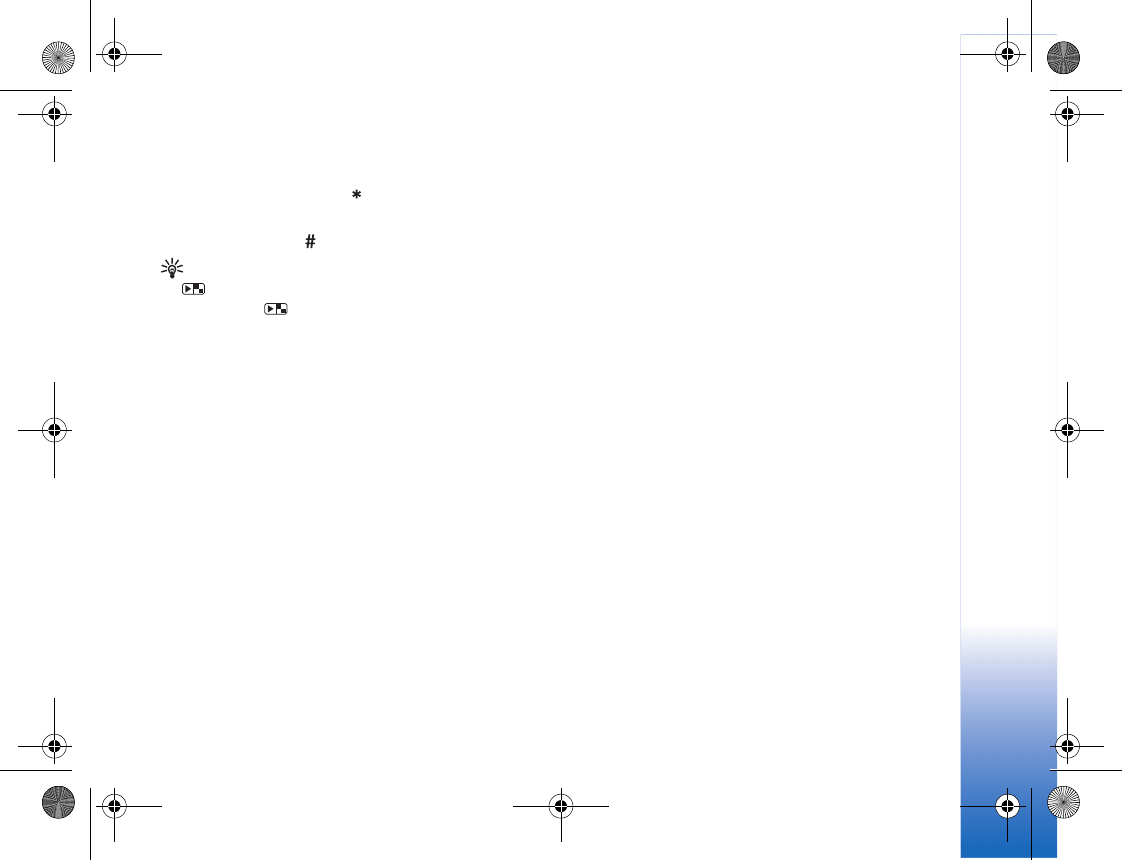
Calendar
83
the week view, memos and anniversaries are placed before
8 a.m. To switch between the month view, week view, day
view, and to-do view, press .
To go to a certain date, select Options > Go to date. To
jump to today, press .
Tip! To see today’s calendar with the fold closed, press
on the side of the device. To return to the idle
mode, press again twice.
To send a calendar entry to a compatible device, select
Options > Send.
To print calendar entries on a compatible Basic Print
Profile (BPP) equipped printer with Bluetooth connectivity
(such as HP Deskjet 450 Mobile Printer or HP Photosmart
8150), select Options > Print.
Manage your calendar entries
Deleting past entries in Calendar saves space in your
device memory.
To delete more than one entry at a time, go to the month
view, and select Options > Delete entry > Before date or
All entries.
To mark a task as completed, scroll to it in the to-do view,
and select Options > Mark as done.
R1114_en.book Page 83 Thursday, October 19, 2006 3:43 PM
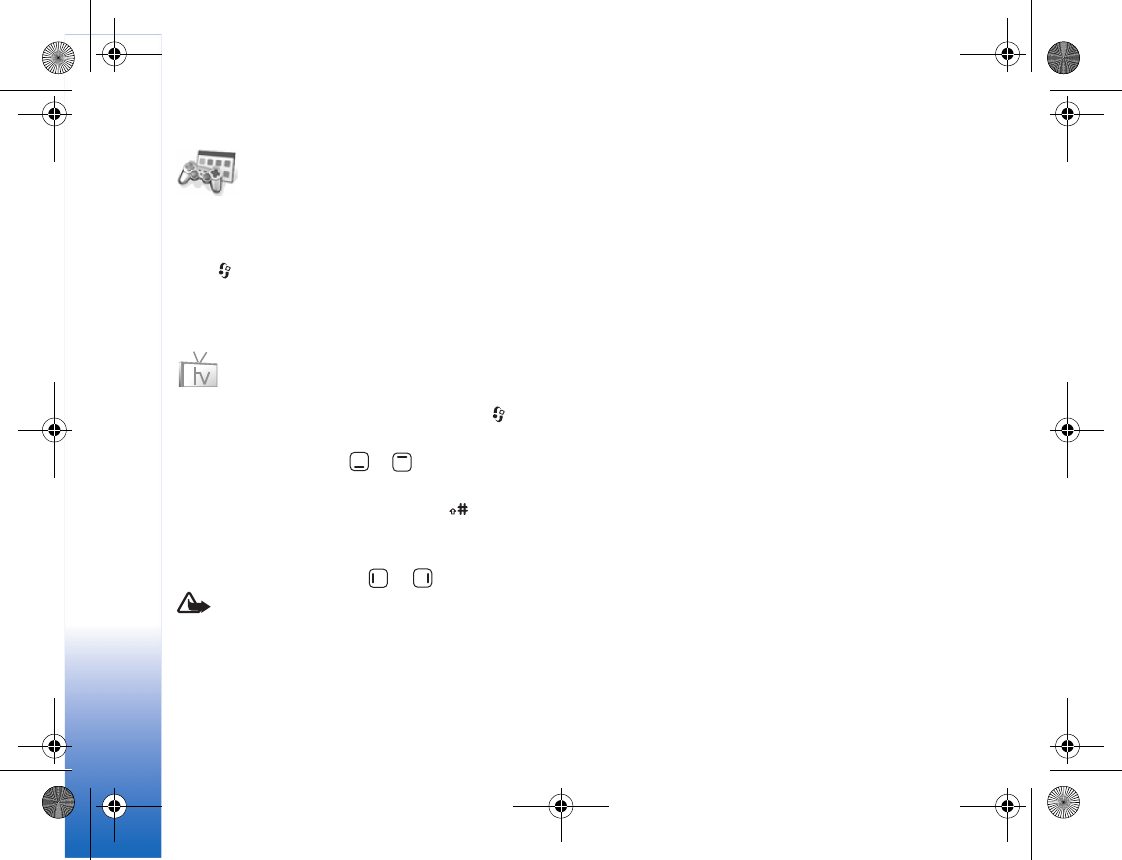
Games&Apps
84
Games&Apps
Games
Press , and select Games&Apps and a game. For
instructions on how to play the game, select Options >
Help.
MobiTV
MobiTV allows you to watch live TV on your
device. To open the application, press , and
select Games&Apps > MobiTV.
To change channels, press or . Pause for a moment
to allow the device to respond.
To enter a channel number directly, press to open the
channel guide, followed by the channel number, and then
press OK.
To change the volume, press or .
Warning: Do not hold the device near your ear when
the loudspeaker is in use, because the volume may be
extremely loud.
For more information, visit www.mobitv.com
R1114_en.book Page 84 Thursday, October 19, 2006 3:43 PM
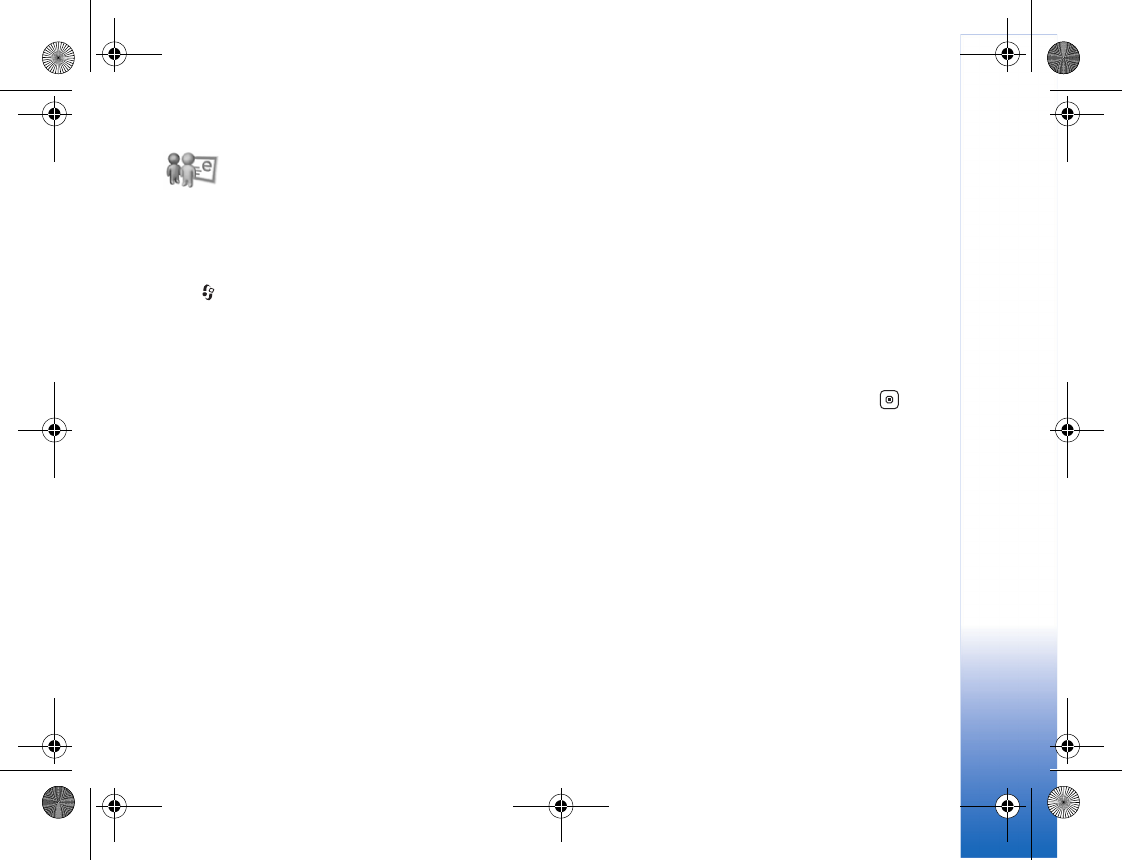
Instant Messaging & Email
85
Instant Messaging & Email
Instant messaging
Press , and select IM & Email > IM.
Instant messaging (IM) (network service) allows you to
converse with other people using instant messages and
join discussion forums (IM groups) with specific topics.
Various service providers maintain instant IM servers that
you can log in to after you register to an IM service. Service
providers may differ in their support of IM features. When
you log into an IM service for the first time, you may be
required to accept the Terms of Use of the service.
Select Conversations to start or continue a conversation
with an IM user; IM contacts to create, edit, or view the
online status of your IM contacts; IM groups to start or
continue a group conversation with multiple IM users; or
Record. chats to view a previous IM session that you
saved.
Receive IM settings
You must save the settings to access the service that you
want to use. You may receive the settings in a special text
message from the network operator or service provider
that offers the IM service. See "Data and settings," p. 61.
You can also enter the settings manually. See "IM server
settings," p. 87.
Connect to an IM server
1To connect to an IM server, select IM >Options >
Login. To change the IM server in use and save new IM
servers, see "IM server settings," p. 87.
2Enter your user ID and password, and press to log
in. You obtain the user ID and password from your
service provider.
3To log out, select Options > Logout.
To log in automatically when you start IM, select
Options > Settings >Server settings > On app. start-
up.
Modify your IM settings
Select Options > Settings > IM settings and from the
following:
Use screen name (shown only if IM groups are supported
by the server)—To enter a nickname, select Yes.
R1114_en.book Page 85 Thursday, October 19, 2006 3:43 PM
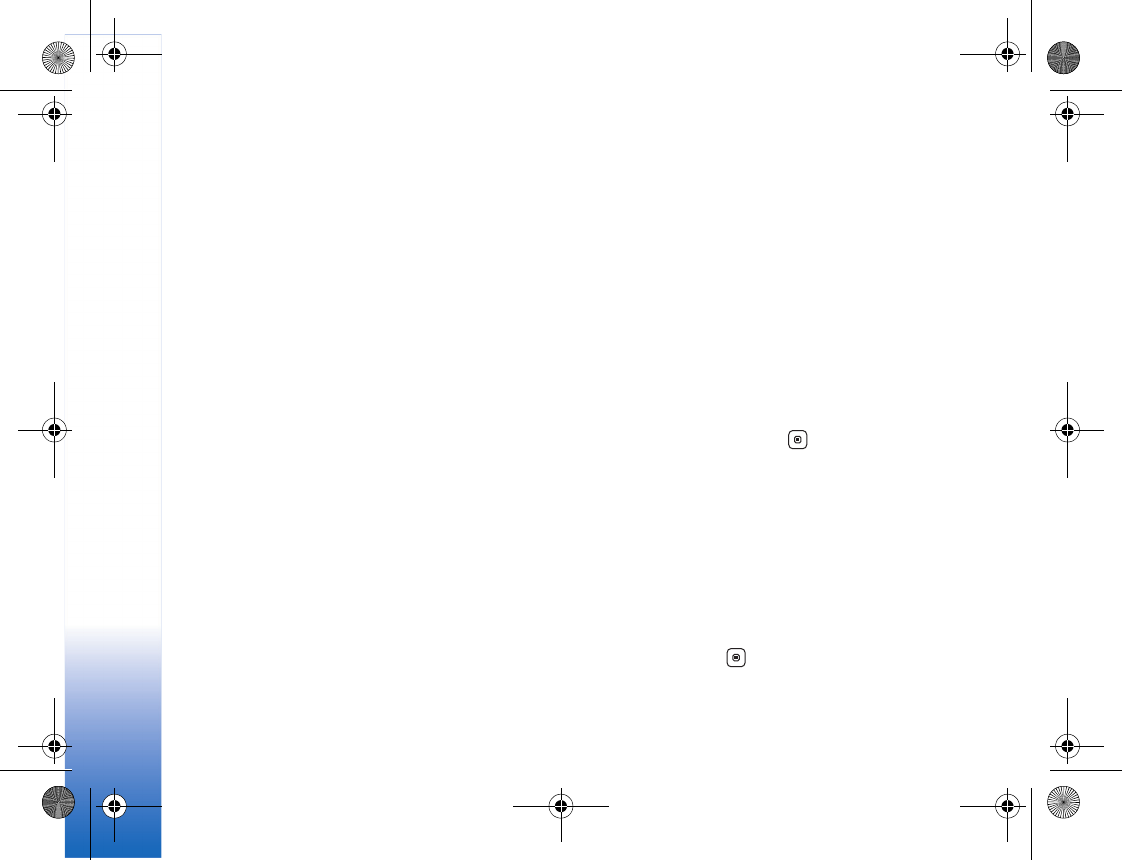
Instant Messaging & Email
86
Show my availability—To allow others to see if you are
online, select To everyone.
Allow messages from—To allow messages from all, select
All.
Allow invitations from—To allow invitations only from
your IM contacts, select IM contacts only. IM invitations
are sent by IM contacts who want you to join their groups.
Msg. scrolling speed—Select the speed at which new
messages are displayed.
Sort IM contacts—Select how your IM contacts are
sorted: Alphabetically or By online status.
Availabil. reloading—To select how to update
information about whether your IM contacts are online or
offline, select Automatic or Manual.
Offline contacts—Select whether IM contacts with an
offline status are shown in the IM contacts list.
Own message color—Select the color of the instant
messages you send.
Received msg color—Select the color of the instant
messages you receive.
IM alert tone—Change the tone played when you receive
a new instant message.
Search for IM groups and users
To search for groups, in the IM groups view, select
Options > Search. You can search by Group name, Topic,
and Members (user ID).
To search for users, in the IM contacts view, select
Options > New IM contact > Search from server. You
can search by User's name, User ID, Phone number, and
E-mail address.
Join IM groups
The IM groups view shows a list of the IM groups that you
have saved or are currently joined to.
To join a saved IM group, press .
To join an IM group that is not on the list, but for which
you know the group ID, select Options > Join new group.
To leave the IM group, select Options > Leave IM group.
Instant messaging
After you join an IM group, you can view the messages that
are exchanged there, and send your own messages.
To send a message, write the message in the message
editor field, and press .
R1114_en.book Page 86 Thursday, October 19, 2006 3:43 PM
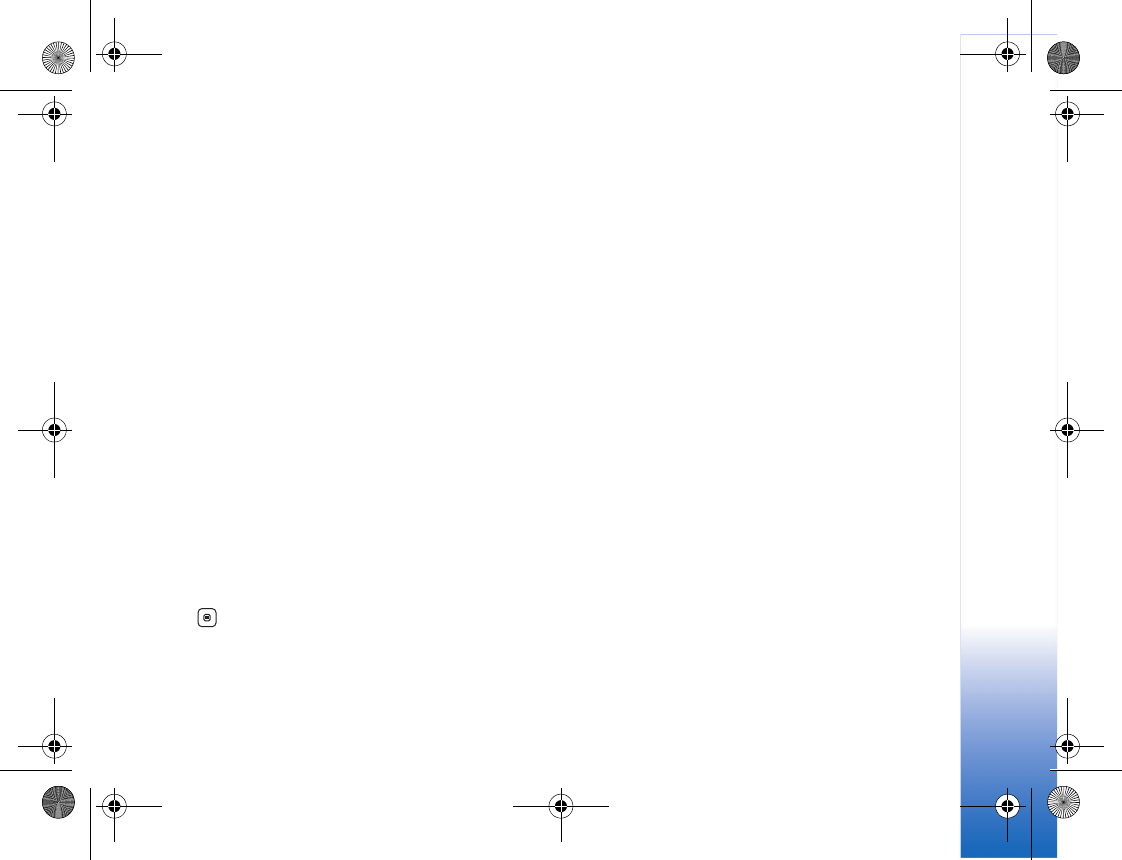
Instant Messaging & Email
87
To send a private message to a participant, select
Options > Send private msg..
To reply to a private message sent to you, select the
message and Options > Reply.
To invite IM contacts who are online to join the IM group,
select Options > Send invitation.
Record chats
To record the messages that are exchanged during a
conversation or while you are joined in a IM group, select
Options > Record chat. To stop recording, select
Options > Stop recording. To view the recorded chats, in
the main view, select Record. chats.
View and start conversations
The Conversations view shows a list of the individual
conversation participants that you have an ongoing
conversation with. Ongoing conversations are
automatically closed when you exit IM.
To view a conversation, select a participant.
To continue the conversation, write your message, and
press .
To return to the conversations list without closing the
conversation, select Back. To close the conversation, select
Options > End conversation.
To start a new conversation, select Options > New
conversation.
To save a conversation participant to your IM contacts,
select Options > Add to IM contacts.
To prevent receiving messages from certain participants,
select Options > Blocking options.
IM contacts
In the IM contacts view, you can retrieve instant
messaging contact lists from the server, or add a new
instant messaging contact to a contact list. When you log
in to the server, the previously used instant messaging
contact list is retrieved from the server automatically.
Select Options > Change own availab. to change the
online status that is shown to other IM users. You can
select a predefined message that shows to other IM users,
or type your own. If you select your status to be Hidden or
Away, no status message is shown to other IM users.
IM server settings
Select Options > Settings > Server settings. You may
receive the settings in a special text message from the
network operator or service provider that offers the
instant messaging service. You obtain the user ID and
password from your service provider when you register to
R1114_en.book Page 87 Thursday, October 19, 2006 3:43 PM

Instant Messaging & Email
88
the service. If you do not know your user ID or password,
contact your service provider.
Servers—View a list of all defined IM servers.
Default server—Change the IM server to which you want
to connect.
IM login type—To log in automatically when you start IM,
select On app. start-up.
To add a new server to your list of IM servers, select
Servers > Options > New server. Enter the following
settings:
Server name—the name for the IM server
Access point in use—the access point you want to use for
the server
Web address—the URL address of the IM server
User ID—your user ID
Password—your login password
Mobile email
Press , and select IM & Email > Mobile email.
Mobile email (network service) allows you to access your
home email. Selected email services allow you to receive
“new mail” alerts with shortcut access to your inbox
enabling you to read, delete, and respond to your email
from your device.
For details of supported email providers and further
information, please contact your service provider.
R1114_en.book Page 88 Thursday, October 19, 2006 3:43 PM
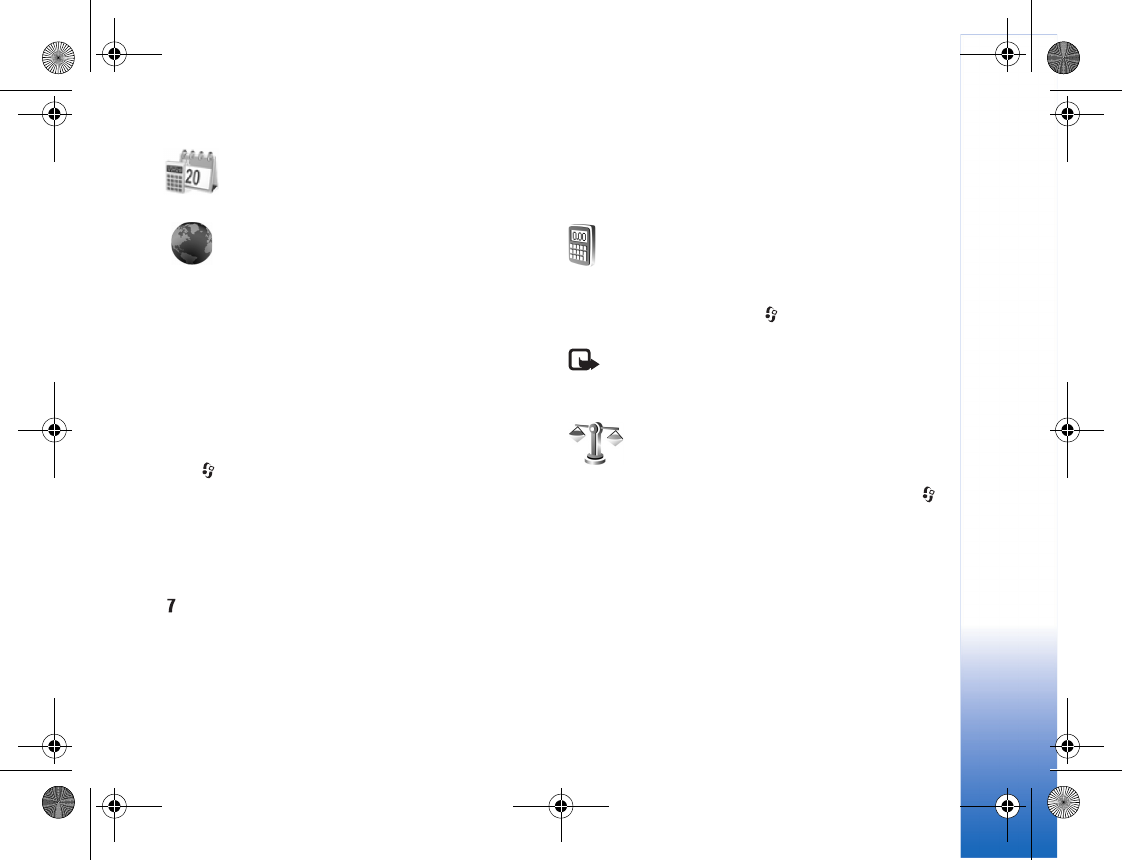
Tools
89
Tools
Web
Various service providers maintain pages specifically
designed for mobile devices. These pages use the wireless
markup language (WML), extensible hypertext markup
language (XHTML), or hypertext markup language (HTML).
Check the availability of services, pricing, and fees with
your network operator or service provider. Service
providers will also give you instructions on how to use their
services.
Press , and select Tools > Web.
With this additional browser, you are able to view normal
Web pages, to zoom in and out on a page (Mini Map), to
view Web pages that contain only text in narrow form so
that text wraps, and to read feeds and blogs.
To turn the Mini Map on or off for the current page, press
. When the Mini Map is on, an overview of the
complete page is shown when you press and hold the scroll
key right, left, up, or down to move on the page.
Calculator
To add, substract, multiply, divide, and calculate square
roots and percentages, press , and select Tools >
Calculator.
Note: This calculator has limited accuracy and is
designed for simple calculations.
Converter
To convert measures from one unit to another, press ,
and select Tools > Converter.
Converter has limited accuracy, and rounding errors may
occur.
1In the Type field, select the measure you want to use.
2In first Unit field, select the unit from which you want
to convert. In the next Unit field, select the unit to
which you want to convert.
R1114_en.book Page 89 Thursday, October 19, 2006 3:43 PM
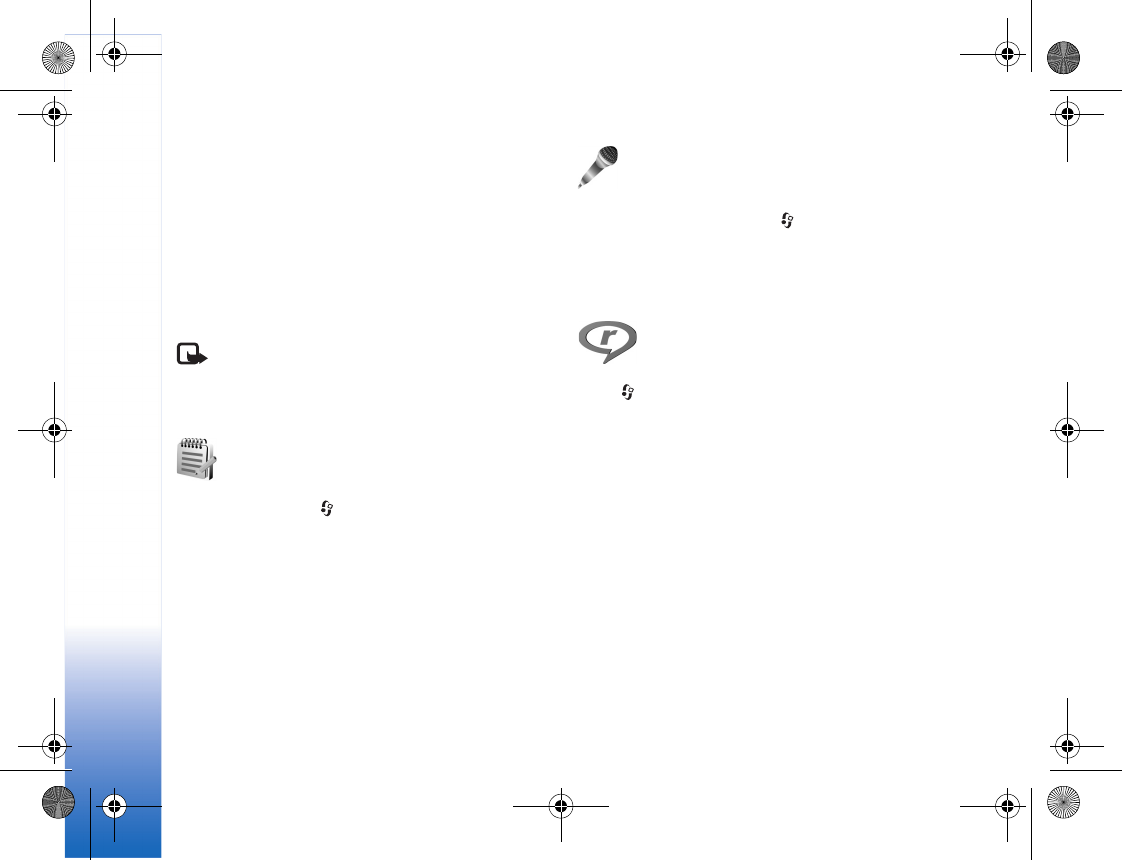
Tools
90
3In the first Amount field, enter the value you want to
convert. The other Amount field changes
automatically to show the converted value.
Set base currency and exchange rates
Select Type > Currency > Options > Currency rates.
Before you can make currency conversions, you must
select a base currency and add exchange rates. The rate of
the base currency is always 1.
Note: When you change base currency, you must
enter new rates because all previously set exchange
rates are set to zero.
Notes
To write notes, press , and select Tools > Notes. You
can send notes to compatible devices, and save plain text
files (.txt format) that you receive to Notes.
To print a note on a compatible Basic Print Profile (BPP)
equipped printer with Bluetooth connectivity (such as HP
Deskjet 450 Mobile Printer or HP Photosmart 8150), select
Options > Print.
Recorder
To record voice memos, press , and select Tools >
Recorder. To record a telephone conversation, select
Recorder during a voice call. Both parties hear a tone every
5 seconds during recording.
RealPlayer
Press , and select Tools > RealPlayer. To play video
clips or stream media files over the air, select RealPlayer.
You can activate a streaming link when you browse Web
pages, or store it in the device memory or a compatible
memory card (if inserted).
RealPlayer supports files with extensions such as .3gp,
.mp4 or .rm. However, RealPlayer does not necessarily
support all file formats or all the variations of file formats.
For example, RealPlayer attempts to open all .mp4 files,
but some .mp4 files may include content that is not
compliant with 3GPP standards and, therefore, is not
supported by this device.
R1114_en.book Page 90 Thursday, October 19, 2006 3:43 PM

Tools
91
Play video clips
1To play a media file stored in device memory or on the
memory card (if inserted), select Options > Open and
from the following:
Most recent clips—to play one of the last six files
played in RealPlayer
Saved clip—to play a file saved in My Stuff.
See "My Stuff," p. 46.
2To play a file, select it.
Tip! To view a video clip in full screen mode, press
. To change back to normal screen mode, press any key.
Shortcuts during play
• To fast forward, press and hold .
• To rewind through the media file, press and hold .
• To mute the audio, press and hold until is
displayed. To turn on the audio, press and hold
until you see .
Stream content over the air
Streaming (network service) content refers to playing
video or audio files directly from the web, without
downloading it to your device first.
Many service providers require you to use an Internet
access point (IAP) for your default access point. Other
service providers allow you to use a WAP access point.
The access points may be configured when you first start
your device.
Contact your service provider for more information.
To stream content over the air, select a streaming link
saved in My Stuff, on a Web page or received in a text
message or multimedia message. Before live content
begins streaming, your device connects to the site and
starts loading the content. The content is not saved in
your device.
Receive RealPlayer settings
You may receive RealPlayer settings in a special text
message from the network operator or service provider.
See "Data and settings," p. 61. For more information,
contact your network operator or service provider.
Change the RealPlayer settings
Select Options > Settings and from the following:
Video—to have RealPlayer automatically repeat video
clips after they finish playing.
Connection—to select whether to use a proxy server,
change the default access point, and set the port range
R1114_en.book Page 91 Thursday, October 19, 2006 3:43 PM
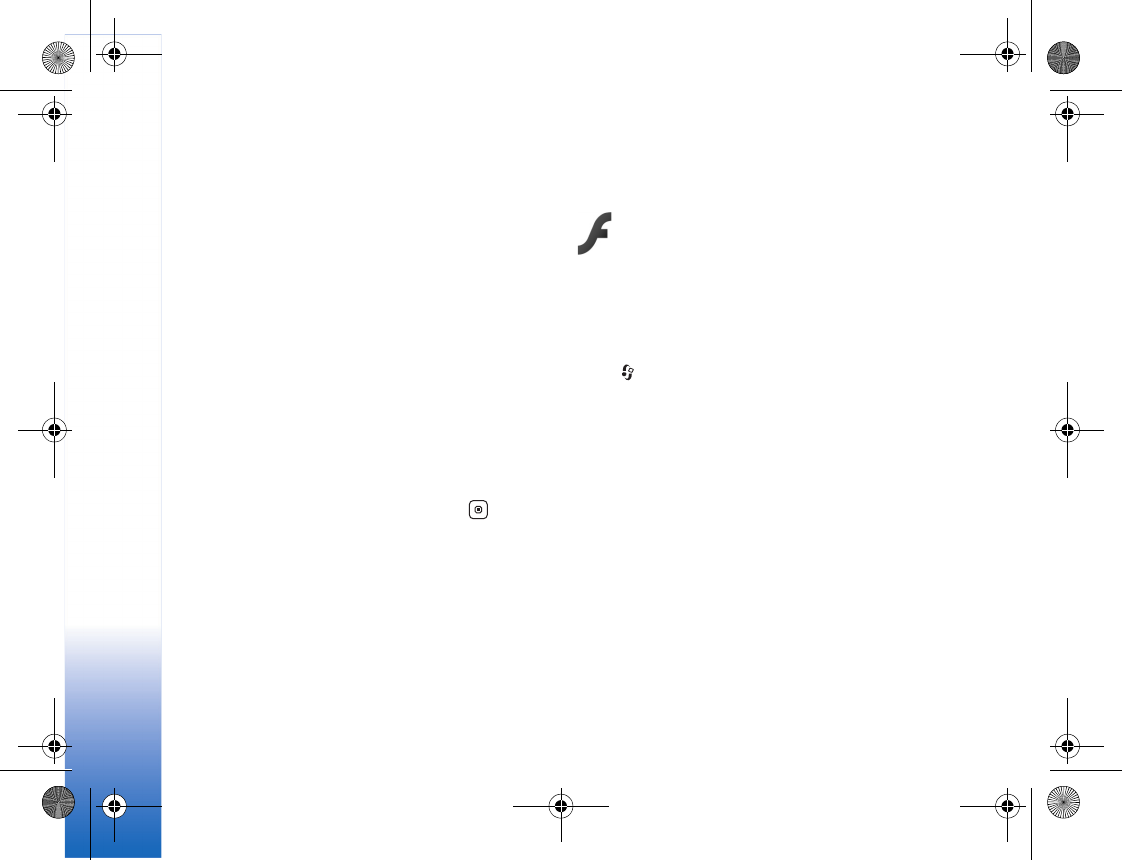
Tools
92
used when connecting. Contact your service provider for
the correct settings.
Select Proxy sett.: and from the following:
Use proxy—To use a proxy server, select Yes.
Proxy serv. address—Enter the IP address of the proxy
server.
Proxy port number—Enter the port number of the proxy
server.
Glossary: Proxy servers are intermediate servers between
media servers and their users. Some service providers
use them to provide additional security or speed up
access to browser pages that contain audio or video
clips.
Select Netw. sett.: and from the following:
Default access point—Scroll to the access point you want
to use to connect to the Internet, and press .
Online time—Set the time for RealPlayer to disconnect
from the network when you pause a media clip playing
through a network link. Select User defined. Enter the
time, and select OK.
Lowest UDP port—Enter the lowest port number of the
server’s port range. The minimum value is 1024.
Highest UDP port—Enter the highest port number of the
server’s port range. The maximum value is 65535.
Select Options > Advanced settings to edit the
bandwidth values for different networks.
Flash Player
With Flash Player, you can view, play, and
interact with compatible flash files made for
mobile devices.
Play flash files
Press , and select Tools > Flash Player and a flash file.
If available, select Options and from the following:
Pause—to pause the playback
Stop—to stop the playback
Volume—to adjust the playback volume. To increase or
decrease the volume scroll left or right.
Quality—to select the playback quality.
If the playback appears uneven and slow, change the
Quality setting to Normal or Low.
Full screen—to play the file using the entire display. To
return to the normal screen, select Normal screen.
Even though the key functions are not visible in full screen,
they may still be available when you press either selection
key.
R1114_en.book Page 92 Thursday, October 19, 2006 3:43 PM

Tools
93
Fit to screen—to play the file in its original size after
zooming it
Pan mode on—to be able to scroll around the display when
you have zoomed in
Organize flash files
Press , and select Tools > Flash Player. Scroll right.
To open a folder or play a flash file, select it.
To send a flash file to a compatible device, scroll to it, and
press the call key.
To copy or move a flash file to another folder, scroll to it,
and select Options > Organize > Copy to folder or Move
to folder.
To create a folder to organize your flash files, select
Options > Organize > New folder.
The available options may vary.
To delete a flash file, scroll to it, and press .
Radio
Press , and select Tools > Radio.
You can listen to the FM radio while using other
applications.
If you do not have access to the radio service, the
operators and radio stations in your area may not support
radio. The radio service may not be available in all areas
and countries.
You can normally make a call or answer an incoming call
while listening to the radio. The radio is muted when there
is an active call.
The radio selects the used frequency band based on the
country information received from the network. If this
information is not available, you may be asked to select
the region you are located in, or you can select the region
in the Radio settings. See "Settings," p. 94.
Listen to the radio
Note that the quality of the radio broadcast depends on
the coverage of the radio station in that particular area.
The FM radio depends on an antenna other than the
wireless device antenna. A compatible headset or
enhancement needs to be attached to the device for the
FM radio to function properly.
Press , and select Tools > Radio. To start a station
search, select or . To change the frequency
manually, select Options > Manual tuning.
R1114_en.book Page 93 Thursday, October 19, 2006 3:43 PM

Tools
94
If you have previously saved radio stations, select or
to go to the previous or next saved station, or press
the corresponding number key to select the memory
location of a station.
To adjust the volume, press . To listen to the radio
using the loudspeakers, select Options > Activate
loudspeaker.
Warning: Listen to music at a moderate level.
Continuous exposure to high volume may damage your
hearing. Do not hold the device near your ear when the
loudspeaker is in use, because the volume may be
extremely loud.
To save the current tuned station to your station list,
select Options > Save station. To open the list of your
saved stations, select Options > Stations.
To return to the idle mode and leave the FM radio playing
in the background, select Options > Play in background.
Saved stations
You can save up to 20 radio stations in the radio. To open
your station list, select Options > Stations.
To listen to a saved station, select Options > Station >
Listen.
To change station details, select Options > Station >
Edit.
Settings
Select Options > Settings and from the following:
Start-up tone—Select whether a tone is played when the
application is started.
Current region—Select the region you are currently
located in. This setting is displayed only if there was no
network coverage when the application was started.
R1114_en.book Page 94 Thursday, October 19, 2006 3:43 PM
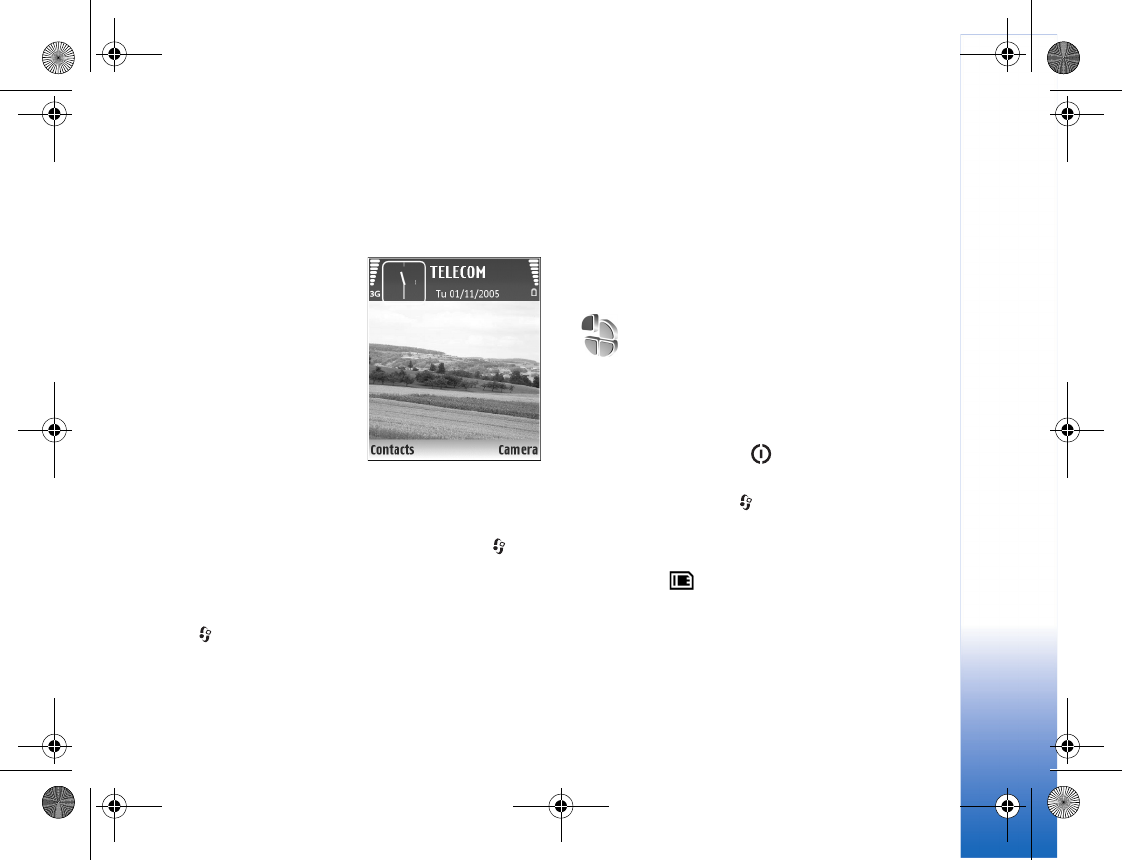
Personalize your device
95
Personalize your device
To use the idle display for fast access to your most
frequently used applications, see "Active idle mode," p. 97.
To change the idle mode
background image or what is
shown in the screen saver,
see "Change the look of your
device," p. 97.
To personalize the ringing
tones, see "Profiles—set
tones," p. 95 and "Add ringing
tones for addresses," p. 70.
To change the shortcuts
assigned for the different
presses of the scroll key and left and right selection keys in
the idle mode, see "Idle screen mode," p. 99.
To change the clock shown in the idle mode, press , and
select Tools > Clock > Options > Settings > Clock type >
Analog or Digital.
To change the welcome note to an image or animation,
press , and select Settings > Config. > Phone >
General > Welcome note / logo.
To change the main menu view, in the main menu, select
Options > Change view > Grid or List.
To rearrange the main menu, in the main menu, select
Options > Move, Move to folder, or New folder. You can
move less used applications into folders, and place
applications that you use more often into the main menu.
Profiles—set tones
Profiles let you personalize the ringing tones, message
alert tones, and other tones for different events,
environments, or caller groups.
To change the profile, press in the idle mode. Scroll to
the profile you want to activate, and select OK.
To modify a profile, press , and select Settings >
Profiles. Scroll to the profile, and select Options >
Customize. To open the choices, select the setting you
want to change. Tones stored on the memory card are
indicated with . You can scroll through the tone list
and listen to each one before you make your selection. To
stop the tone, press any key.
When you choose a tone, Tone downloads (network
service) opens a list of bookmarks. You can select a
R1114_en.book Page 95 Thursday, October 19, 2006 3:43 PM
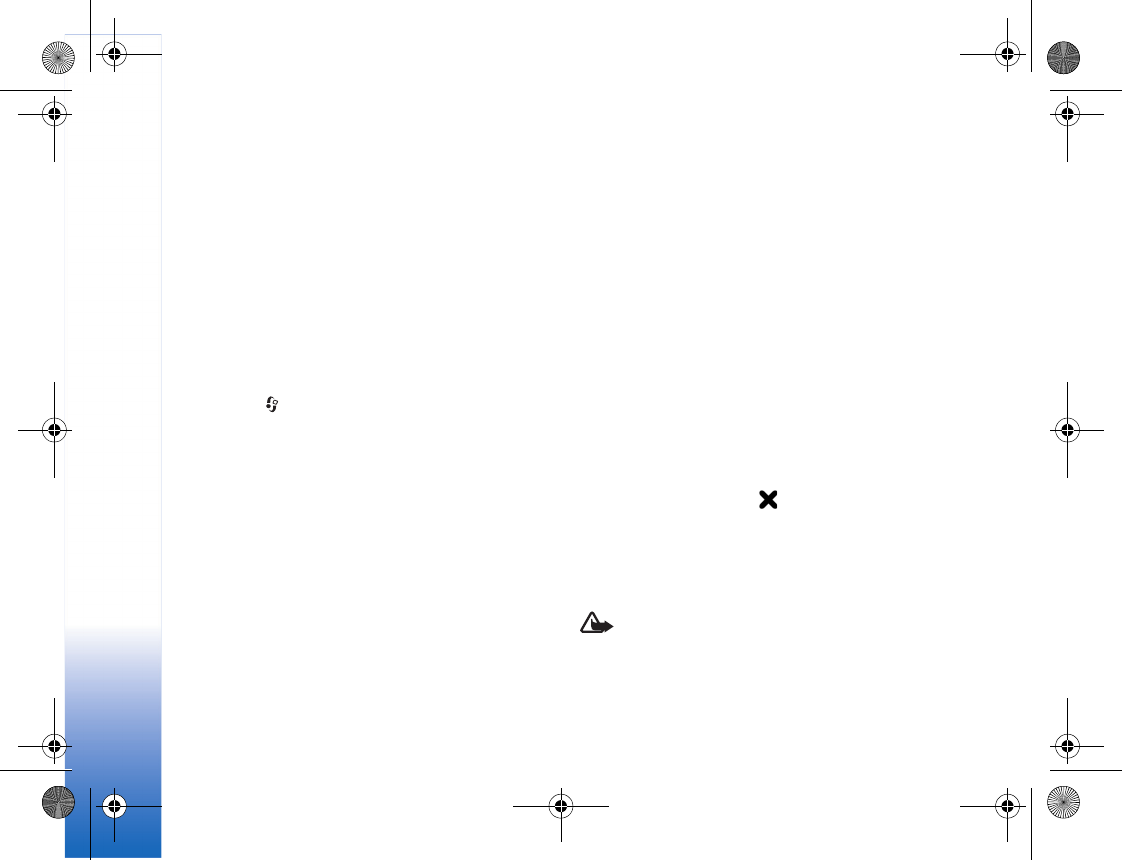
Personalize your device
96
bookmark and start connection to a Web page to
download tones.
If you want the caller’s name to be said when your device
rings, select Options > Customize, and set Say caller's
name to On. The caller’s name must be saved in Addr.
Book.
To create a new profile, select Options > Create new.
3-D tones
3-D tones enable three-dimensional sound effects for
your ringing tones (not all ringing tones support 3-D
tones). Press , and select Settings > 3-D tones.
To enable 3-D tones for all your ringing tones, select 3-D
ringing tones > On.
To change the three-dimensional effect for a ringing tone,
do the following:
1Select Ringing tone and the ringing tone you want to
change.
2Select Sound trajectory and from the following
settings:
Trajectory speed—Scroll left or right to adjust the
speed at which sound moves from one direction to
another. This setting is not available for all ringing
tones.
Doppler effect—Select On if you want the ringing tone
to appear to change as you get closer to the device, or
further away from it. The ringing tone appears to
become higher as you get closer to the device, and to
become lower as you get further away. This setting is
not available for all ringing tones.
Reverberation—Select the reverb type.
To listen to the ringing tone with the three-dimensional
effect, select Options > Play tone. To listen to 3-D tones,
use the stereo loudspeakers on your device, or a stereo
headset.
Offline profile
The Offline profile lets you use the device without
connecting to the wireless network. When you activate the
Offline profile, the connection to the wireless network is
turned off, as indicated by in the signal strength
indicator area. All wireless RF signals to and from the
device are prevented. If you try to send messages, they are
placed in the outbox to be sent later. If a Bluetooth
connectivity is activated before entering the Offline
profile, it will be deactivated.
Warning: In the Offline profile you cannot make (or
receive) any calls, except make calls to certain
emergency numbers, or use other features that require
network coverage. To make calls, you must first activate
R1114_en.book Page 96 Thursday, October 19, 2006 3:43 PM
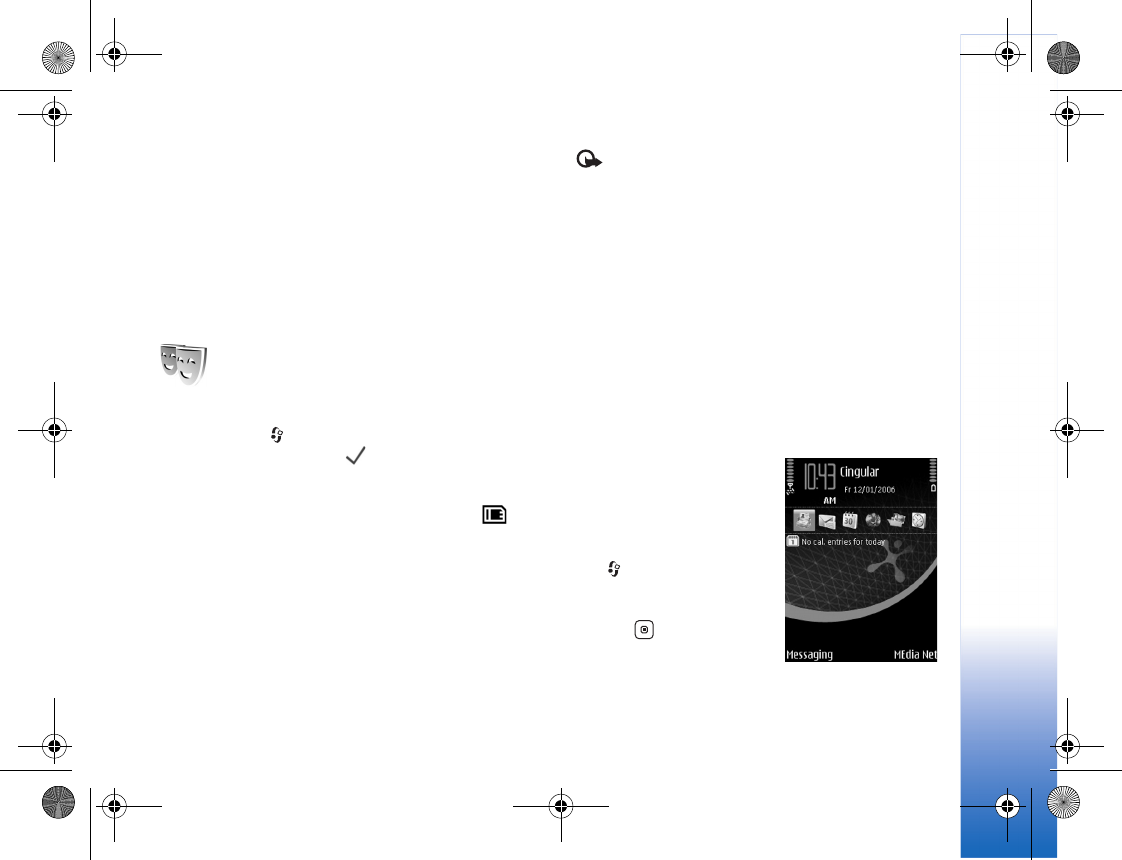
Personalize your device
97
the phone function by changing profiles. If the device
has been locked, enter the lock code.
To leave the Offline profile, press the power key, and select
another profile. The device re-enables wireless
transmissions (providing there is sufficient signal
strength). If a Bluetooth connectivity was activated before
entering the Offline profile, it is automatically reactivated
after leaving the Offline profile. See "Config.," p. 99.
Change the look of your
device
To change the look of the display, such as the wallpaper
and icons, press , and select Settings > Themes. The
active theme is indicated by . In Themes you can group
together elements from other themes or select images
from My Stuff to personalize themes further. The themes
on the memory card (if inserted) are indicated by . The
themes on the memory card are not available if the
memory card is not inserted in the device. If you want to
use the themes saved in the memory card without the
memory card, save the themes in the device memory first.
To open a browser connection and download more themes,
select Theme downloads (network service).
Important: Use only services that you trust and that
offer adequate security and protection against harmful
software.
To activate a theme, scroll to it, and select Options >
Apply. To preview a theme before activating it, select
Options > Preview.
To edit themes, scroll to a theme, and select Options >
Edit to change the Wallpaper and Power saver settings.
To restore the selected theme to its original settings,
select Options > Restore orig. theme when you edit a
theme.
Active idle mode
Use your idle display for fast
access to your most
frequently used applications.
By default, the active idle
mode is off.
Press , select Settings >
Config. > Phone > Idle
screen mode > Active idle,
and press to switch the
active idle on or off.
The active idle display is
shown with default applications across the top of the
R1114_en.book Page 97 Thursday, October 19, 2006 3:43 PM
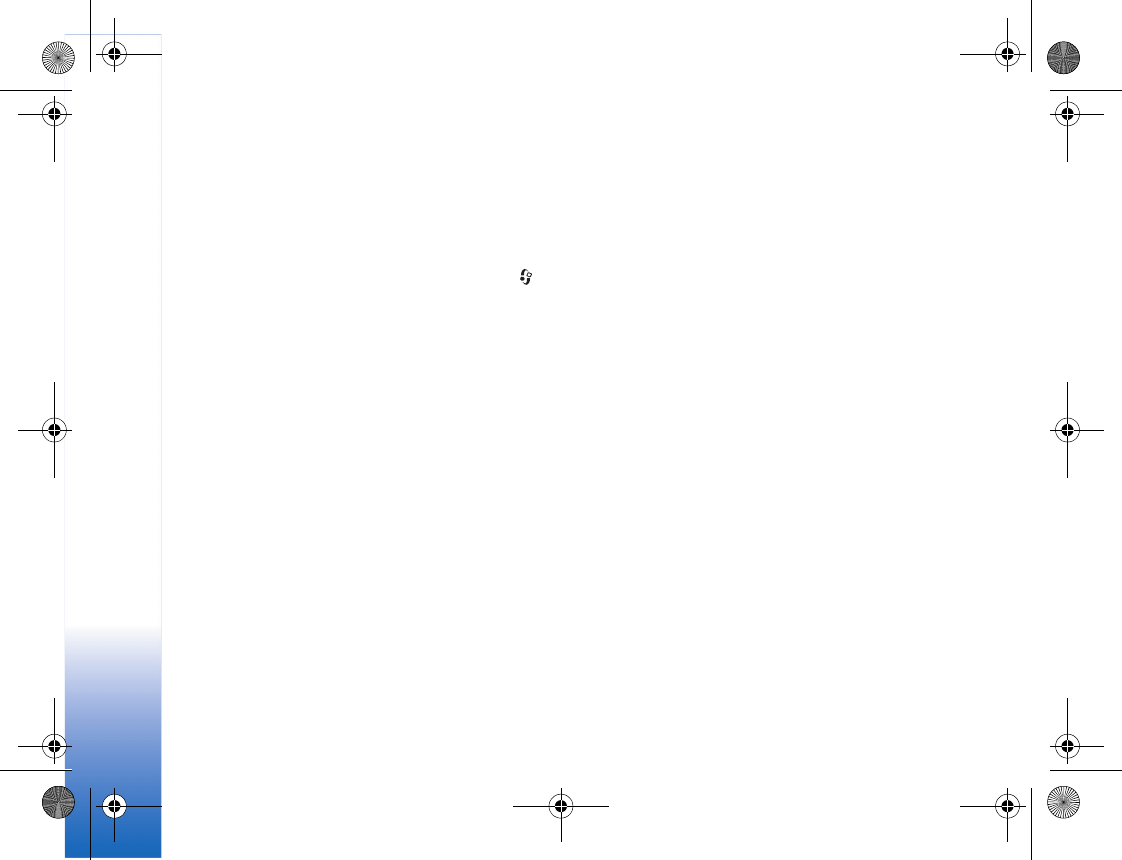
Personalize your device
98
screen, and calendar, to-do, and player events listed
below.
Select an application or event.
The standard scroll key shortcuts available in the idle
mode cannot be used when the active idle mode is on.
To change the default applications shortcuts, press ,
select Settings > Config. > Phone > Idle screen mode >
Active idle apps.
Some shortcuts may be fixed, and you are not able to
change them.
R1114_en.book Page 98 Thursday, October 19, 2006 3:43 PM
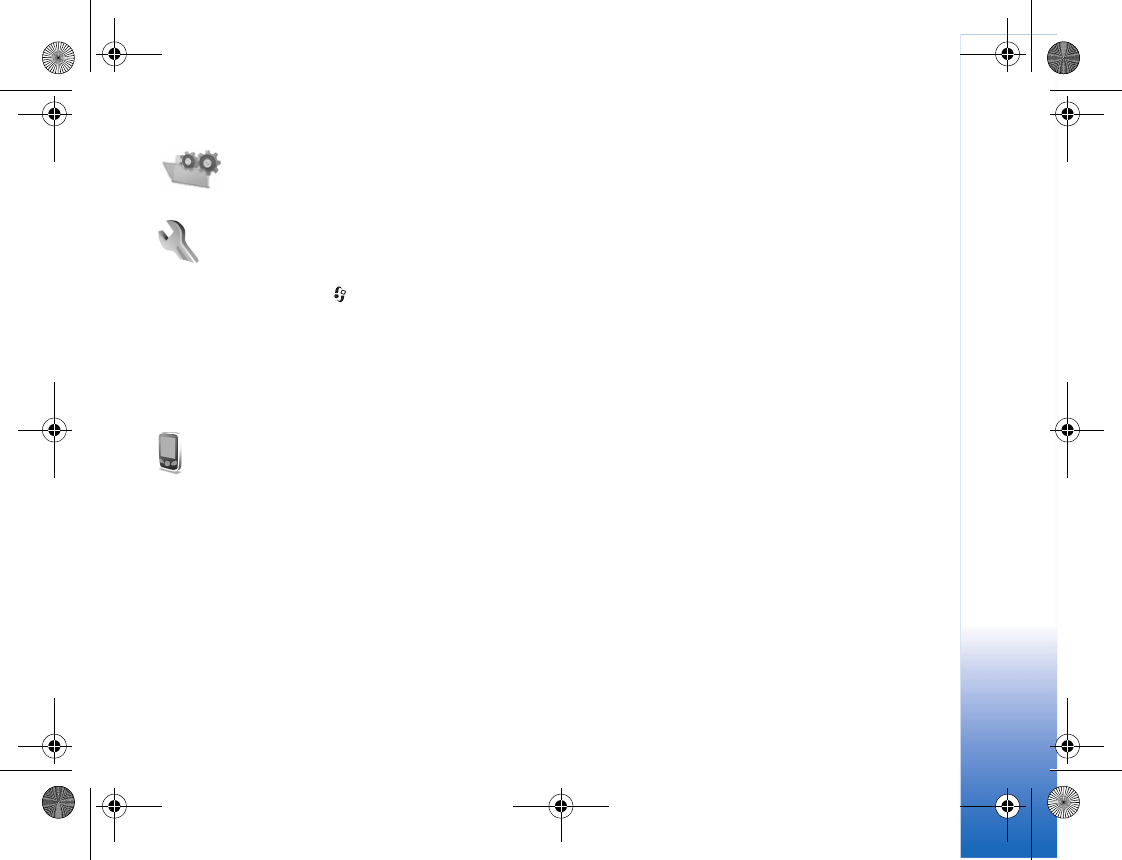
Settings
99
Settings
Config.
To change settings, press , and select Settings >
Config.. and a settings group. Select a setting you want to
change.
Some settings may be preset for the device by your
network operator or service provider, and you may not be
able to change them.
Phone
General
Phone language—Changing the language of the display
texts in your device also affects the format used for date
and time and the separators used, for example, in
calculations. Automatic selects the language according to
the information on your SmartChip card. After you change
the display text language, the device restarts.
Changing the settings for Phone language or Writing
language affects every application in your device, and the
change remains effective until you change these settings
again.
Writing language—Changing the language affects the
characters and special characters available when writing
text and the predictive text dictionary used.
Predictive text—Set the predictive text input On or Off
for all editors in the device. The predictive text dictionary
is not available for all languages.
Welcome note / logo—The welcome note or logo is
displayed briefly each time you switch on the device.
Select Default to use the default image, Text to write a
welcome note, or Image to select an image from My
Stuff.
Reset phone settings—You can reset some of the settings
to their original values. To do this, you need the lock code.
See "Phone and SmartChip," p. 104. After resetting, the
device may take a longer time to power on. Documents
and files are unaffected.
Idle screen mode
Active idle—Use shortcuts to applications in the idle
mode. See "Active idle mode," p. 97.
R1114_en.book Page 99 Thursday, October 19, 2006 3:43 PM
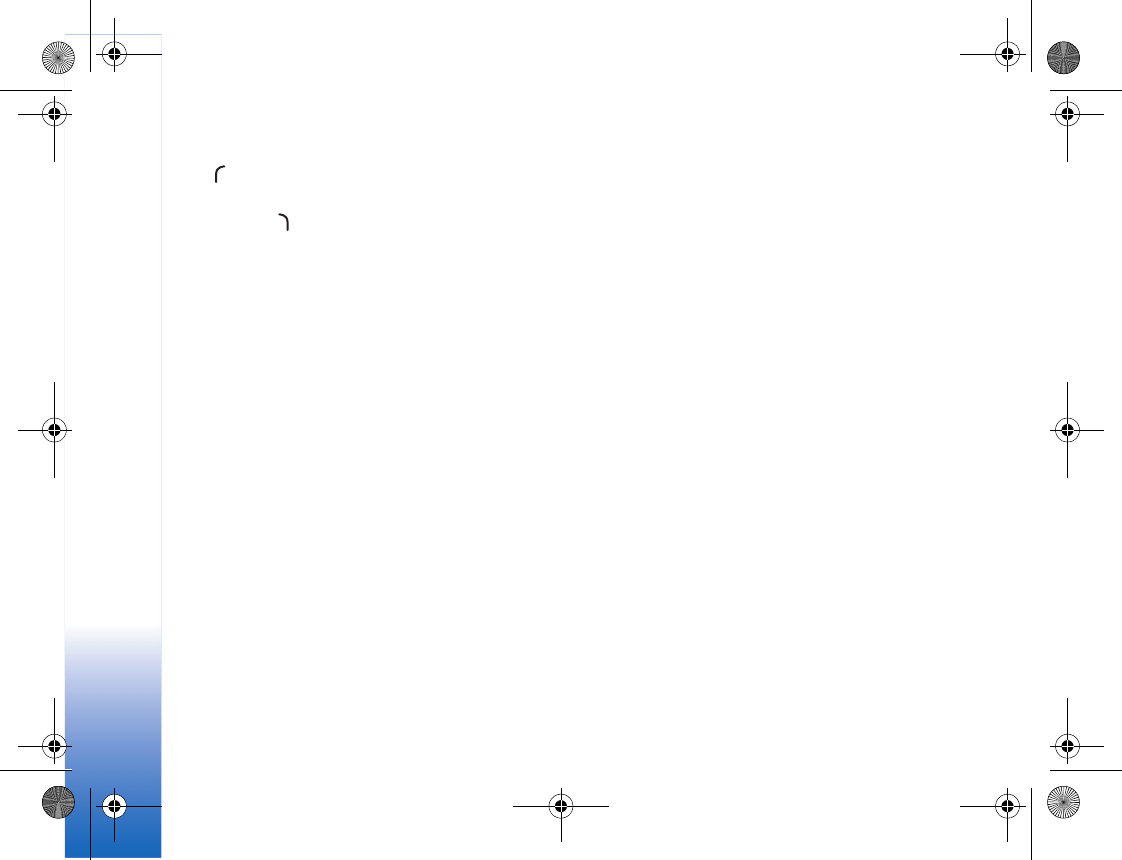
Settings
100
Left selection key—Assign a shortcut to the left selection
key ( ) in the idle mode.
Right selection key—Assign a shortcut to the right
selection key ( ) in the idle mode.
Active idle apps—Select the application shortcuts you
want to appear in the active idle. This setting is only
available if Active idle is on.
You can also assign keypad shortcuts for the different
presses of the scroll key. The scroll key shortcuts are not
available if the active idle is on.
Operator logo—This setting is only available if you have
received and saved an operator logo. Select Off if you do
not want the logo to be shown.
Display
Light sensor—Adjust the basic brightness level of the
display to lighter or darker. However, in extreme light
conditions, the brightness of the display is automatically
adjusted.
Power saver time-out—Select the time-out period after
which the power saver and the cover display screen saver
(if selected) is activated.
Light time-out—Select a time-out after which the
backlight of the display is switched off.
Cover display
Personalization—Select from the following:
•Wallpaper—Select the background image displayed on
the cover display in the idle mode.
•Screen saver—Select an image or animation to use as
screen saver on the cover display, and the duration it is
shown.
When you select an image to use as wallpaper or screen
saver, a cropping frame the size of the cover display is
shown on top of the image. You can zoom and rotate
the area of the image. Scroll to move the frame around
the display. To use the area inside the frame, select
Options > Set as wallpaper or Set as screen saver.
You cannot use a copyright-protected image as
wallpaper or screen saver.
•Closing animation—Select a short animation to play
when you close the cover.
•Closing tone—Select a short tune to play when you
close the cover.
•Opening tone—Select a short tune to play when you
open the cover and the device is in the idle mode.
Brightness—Close the fold, and use the volume key to
adjust the brightness on the cover display.
Answer if fold opened—Select Yes if you want to answer
incoming calls by opening the fold.
R1114_en.book Page 100 Thursday, October 19, 2006 3:43 PM

Settings
101
Sleep mode—Select whether the display is switched off to
save battery power. If the screen saver is turned off, the
cover display switches off after 1 minute. If the screen
saver is turned on, the cover display switches off at the end
of the screen saver period (1-15 minutes).
Call config.
Send my caller ID—To set your phone number to be
displayed or hidden from the person to whom you are
calling, select Yes or No. The value may be set by your
network operator or service provider when you make a
subscription (Set by network) (network service).
Call waiting—Activate this setting if you want the network
to notify you of a new incoming call while you have a call
in progress. To set the function on or off, select Activate
or Cancel. To check whether the function is activated,
select Check status.
Reject call with SMS—Select Yes to send a text message
to a caller informing why you could not answer the call.
See "Answer or decline a call," p. 74.
Message text—Write a text to be sent in a text message
when you decline a call.
Automatic redial—Select On, and your device makes a
maximum of 10 attempts to connect the call after an
unsuccessful call attempt. To stop automatic redialing,
press .
Summary after call—Activate this setting if you want the
device to briefly display the approximate duration of the
last call.
1-touch dialing—Select On. To dial the numbers assigned
to the speed dialing keys ( — ), press and hold the
key. See also "1-touch dial a phone number," p. 73.
Anykey answer—Select On. To answer an incoming call,
briefly press any key, except , , , and .
Line in use—This setting (network service) is shown only
if the SmartChip card supports two subscriber numbers,
that is, two phone lines. Select which phone line you want
to use for making calls and sending text messages. Calls
on both lines can be answered irrespective of the selected
line. If you select Line 2 and have not subscribed to this
network service, you will not be able to make calls. When
line 2 is selected, is shown in the idle mode.
Tip! To switch between the phone lines, press and
hold in the idle mode.
Line change—To prevent line selection (network service),
select Disable if supported by your SmartChip card. To
change this setting, you need the PIN2 code.
R1114_en.book Page 101 Thursday, October 19, 2006 3:43 PM
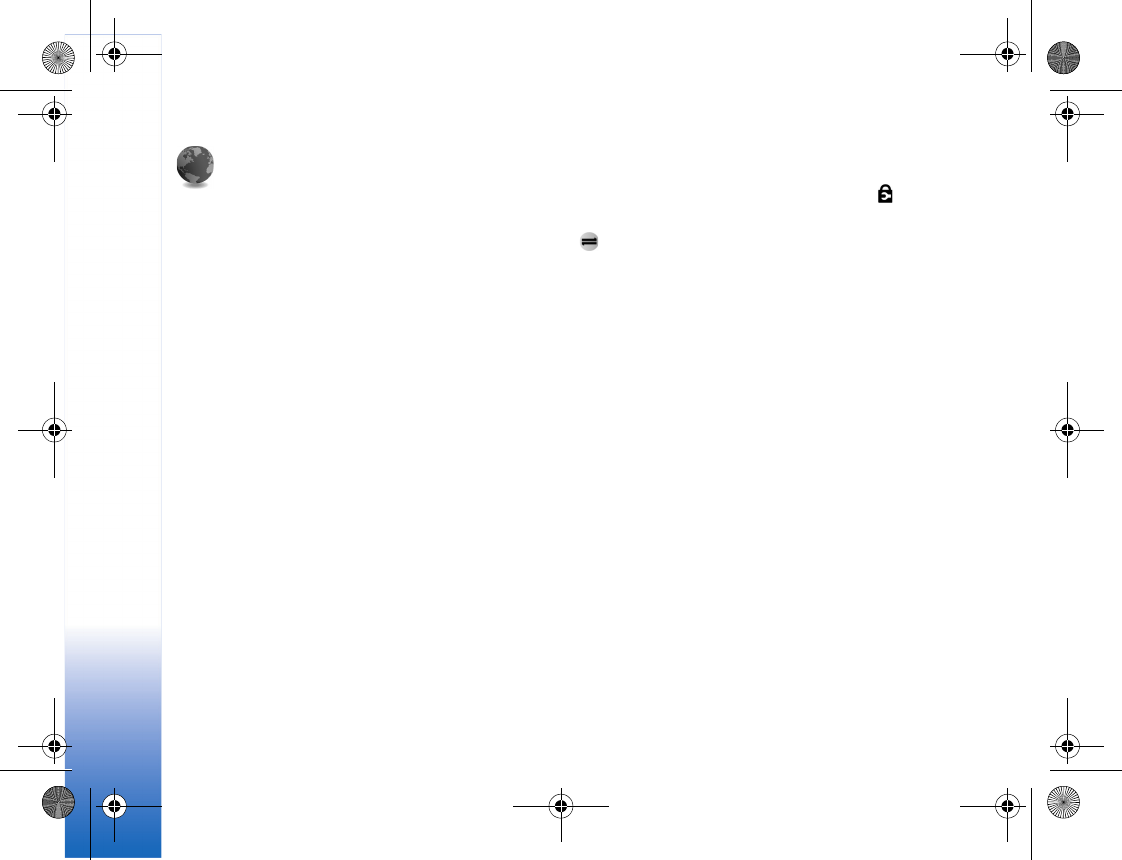
Settings
102
Connection
Data connections and access points
Your device supports packet data connections (network
service), such as GPRS in the GSM network. When you use
your device in GSM and UMTS networks, multiple data
connections can be active at the same time, and access
points can share a data connection. In the UMTS network,
data connections remain active during voice calls.
To establish a data connection, an access point is required.
You can define different kinds of access points:
• MMS access point to send and receive multimedia
messages
• Access point for the Web application to view WML or
XHTML pages
• Internet access point (IAP) to send and receive e-mail
and connect to the Internet
Check the type of access point you need with your service
provider for the service you want to access. For availability
and subscription to packet data connection services,
contact your network operator or service provider.
Access points
You may receive access point settings in a message from
a service provider. See "Data and settings," p. 61. Some or
all access points may be preset for your device by your
service provider or network operator, and you may not be
able to change, create, edit, or remove them. indicates
a protected access point.
indicates a packet data access point.
To create a new access point, select Options > New access
point. To edit the settings of an access point, select
Options > Edit. Follow the instructions from your service
provider.
Connection name—Enter a descriptive name for the
connection.
Data bearer—Select the data connection type.
Depending on the data connection you select, only certain
setting fields are available. Fill in all fields marked with
Must be defined or with a red asterisk. Other fields can be
left empty, unless you have been instructed otherwise by
your service provider.
To be able to use a data connection, the network service
provider must support this feature, and if necessary,
activate it for your SmartChip card.
Packet data
Follow the instructions from your service provider.
Access point name—You obtain the access point name
from your network operator or service provider.
R1114_en.book Page 102 Thursday, October 19, 2006 3:43 PM
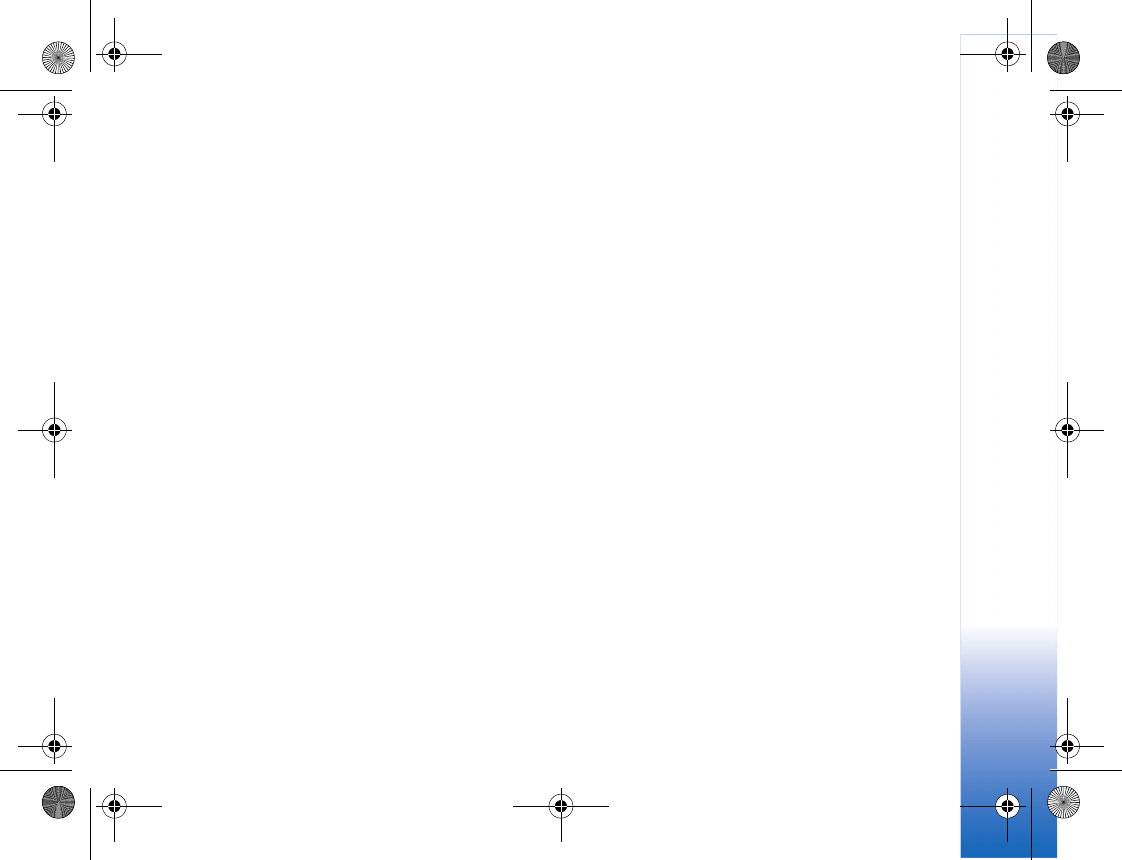
Settings
103
User name—The user name may be needed to make a data
connection, and is usually provided by the service provider.
Prompt password—If you must enter the password every
time you log in to a server, or if you do not want to save
your password in the device, select Yes.
Password—A password may be needed to make a data
connection, and is usually provided by the service provider.
Authentication—Select Normal or Secure.
Homepage—Depending on the access point you are setting
up, enter the Web address or the address of the multimedia
messaging center.
Select Options > Advanced config. to change the
following settings:
Network type—Select the Internet protocol type to use.
IPv4 settings or IPv6 settings. The other settings depend
on the selected network type.
Phone IP address (for IPv4 only)—Enter the IP address of
your device.
DNS address—In Primary DNS address, enter the IP
address of the primary DNS server. In Secondary DNS
addr., enter the IP address of the secondary DNS server.
Contact your Internet service provider to obtain these
addresses.
Proxy serv. address—Define the address for the proxy
server.
Proxy port number—Enter the proxy port number.
Packet data
The packet data settings affect all access points using a
packet data connection.
Packet data conn.—If you select When available and you
are in a network that supports packet data, the device
registers to the packet data network. Starting an active
packet data connection (for example, to send and receive
e-mail) is quicker. If there is no packet data coverage, the
device periodically tries to establish a packet data
connection. If you select When needed, the device uses a
packet data connection only if you start an application or
action that needs it.
Access point—The access point name is needed to use
your device as a packet data modem to your computer.
SIP settings
SIP (session initiation protocol) settings are needed for
certain network services using SIP. You may receive the
settings in a special text message from your network
operator or service provider. You can view, delete, or
create these setting profiles in SIP settings.
R1114_en.book Page 103 Thursday, October 19, 2006 3:43 PM

Settings
104
Configurations
You may receive trusted server settings from your network
operator or service provider in a configuration message, or
the settings may be stored on your USIM. You can save
these settings to your device, view, or delete them in
Configs..
Date and time
See "Clock settings," p. 21, and language settings in
"General," p. 99.
Security
Phone and SmartChip
PIN code request—When active, the code is requested
each time the device is switched on. Deactivating the
personal identification number (PIN) code request may
not be allowed by some SmartChip cards. See "Glossary of
PIN and lock codes," p. 105.
PIN code, PIN2 code, and Lock code—You can change the
lock code, PIN code, and PIN2 code. These codes can only
include the numbers from 0 to 9. If you forget any of
these codes, contact your service provider. See "Glossary of
PIN and lock codes," p. 105.
Avoid using access codes similar to the emergency
numbers to prevent accidental dialing of the emergency
number.
Autolock period—You can set an autolock period, a
time-out after which the device automatically locks. To
turn off the autolock period, select None.
To unlock the device, enter the lock code.
When the device is locked, calls still may be possible to the
official emergency number programmed into your device.
Tip! To lock the device manually, press . A list of
commands opens. Select Lock phone.
Lock if SChip changed—You can set the device to ask for
the lock code when an unknown SmartChip is inserted into
your device. The device maintains a list of SmartChip cards
that are recognized as the owner’s cards.
Closed user group—You can specify a group of people to
whom you can call and who can call you (network service).
When calls are limited to closed user groups, calls may be
possible to the official emergency number programmed
into your device.
R1114_en.book Page 104 Thursday, October 19, 2006 3:43 PM
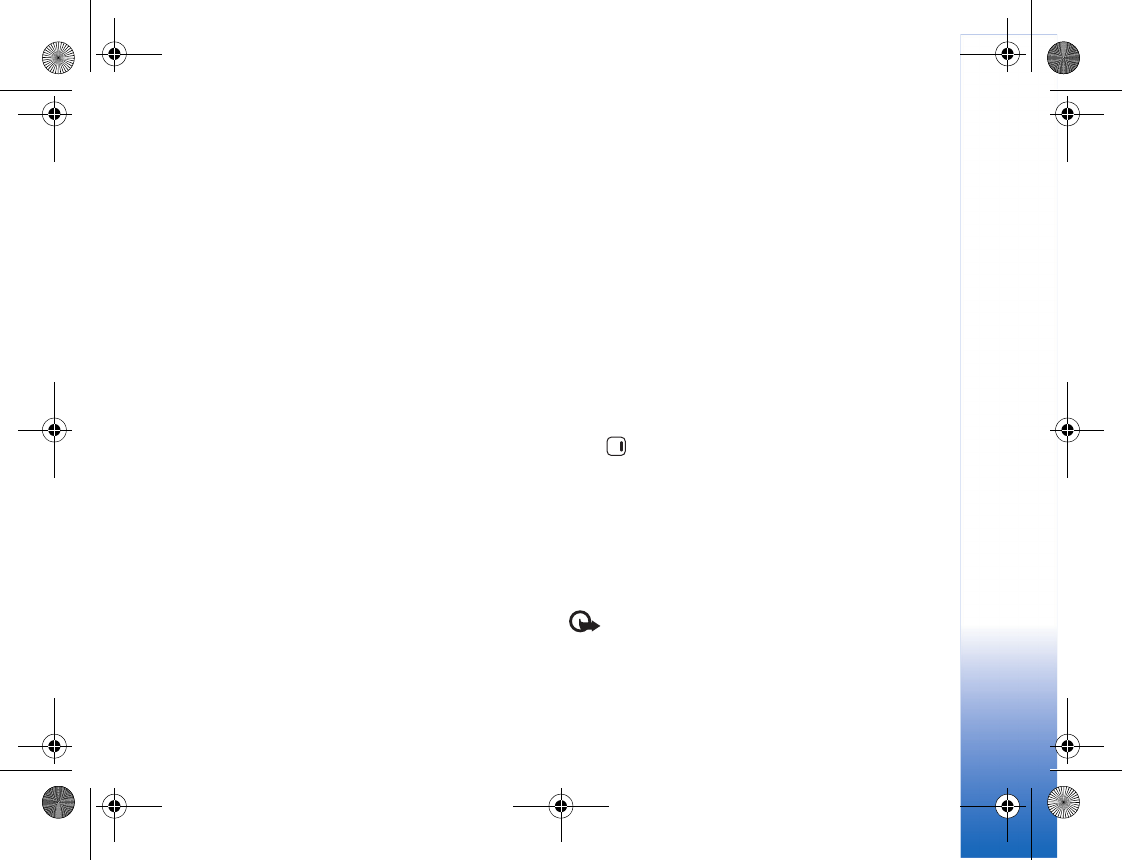
Settings
105
Confirm SChip services—You can set the device to display
confirmation messages when you are using a SmartChip
service (network service).
Glossary of PIN and lock codes
If you forget any of these codes, contact your service
provider.
The personal identification number (PIN) code—protects
your SmartChip card against unauthorized use. The PIN
code (4 to 8 digits) is usually supplied with the SmartChip
card. After three consecutive incorrect PIN code entries,
the code is blocked, and you need the PUK code to unblock
it.
The UPIN code—may be supplied with the USIM card. The
The USIM card is an enhanced version of the SmartChip
card and is supported by UMTS mobile phones.
The PIN2 code—(4 to 8 digits) is supplied with some
SmartChip cards, and is required to access some functions
in your device.
The lock code (also known as security code)—(5 digits) can
be used to lock the device to avoid unauthorized use. The
factory setting for the lock code is 12345. To avoid
unauthorized use of your device, change the lock code.
Keep the new code secret and in a safe place separate from
your device. If you forget the code, contact your service
provider.
The personal unblocking key (PUK) code and PUK2 code
(8 digits) are required to change a blocked PIN code or
PIN2 code, respectively. If the codes are not supplied with
the SmartChip card, contact the operator whose
SmartChip card is in your device.
The UPUK code—(8 digits) is required to change a blocked
UPIN code. If the code is not supplied with the USIM card,
contact the operator whose USIM card is in your device.
Certif. management
Digital certificates do not guarantee safety; they are used
to verify the origin of software.
In the certificate management main view, you can see a
list of authority certificates that are stored in your device.
Press to see a list of personal certificates, if available.
Digital certificates should be used if you want to connect
to an online bank or another site or remote server for
actions that involve transferring confidential information.
They should also be used if you want to reduce the risk of
viruses or other malicious software and be sure of the
authenticity of software when downloading and installing
software.
Important: Even if the use of certificates makes the
risks involved in remote connections and software
installation considerably smaller, they must be used
correctly in order to benefit from increased security. The
R1114_en.book Page 105 Thursday, October 19, 2006 3:43 PM
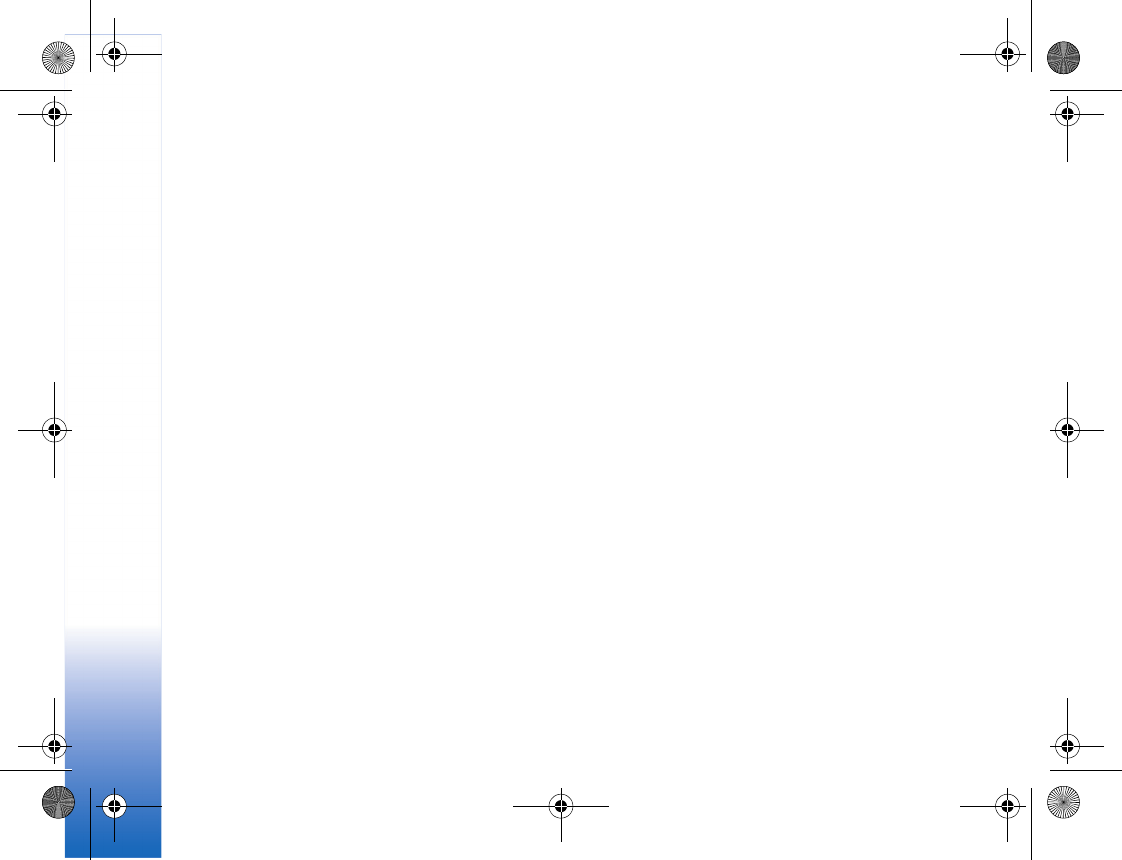
Settings
106
existence of a certificate does not offer any protection by
itself; the certificate manager must contain correct,
authentic, or trusted certificates for increased security to
be available. Certificates have a restricted lifetime. If
Expired certificate or Certificate not valid yet is shown
even if the certificate should be valid, check that the
current date and time in your device are correct.
View certificate details—check authenticity
You can only be sure of the correct identity of a server
when the signature and the period of validity of a server
certificate have been checked.
You are notified if the identity of the server is not
authentic or if you do not have the correct security
certificate in your device.
To check certificate details, scroll to a certificate, and
select Options > Certificate details. When you open
certificate details, the validity of the certificate is
checked, and one of the following notes may be displayed:
Certificate not trusted—You have not set any application
to use the certificate. See "Change the trust settings," p.
106.
Expired certificate—The period of validity has ended for
the selected certificate.
Certificate not valid yet—The period of validity has not
yet begun for the selected certificate.
Certificate corrupted—The certificate cannot be used.
Contact the certificate issuer.
Change the trust settings
Before changing any certificate settings, you must make
sure that you really trust the owner of the certificate and
that the certificate really belongs to the listed owner.
Scroll to an authority certificate, and select Options >
Trust settings. Depending on the certificate, a list of the
applications that can use the selected certificate is shown.
Symbian installation: Yes—The certificate is able to
certify the origin of a new Symbian operating system
application.
Internet: Yes—The certificate is able to certify servers.
App. installation: Yes—The certificate is able to certify the
origin of a new JavaTM application.
Select Options > Edit trust setting to change the value.
Security module
To view or edit a security module (if available) in Secur.
mod., select the module. To view detailed information
about a security module, select the module and Options >
Security details.
R1114_en.book Page 106 Thursday, October 19, 2006 3:43 PM
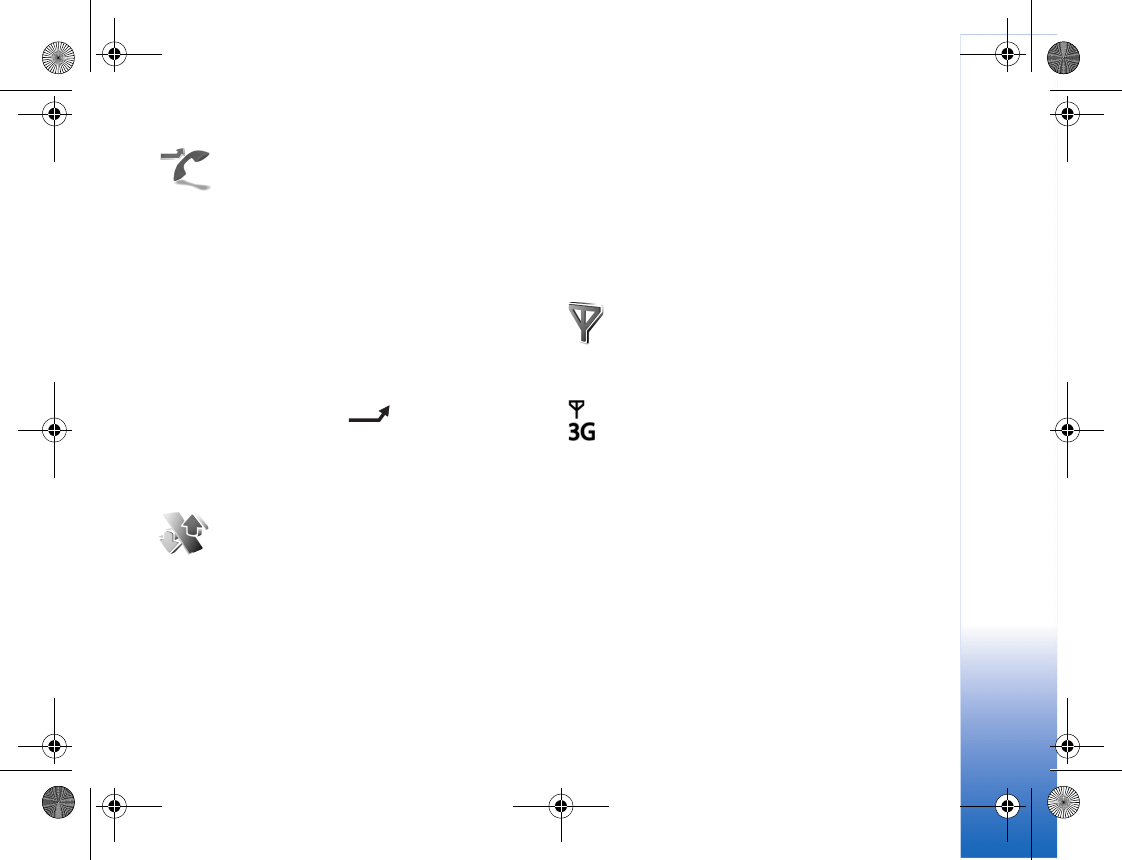
Settings
107
Call forwarding
Call forwarding (network service) allows you to divert
your incoming calls to your voice mailbox or another
phone number. For details, contact your service provider.
Select which calls you want to divert and the desired
diverting option. To divert voice calls when your number is
busy or when you reject incoming calls, select If busy. To
set the option on or off, select Activate or Cancel. To
check whether the option is activated, select Check status.
Several diverting options can be active at the same time.
When all calls are diverted, is shown in the idle
mode.
Call barring and call diverting cannot be active at the same
time.
Call restriction
Call restriction (network service) allows you to restrict the
calls that you make or receive with the device. To change
the settings, you need the barring password from your
service provider.
Select the desired restriction option. To set it on or off,
select Activate or Cancel. To check whether the option is
active, select Check status. Call restriction affects all
calls, including data calls.
Call barring and call forwarding cannot be active at the
same time.
When calls are barred, calls may be possible to the official
emergency number programmed into your device.
Network
Your device can automatically switch between the GSM
and UMTS networks. The GSM network is indicated with
in the idle mode. The UMTS network is indicated with
.
Network mode (shown only if supported by the network
operator)—Select which network to use. If you select Dual
mode, the device uses the GSM or UMTS network
automatically, according to the network parameters and
the roaming agreements between the network operators.
Contact your network operator for more details.
Operator selection—Select Automatic to set the device
to search for and select one of the available networks, or
Manual to manually select the network from a list of
networks. If the connection to the manually selected
network is lost, the device sounds an error tone and asks
you to reselect a network. The selected network must have
R1114_en.book Page 107 Thursday, October 19, 2006 3:43 PM
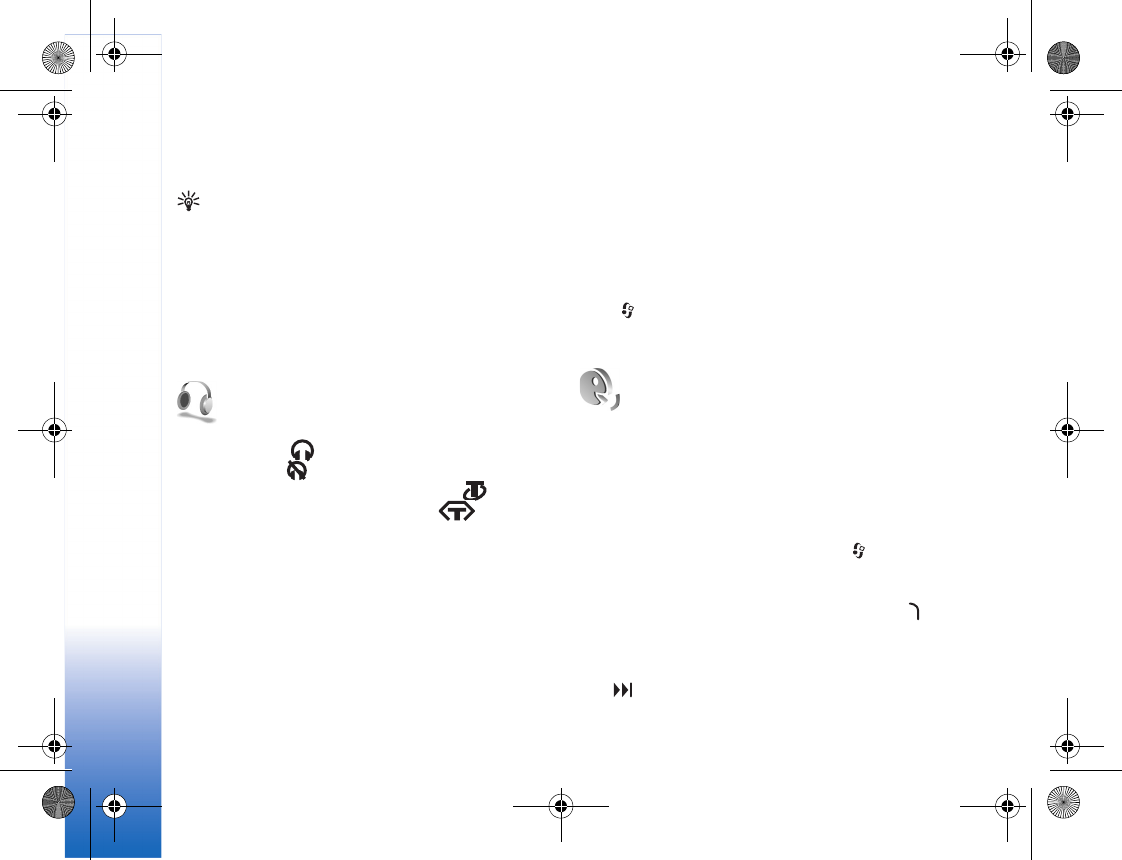
Settings
108
a roaming agreement with your home network, that is, the
operator whose SmartChip card is in your device.
Glossary: A roaming agreement is an agreement
between two or more network service providers to
enable the users of one service provider to use the
services of other service providers.
Cell info display—Select On to set the device to indicate
when it is used in a cellular network based on
microcellular network (MCN) technology and to activate
cell info reception.
Enhancement
In the idle mode, indicates a compatible headset is
connected, and that the headset is unavailable, or a
Bluetooth connectivity to a headset is lost. indicates
a compatible loopset is connected and that a
compatible TTY is connected.
Select Headset, Loopset, TTY, Bluetooth handsfree, or
Car kit and from the following:
Default profile—Set the profile that you want activated
each time you connect a certain compatible enhancement
to your device. See "Profiles—set tones," p. 95.
Automatic answer—Set if you want the device to answer
an incoming call automatically after 5 seconds. If the
Ringing type is set to Beep once or Silent, automatic
answer is disabled. Automatic answer is not available for
TTY.
Lights—Set whether lights remain on, or are switched off
after the time-out. This setting is not available for all
enhancements.
If you are using a TTY, you must activate it on your device.
Press , and select Settings > Config. >
Enhancement > TTY > Use TTY > Yes.
Voice commands
You can use voice commands to control your device. For
more information about the enhanced voice commands
supported by your device, see "Voice dialing," p. 73.
To activate enhanced voice commands for starting
applications and profiles, you must open the Voice cm.
application and its Profiles folder. Press , and select
Settings > Voice cm. > Profiles; the device creates voice
tags for the applications and profiles. To use enhanced
voice commands in the idle mode, press and hold , and
say a voice command. The voice command is the name of
the application or profile displayed in the list. To use
enhanced voice commands with the fold closed, press and
hold .
R1114_en.book Page 108 Thursday, October 19, 2006 3:43 PM
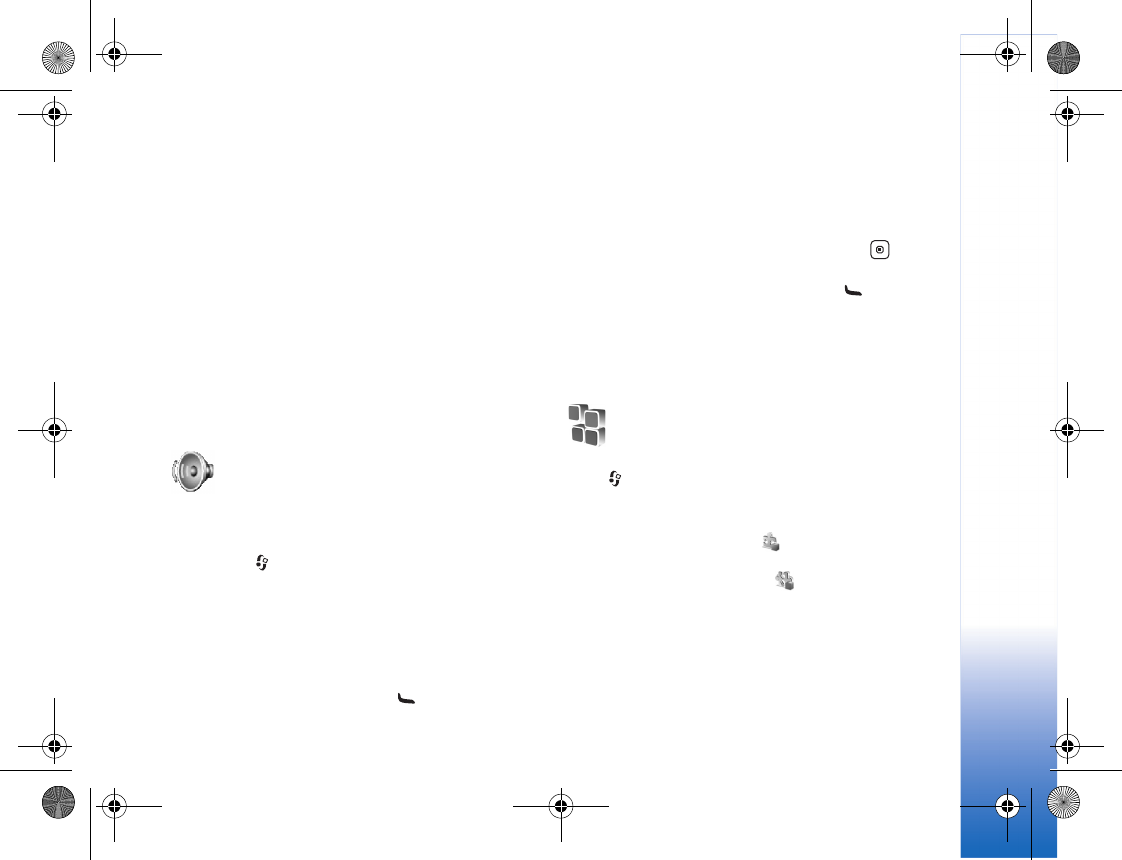
Settings
109
To add more applications to the list, select Options > New
application. To add a second voice command that can be
used to start the application, select Options > Change
command, and enter the new voice command as text.
Avoid very short names, abbreviations, and acronyms.
To listen to the synthesized voice tag, select Options >
Playback.
To change voice command settings, select Options >
Settings. To switch off the synthesizer that plays
recognized voice tags and commands in the selected
device language, select Synthesizer > Off. To reset voice
recognition learning, for example, when the main user of
the device has changed, select Reset voice adapts..
Voice aid
Voice aid reads text on the screen, allowing you to use
some basic functions of your device without looking at the
display. Press , and select Settings > Voice aid and
from the following functions:
Recent calls—Hear information of your missed and
received calls, dialed numbers, and frequent calls.
Address Book—Hear the entries in your address book.
Scroll down to to find a contact. Scroll right to open the
groups list. To call a contact, press . Do not use this
function if you have more than 500 entries in your address
book.
Voice mailbox—Call your voice mailbox (network service).
Dialer—Dial a number. To enter a number, scroll up or
down. When you hear the correct digit, press .
Continue to select each digit until you have entered the
entire number. To call the number, press .
Clock—Hear the current time. To hear the date, scroll
down.
To hear more options, select Options.
Application manager
Press , and select Settings > App. mgr.. You can install
two types of applications and software to your device:
•J2ME
TM applications based on Java technology with
the extension .jad or .jar ( ).
• Other applications and software suitable for the
Symbian operating system ( ). The installation files
have the .sis extension. Only install software
specifically designed for your Nokia device. Software
providers may often refer to the official model number
of this product.
R1114_en.book Page 109 Thursday, October 19, 2006 3:43 PM

Settings
110
Installation files may be transferred to your device from a
compatible computer, downloaded during browsing, or
sent to you in a multimedia message, as an e-mail
attachment, or using Bluetooth connectivity or infrared.
You can use Nokia Application Installer in Nokia PC Suite
to install an application to your device. If you use
Microsoft Windows Explorer to transfer a file, save the file
to a compatible memory card (local disk).
Install applications and software
indicates a .sis application, a Java application,
that the application is not fully installed,and
that the application is installed on the memory card.
Important: Only install and use applications and
other software from sources that offer adequate security
and protection against harmful software.
Preinstallation
Before installation, note the following:
To view the application type, version number, and the
supplier or manufacturer of the application, select
Options > View details.
To display the security certificate details of the
application, select Options > View certificate. See
"Certif. management," p. 105.
If you install a file that contains an update or repair to an
existing application, you can only restore the original
application if you have the original installation file or a full
back-up copy of the removed software package. To restore
the original application, remove the application, and install
the application again from the original installation file or
the back-up copy.
The .jar file is required for installing Java applications. If it
is missing, the device may ask you to download it. If there
is no access point defined for the application, you are
asked to select one. When you are downloading the .jar
file, you may need to enter a user name and password to
access the server. You obtain these from the supplier or
manufacturer of the application.
Installation
1To locate an installation file, press , and select
Settings > App. mgr.. Alternatively, search the device
memory or a compatible memory card (if inserted) in
File mgr., or open a message in Messag. > Inbox that
contains an installation file.
2In App. mgr., select Options > Install. In other
applications, select the installation file to start the
installation.
During installation, the device shows information
about the progress of the installation. If you are
installing an application without a digital signature or
certification, the device displays a warning. Continue
R1114_en.book Page 110 Thursday, October 19, 2006 3:43 PM
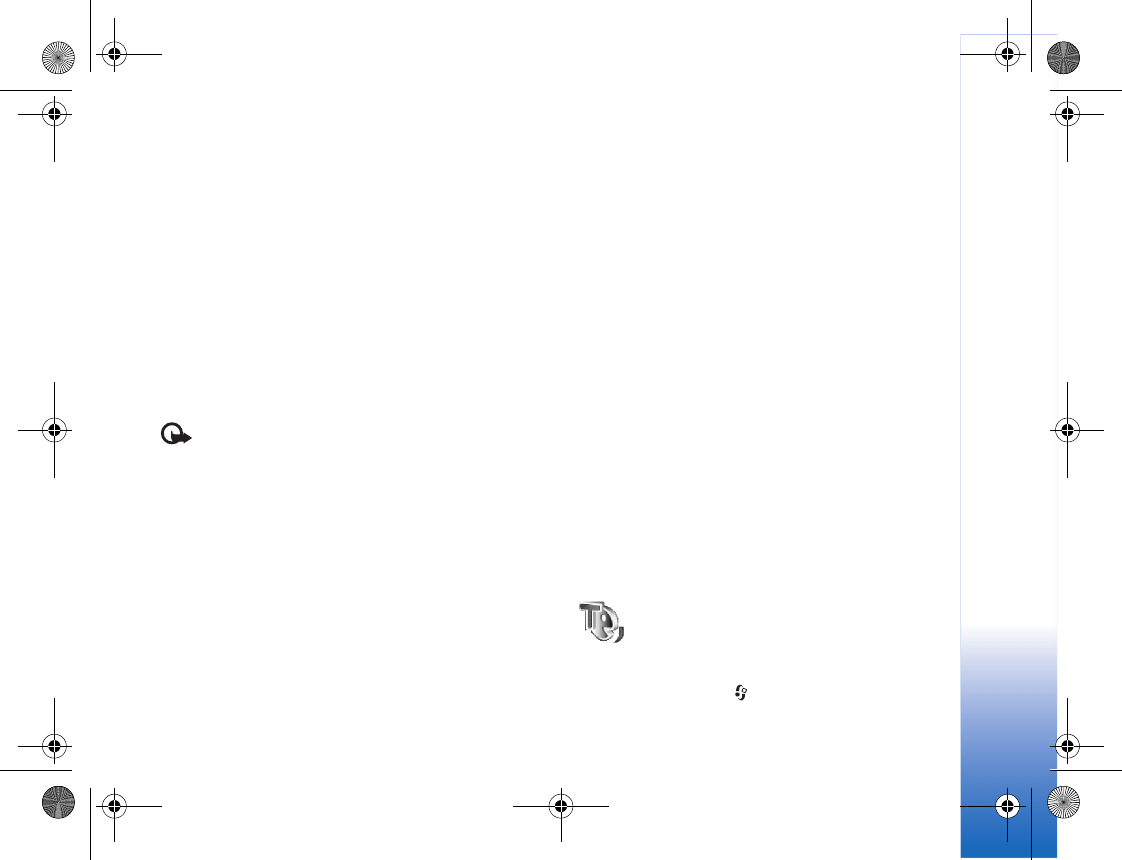
Settings
111
installation only if you are sure of the origin and
contents of the application.
To start an installed application, select it in the menu.
To start a network connection and to view extra
information about the application, select Options > Go to
web address, if available.
To see what software packages are installed or removed
and when, select Options > View log.
To send your installation log to a help desk so that they can
see what is installed or removed, select Options > Send
log > Via text message or Via e-mail (available only if the
correct e-mail settings are in place).
Important: Your device can only support one
antivirus application. Having more than one application
with antivirus functionality may affect performance and
operation or cause the device to stop functioning.
Remove applications and software
Scroll to a software package, and select Options >
Remove. Select Yes to confirm.
If you remove software, you can only reinstall it if you have
the original software package or a full backup of the
removed software package. If you remove a software
package, you may no longer be able to open documents
created with that software.
If another software package depends on the software
package that you removed, the other software package
may stop working. Refer to the documentation of the
installed software package for details.
Settings
Select Options > Configuration and from the following:
Software installation—Select Signed only to only install
applications with verified digital signatures.
Online certif. check—Select to check the online
certificates before installing an application.
Default web address—Set the default address used when
checking online certificates.
Some Java applications may require a phone call, a
message to be sent, or a network connection to a specific
access point for downloading extra data or components.
In the App. mgr. main view, scroll to an application, and
select Options > Suite settings to change settings related
to that specific application.
Speech
In Speech you can select the language and voice used for
reading messages. Press , and select Settings >
R1114_en.book Page 111 Thursday, October 19, 2006 3:43 PM

Settings
112
Speech > Language or Voice. To adjust the speed and
volume of the speech, select Voice settings.
The voice is language-dependent. When you change the
language, the voice changes to the default voice for the
language. Select another voice for the language, if
desired.
To view the voices available for the selected language,
scroll right. To play a voice, view information about a
voice, or delete a voice, select Options > Play voice,
Voice details, or Delete.
Bluetooth connectivity
You can connect wirelessly to other compatible devices
with wireless Bluetooth technology. Compatible devices
may include mobile phones, computers, and
enhancements such as headsets and car kits. You can use
Bluetooth connectivity to send images, video clips, music
and audio, and notes; connect wirelessly to your
compatible PC (for example, to transfer files); connect to
a compatible printer to print images with Image print.
See "Print images," p. 48.
Since devices with Bluetooth wireless technology
communicate using radio waves, your device and the
other device do not need to be in direct line-of-sight. The
two devices only need to be within 10 meters (33 feet) of
each other, but the connection may be subject to
interference from obstructions such as walls or from other
electronic devices.
This device is compliant with Bluetooth Specification 2.0
supporting the following profiles: Basic Printing Profile,
Generic Access Profile, Serial Port Profile, Dial-up
Networking Profile, Headset Profile, Handsfree Profile,
Generic Object Exchange Profile, Object Push Profile, File
Transfer Profile, Basic Imaging Profile, SmartChip Access
profile, and Human Interface Device Profile. To ensure
interoperability between other devices supporting
Bluetooth technology, use Nokia approved enhancements
for this model. Check with the manufacturers of other
devices to determine their compatibility with this device.
Glossary: A profile corresponds to a service or a
function, and defines how different devices connect.
For example, the Handsfree Profile is used between the
handsfree device and the mobile device. For devices to
be compatible, they must support the same profiles.
There may be restrictions on using Bluetooth technology in
some locations. Check with your local authorities or service
provider.
Features using Bluetooth technology, or allowing such
features to run in the background while using other
R1114_en.book Page 112 Thursday, October 19, 2006 3:43 PM
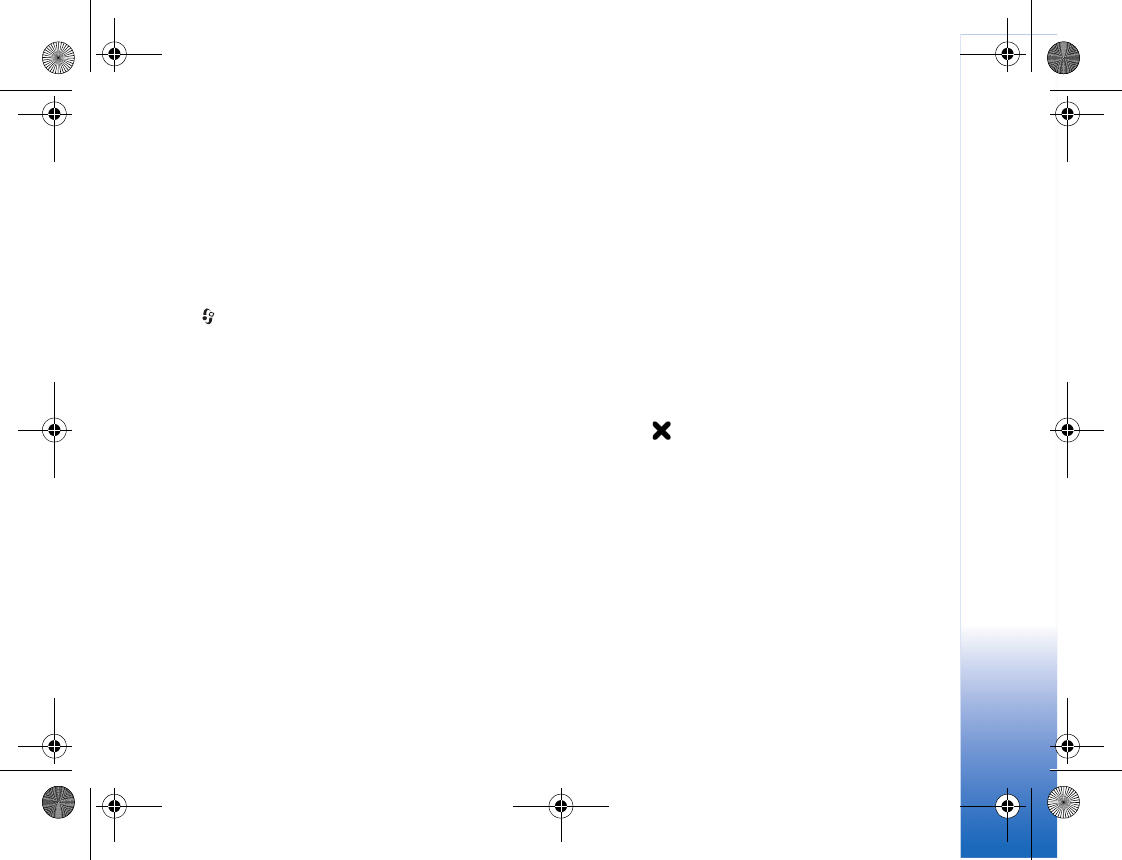
Settings
113
features, increase the demand on battery power and
reduce the battery life.
When the device is locked, you cannot use Bluetooth
connectivity. See "Security," p. 104 for more information
on locking the device.
Settings
Press , and select Settings > Bluetooth. When you
open the application for the first time, you are asked to
define a name for your device. After you set Bluetooth
connectivity on and change My phone's visibility to
Shown to all, your device and this name can be seen by
other users with devices using Bluetooth wireless
technology.
Select from the following:
Bluetooth—Select On or Off. To connect wirelessly to
another compatible device, set Bluetooth connectivity On,
then establish a connection.
My phone's visibility—To allow your device to be found by
other devices with Bluetooth wireless technology, select
Shown to all. To hide it from other devices, select Hidden.
My phone's name—Edit the name of your device.
Remote SChip mode—To enable another device, such as a
compatible car kit enhancement, to use the SmartChip in
your device to connect to the network, select On.
Remote SmartChip mode
To use the remote SmartChip mode with a compatible car
kit enhancement, set Bluetooth connectivity on, and
enable the use of the remote SmartChip mode with your
device. Before the mode can be activated, the two devices
must be paired and the pairing initiated from the other
device. When pairing, use a 16-digit passcode, and set the
other device as authorized. See "Pair devices," p. 114.
Activate the remote SmartChip mode from the other
device.
When remote SmartChip mode is on in your device,
Remote SChip is displayed in the idle mode. The
connection to the wireless network is turned off, as
indicated by in the signal strength indicator area, and
you cannot use SmartChip services or features requiring
cellular network coverage.
When the wireless device is in the remote SmartChip
mode, you can only use a compatible connected
enhancement, such as a car kit, to make or receive calls.
Your wireless device will not make any calls, except to the
emergency numbers programmed into your device, while
in this mode. To make calls from your device, you must
first leave the remote SmartChip mode. If the device has
been locked, enter the code to unlock it first.
To leave the remote SmartChip mode, press the power key,
and select Exit rem. SChip mode.
R1114_en.book Page 113 Thursday, October 19, 2006 3:43 PM
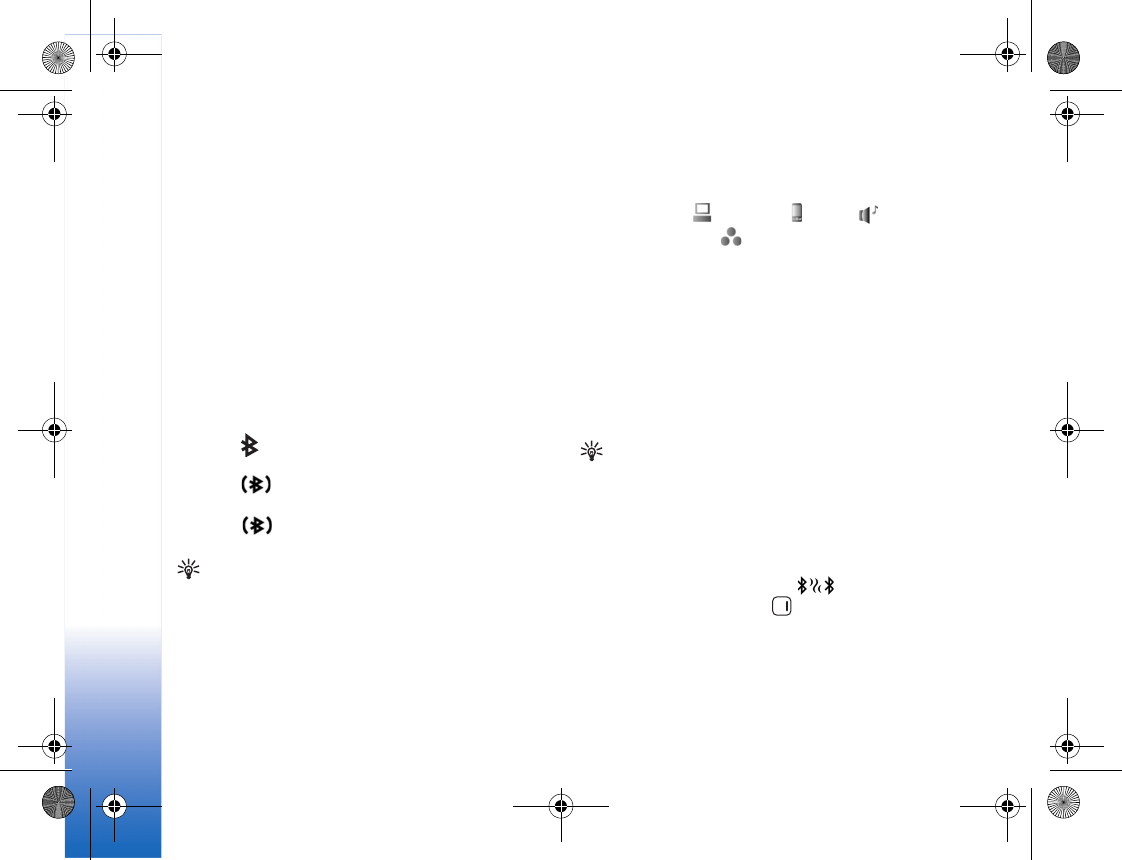
Settings
114
Security tips
When you are not using Bluetooth connectivity, select
Bluetooth > Off or My phone's visibility > Hidden.
Do not pair with an unknown device.
Send data using Bluetooth
connectivity
Several Bluetooth connections can be active at a time. For
example, if you are connected to a compatible headset,
you can also transfer files to another compatible device at
the same time.
Bluetooth connectivity indicators
• When is shown in the idle mode, Bluetooth
connectivity is on.
• When is blinking, your device is trying to connect
with another device.
• When is shown continuously, data is being
transmitted using Bluetooth connectivity.
Tip! To send text using Bluetooth connectivity, select
Notes, write the text, and select Options > Send > Via
Bluetooth.
1Open the application where the item you want to send
is stored. For example, to send an image to another
compatible device, select My Stuff.
2Select the item and Options > Send > Via Bluetooth.
Devices with Bluetooth wireless technology within
range start to appear on the display.
Device icons: computer, phone, audio or
video device, and other device.
To interrupt the search, select Stop.
3Select the device with which you want to connect.
4If the other device requires pairing before data can be
transmitted, a tone sounds, and you are asked to enter
a passcode. See "Pair devices," p. 114.
5When the connection has been established, Sending
data is shown.
The Sent folder in Messag. does not store messages sent
using Bluetooth connectivity.
Tip! When searching for devices, some devices may
show only the unique address (device address). To find
the unique address of your device, enter the code
*#2820# in the idle mode.
Pair devices
To open the paired devices view ( ), in the Bluetooth
application main view, press .
Before pairing, create your own passcode (1—16 digits),
and agree with the owner of the other device to use the
same code. Devices that do not have a user interface have
a factory-set passcode. The passcode is used only once.
R1114_en.book Page 114 Thursday, October 19, 2006 3:43 PM

Settings
115
To pair with a device, select Options > New paired device.
Devices with Bluetooth wireless technology within range
start to appear on the display. Select the device, and enter
the passcode. The same passcode must be entered on the
other device as well. After pairing, the device is saved to
the paired devices view.
Paired devices are indicated by in the device search.
To set a device as authorized or unauthorized, scroll to a
device, and select from the following options:
Set as authorized—Connections between your device and
this device can be made without your knowledge. No
separate acceptance or authorization is needed. Use this
status for your own devices, such as your compatible
headset or PC, or devices that belong to someone you trust.
indicates authorized devices in the paired devices
view.
Set as unauthorized—Connection requests from this
device must be accepted separately every time.
To cancel a pairing, scroll to the device, and select
Options > Delete. If you want to cancel all pairings, select
Options > Delete all.
Tip! If you are currently connected to a device and
delete the pairing with that device, pairing is removed
immediately, and the connection to the device is
switched off.
Receive data using Bluetooth
connectivity
When you receive data through Bluetooth connectivity, a
tone sounds, and you are asked if you want to accept the
message. If you accept, is shown, and the item is
placed in the Inbox folder in Messag.. Messages received
through Bluetooth connectivity are indicated by . See
"Inbox—receive messages," p. 60.
Switch off Bluetooth connectivity
To switch off Bluetooth connectivity, select Bluetooth >
Off.
Infrared connection
With infrared, you can transfer data such as business
cards, calendar notes, and media files with a compatible
device.
Do not point the IR (infrared) beam at anyone's eye or
allow it to interfere with other IR devices. This device is a
Class 1 laser product.
R1114_en.book Page 115 Thursday, October 19, 2006 3:43 PM
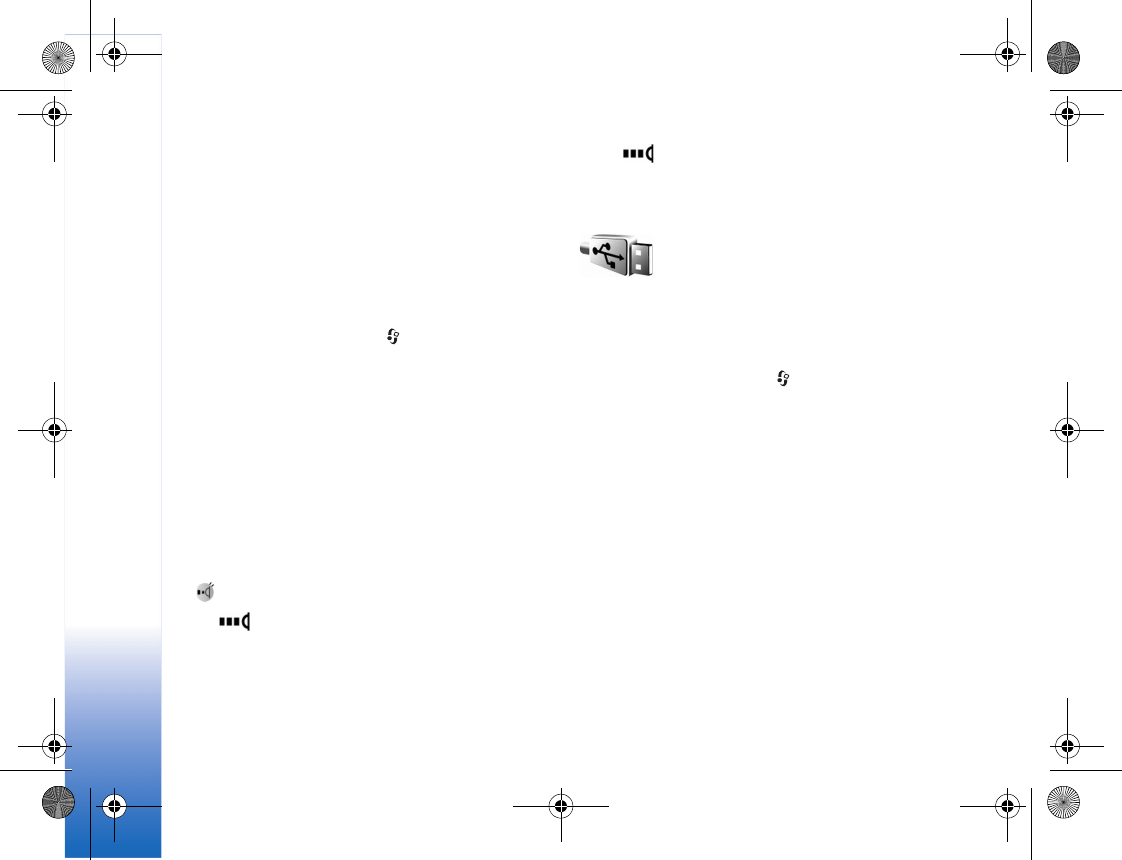
Settings
116
Send and receive data using infrared
1Make sure that the infrared ports of the sending and
receiving devices are pointing at each other, and that
there are no obstructions between the devices. The
preferable distance between the two devices is up to
1 meter (3 feet).
2The user of the receiving device activates the infrared
port.
To activate the infrared port of your device to receive
data through infrared, press , and select Settings >
Infrared.
3The user of the sending device selects the desired
infrared function to start the data transfer.
To send data through infrared, locate the desired file
in an application or the file manager, and select
Options > Send > Via infrared.
If data transfer is not started within 1 minute after the
activation of the infrared port, the connection is cancelled
and must be started again.
All items received through infrared are placed in the Inbox
folder in Messaging. New infrared messages are indicated
by .
When blinks, your device is trying to connect to the
other device or a connection has been lost.
When is shown continuously, the infrared
connection is active, and your device is ready to send and
receive data using its infrared port.
Data cable
You can connect your device to a compatible
PC using a USB data cable. With data cable
connectivity, you can use Nokia PC Suite and transfer
music or other data, such as image files, between your
device and the PC. To change the device type you normally
connect to your device press , and select Settings >
Data cbl.
In Data cable mode, select from the following:
•Media player - to connect to a compatible media
player.
•PC Suite - to connect to Nokia PC Suite.
•Data transfer - to connect to a compatible PC to
access and transfer data, such as audio or image files.
•Image print - to connect to Image print.
To have the device ask the purpose of the connection each
time the cable is connected, select Ask on connection.
R1114_en.book Page 116 Thursday, October 19, 2006 3:43 PM
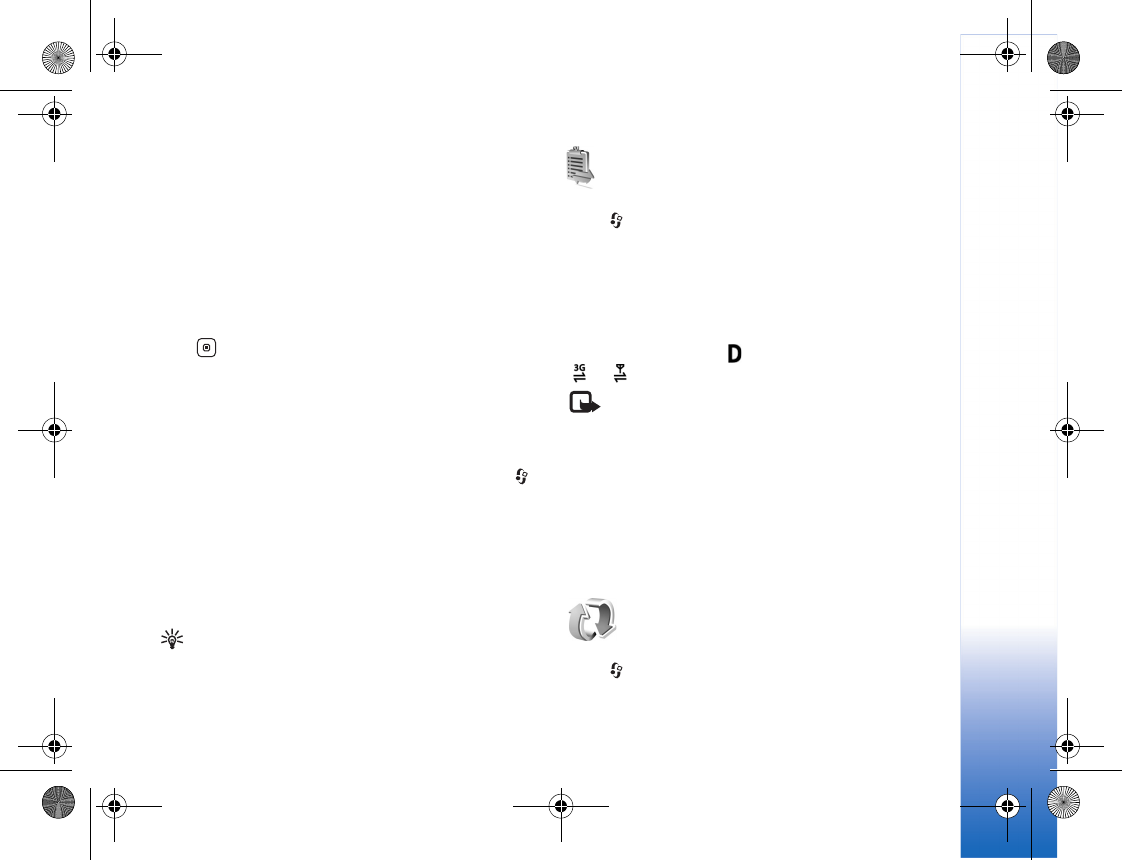
Settings
117
PC connections
You can use your device with a variety of compatible PC
connectivity and data communications applications. With
Nokia PC Suite you can, for example, transfer images
between your device and a compatible PC.
Always create the connection from the PC to synchronize
with your device.
To connect your device to a compatible PC using infrared,
press . Make sure that the infrared ports of your device
and PC are directly facing each other, and that there are no
obstructions between the devices. See "Infrared
connection," p. 115
To connect your device to a PC using Bluetooth
connectivity, initiate the connection from the PC. To
activate Bluetooth connectivity in your device, press ,
and select Settings > Bluetooth and Bluetooth > On. See
"Bluetooth connectivity," p. 112.
To connect your device to a compatible PC using a USB
data cable, initiate the connection from the PC.
Detailed installation instructions can be found in the user
guide for Nokia PC Suite.
Tip! When using Nokia PC Suite for the first time, to
connect your device to a compatible PC and to use
Nokia PC Suite, use the Get Connected wizard available
in Nokia PC Suite.
Connection manager
Press , and select Settings > Conn. mgr.. To view the
status of data connections or end connections in GSM and
UMTS network, select Act. data conn..
Data connections
In the active connections view, you can see the open data
connections: data calls ( ), and packet data connections
( or ).
Note: The actual time invoiced for calls by your
service provider may vary, depending on network
features, rounding off for billing, and so forth.
To end a connection, select Options > Disconnect. To
close all open connections, select Options > Disconnect
all.
To view the details of a connection, select Options >
Details. The details shown depend on the connection type.
Synchronization
Press , and select Settings > Sync. Sync enables you
to synchronize your Notes, Calendar, or Addr. Book with
R1114_en.book Page 117 Thursday, October 19, 2006 3:43 PM

Settings
118
various compatible calendar and address book
applications on a compatible computer or on the Internet.
You can also create or edit synchronization settings.
The synchronization application uses SyncML technology
for synchronization. For information on SyncML
compatibility, contact the supplier of the application with
which you want to synchronize your device data.
You may receive synchronization settings in a special text
message. See "Data and settings," p. 61.
Synchronize data
In the Sync main view, you can see the different
synchronization profiles.
1Select a synchronization profile and Options >
Synchronize. The status of the synchronization is
shown on the display.
To cancel synchronization before it finishes, select
Cancel.
2You are notified when the synchronization is
complete. Select Yes to view the log file showing the
synchronization status and how many entries have
been added, updated, deleted, or discarded (not
synchronized) in your device or on the server.
Device manager
To connect to a server and receive configuration settings
for your device, to create new server profiles, or to view
and manage existing server profiles, press , and select
Settings > Dev. mgr. and scroll right. The available options
may vary.
You may receive server profiles and different configuration
settings from your network operator, service providers, and
company information management department. These
configuration settings may include connection and other
settings used by different applications in your device.
Scroll to a server profile, and select Options and from the
following:
Start configuration—to connect to the server and receive
configuration settings for your device
New server profile—to create a server profile
Edit profile—to change the profile settings
View log—to view the configuration log of the profile
To delete a server profile, scroll to it, and press .
Server profile settings
Contact your service provider for the correct settings.
R1114_en.book Page 118 Thursday, October 19, 2006 3:43 PM
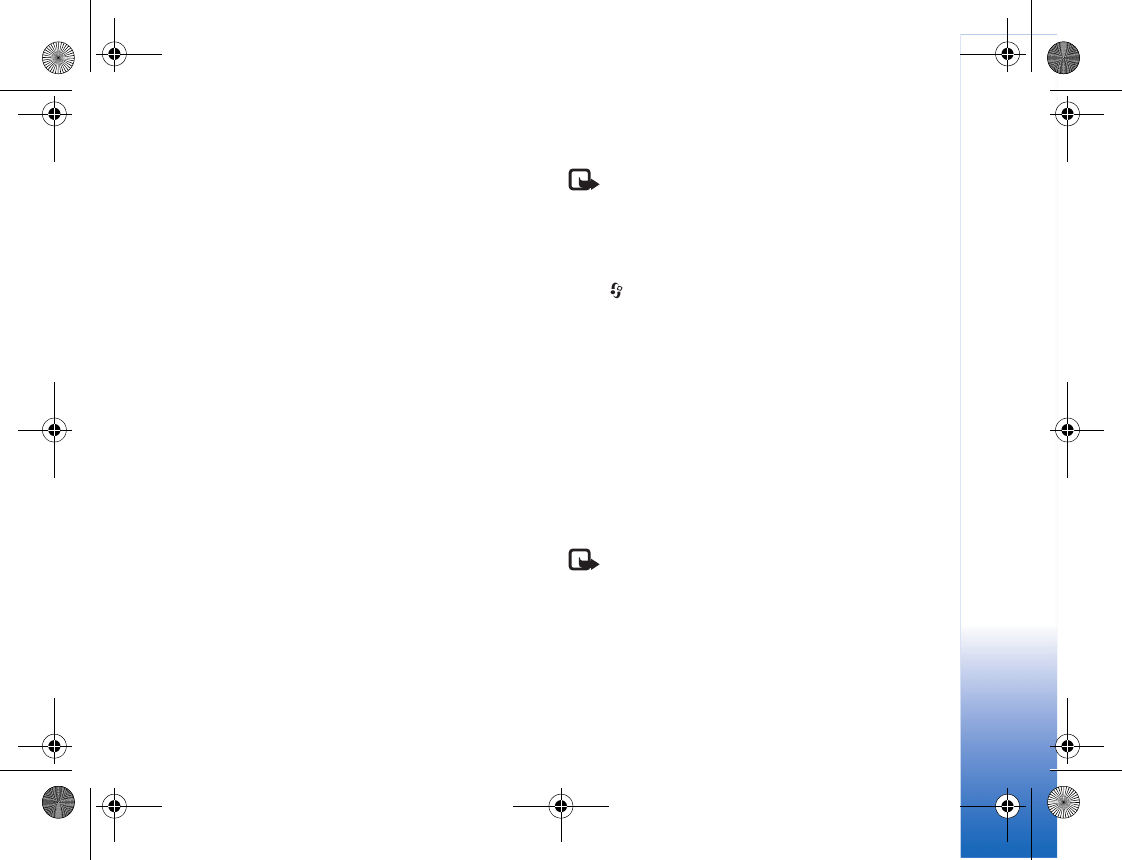
Settings
119
Server name—Enter a name for the configuration server.
Server ID—Enter the unique ID to identify the
configuration server.
Server password—Enter a password to identify your device
to the server.
Access point—Select an access point to be used when
connecting to the server.
Host address—Enter the URL address of the server.
Port—Enter the port number of the server.
User name and Password—Enter your user name and
password.
Allow configuration—To allow receiving configuration
settings from the server, select Yes.
Auto-accept all reqs.—To have your device to ask for your
confirmation before accepting a configuration from the
server, select No.
Network authentic.—Select if network authentication is
used.
Network user name and Network password—Enter your
network user name and password to identify your device to
the server. These options are shown only if network
authentication is used.
Software updates
Note: This functionality may not be available in
your device. Contact your service provider for more
information.
To view or update the current software version of your
device, or to check the date of a possible previous update,
press and select Settings > Dev. mgr..
To check whether software updates are available, select
Options > Check updates.
Make sure that the battery of your device has enough
power or connect the charger before starting the update.
To start the update, select access point. The device starts
to download the device data.
When the data is downloaded, the update description is
displayed. Select Accept to accept the download of the
update package or Cancel to cancel the download. The
download may take several minutes. You can use your
device during the download.
Note: If you install a software update, you cannot
use the device, even to make emergency calls, until the
installation is completed and the device restarted. Be
sure to backup data before accepting the installation
of an update.
Select Yes to install the update or No to install it later by
selecting Options > Install update. The update may take
R1114_en.book Page 119 Thursday, October 19, 2006 3:43 PM
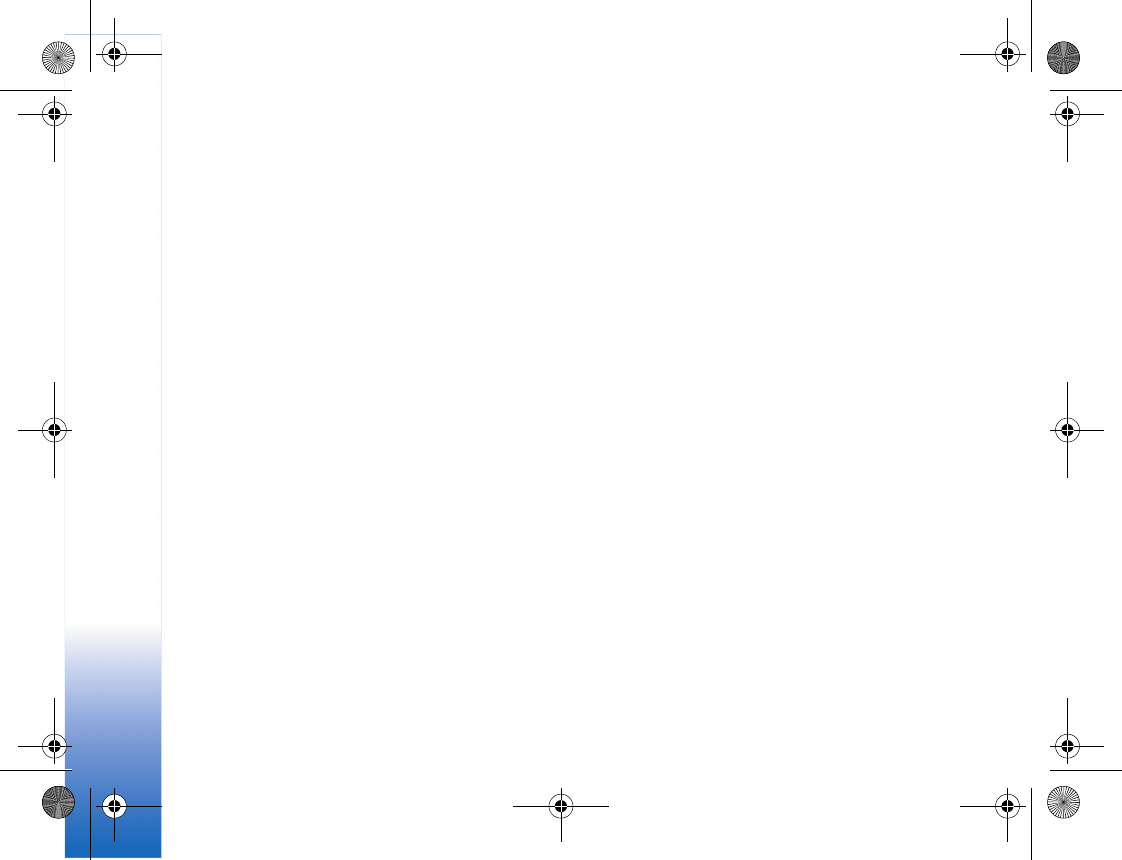
Settings
120
several minutes. Select Accept to accept the update. The
device updates the software and restarts. To complete the
update, select OK. To send the software update status to
server, select access point.
If there are problems with the installation, contact your
network operator or service provider.
To view the server profile settings used for software
updates, select Options > Settings.
The available options may vary.
R1114_en.book Page 120 Thursday, October 19, 2006 3:43 PM
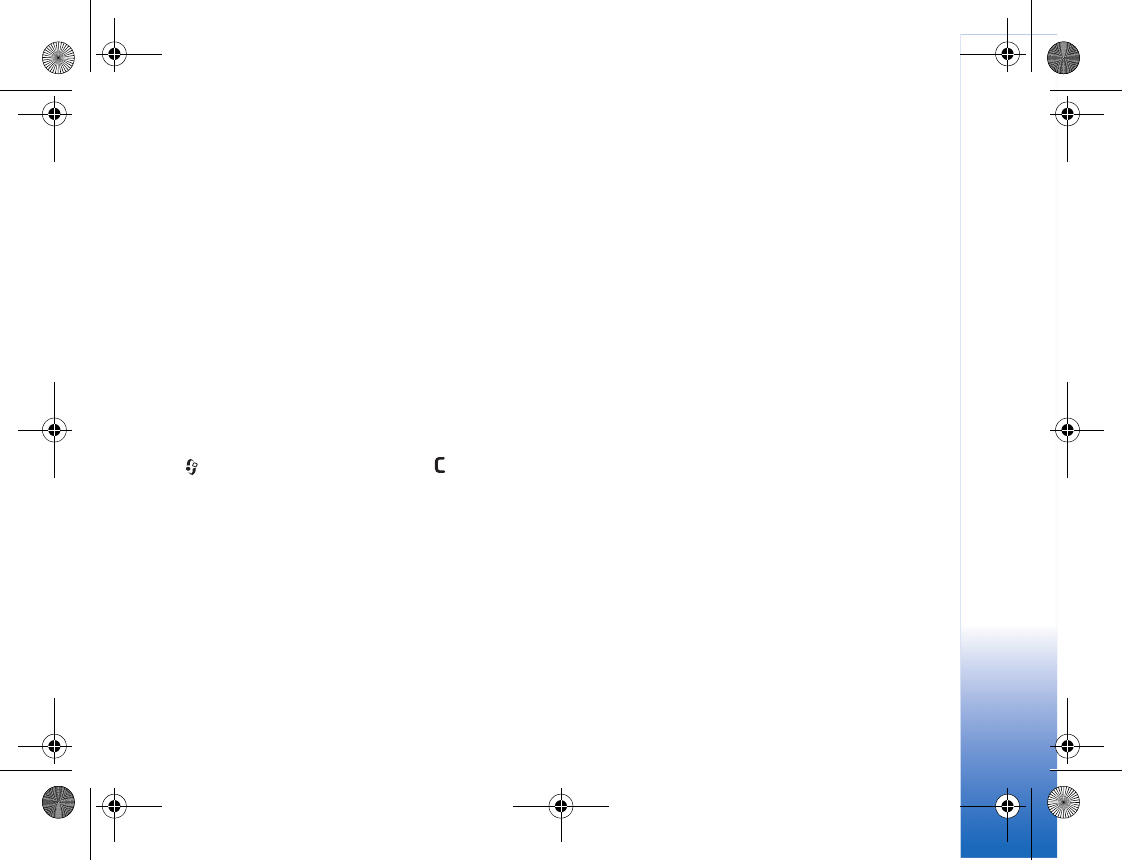
Troubleshooting: Q&A
121
Troubleshooting: Q&A
Access codes
Q: What is my password for the lock, PIN, or PUK codes?
A: The default lock code is 12345. If you forget or lose the lock
code, contact your device dealer.
If you forget or lose a PIN or PUK code, or if you have not
received such a code, contact your network operator.
For information about passwords, contact your access
point provider, for example, a commercial Internet service
provider (ISP), service provider, or network operator.
Application not responding
Q: How do I close an application that is not responding?
A: To open the application switching window, press and hold
. Scroll to the application, and press to close the
application.
Bluetooth connectivity
Q: Why can’t I find my friend’s device?
A: Check that both devices have activated Bluetooth
connectivity.
Check that the distance between the two devices is not
over 10 meters (33 feet) and that there are no walls or
other obstructions between the devices.
Check that the other device is not in hidden mode.
Check that both devices are compatible.
Q: Why can’t I end a Bluetooth connection?
A: If another device is connected to your device, you can
either end the connection using the other device or by
deactivating Bluetooth connectivity. Select Connect. >
Bluetooth > Off.
Browser services
Q: What do I do if the following message is displayed: No
valid access point defined. Define one in Services
settings.?
A: Insert the correct browser settings. Contact your service
provider for instructions.
Camera
Q: Why do images look smudgy?
A: Remove the protective plastic films covering the display
and camera. Ensure that the camera lens protection
window is clean.
Display
Q: Why do missing, discolored, or bright dots appear on the
screen every time I turn on my device?
A: This is a characteristic of this type of display. Some displays
may contain pixels or dots that remain on or off. This is
normal, not a fault.
Log
Q: Why does the log appear empty?
R1114_en.book Page 121 Thursday, October 19, 2006 3:43 PM

Troubleshooting: Q&A
122
A: You may have activated a filter, and no communication
events fitting that filter have been logged. To see all
events, select Settings > Log > Options > Filter > All
communication.
Memory low
Q: What can I do if my device memory is low?
A: You can delete the following items regularly to avoid
memory getting low:
• Messages from Inbox, Drafts, and Sent folders in
Messag.
• Retrieved e-mail messages from the device memory
• Saved browser pages
• Images and photos in My Stuff
To delete contact information, calendar notes, call timers,
call cost timers, game scores, or any other data, go to the
respective application to remove the data. If you are
deleting multiple items and one of the following notes are
shown: Not enough memory to perform operation.
Delete some data first. or Memory low. Delete some
data., try deleting items one by one (starting from the
smallest item).
Q: How can I save my data before deleting it?
A: Save your data using one of the following methods:
• Use Nokia PC Suite to make a backup copy of all data
to a compatible computer.
• Send images to your e-mail address, then save the
images to your computer.
• Send data using Bluetooth connectivity to a compatible
device.
• Store data on a compatible memory card.
Messaging
Q: Why can’t I select a contact?
A: The contact card does not have a phone number or an
e-mail address. Add the missing information to the contact
card in Addr. Book.
Multimedia messaging
Q: What should I do when the device cannot receive a
multimedia message because memory is full?
A: The amount of memory needed is indicated in the error
message: Not enough memory to retrieve message.
Delete some data first. To view what kind of data you
have and how much memory the different data groups
consume, select File manager > Options > Check
memory.
Q: The note Retrieving message is shown briefly. What is
happening?
A: The device is trying to retrieve a multimedia message from
the multimedia messaging center.
Check that the settings for multimedia messaging are
defined correctly and that there are no mistakes in phone
numbers or addresses. Select Messaging > Options >
Settings > Multim. msg..
Q: How can I end the data connection when the device starts
a data connection again and again?
R1114_en.book Page 122 Thursday, October 19, 2006 3:43 PM
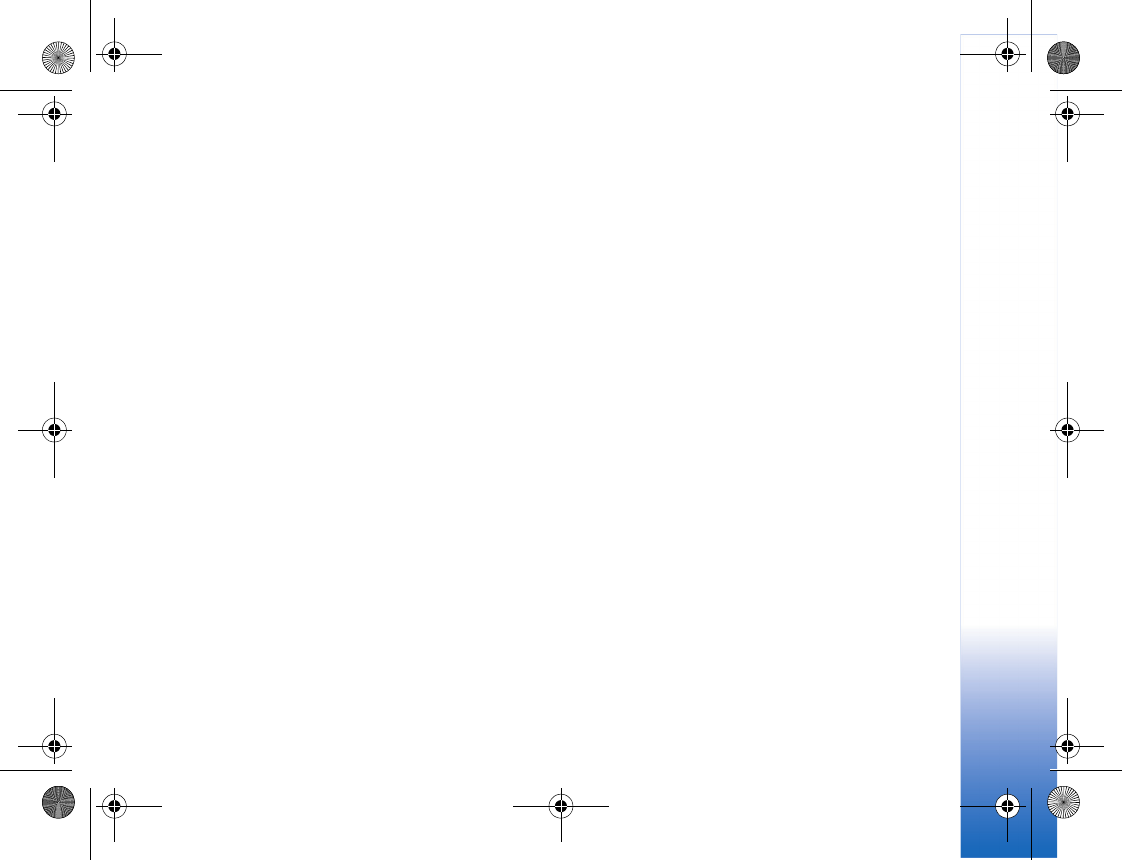
Troubleshooting: Q&A
123
A: To stop the device from making a data connection, select
Messaging and one of the following:
On receiving msg. > Defer retrieval—To have the
multimedia messaging center save the message to be
retrieved later, for example, after you have checked the
settings. After this change, the device still needs to send
information notes to the network. To retrieve the message
now, select Retr. immediately.
On receiving msg. > Reject message—To reject all
incoming multimedia messages. After this change, the
device needs to send information notes to the network, and
the multimedia messaging center deletes multimedia
messages that are waiting to be sent to you.
Multimedia recept. > Off—To ignore all incoming
multimedia messages. After this change, the device does
not make any network connections related to multimedia
messaging.
PC connectivity
Q: Why do I have problems in connecting the device to my PC?
A: Make sure that Nokia PC Suite is installed and running on
your PC. See the user guide for Nokia PC Suite on the
CD-ROM. For further information on how to use Nokia PC
Suite, see the help function on Nokia PC Suite or visit the
support pages at www.nokia.com.
R1114_en.book Page 123 Thursday, October 19, 2006 3:43 PM

Enhancements
124
Enhancements
If you want to enhance phone
functionality, a range of
enhancements is available for
you. You can select any of these
items to help accommodate your
specific communication needs.
For availability of these and other enhancements, contact
your dealer.
Check the model number of any charger before use with
this device. This device is intended for use when supplied
with power from an AC-3, AC-4 or AC-5 charger, and from
an AC-1, ACP-8, ACP-12, LCH-9, or LCH-12 charger when
used with the CA-44 charger adapter.
Warning: Use only batteries, chargers, and
enhancements approved by Nokia for use with this
particular model. The use of any other types may
invalidate any approval or warranty and may be
dangerous.
Your device and its enhancements may contain small
parts. Keep them out of the reach of small children.
A few practical rules about accessories and
enhancements.
• Keep all accessories and enhancements out of the
reach of small children.
• When you disconnect the power cord of any accessory
or enhancement, grasp and pull the plug, not the cord.
• Check regularly that enhancements installed in a
vehicle are mounted and are operating properly.
• Installation of any complex car enhancements must be
made by qualified personnel only.
• Entries in bold indicate items supplied in-box.
Power
• Battery, 800 mAh (BL-5BT)
•Travel Charger (AC-4)
• Travel Charger (AC-5)
• Compact Charger (AC-3)
• Charger Adapter (CA-44)
Data
• Connectivity Cable (CA-53)
• Wireless GPS Module (LD-3W)
• Charging Data Cable (CA-70)
• MicroSD Cards (128MB - MU-26, 256MB - MU-27,
512MB - MU-28, 1GB - MU-22, 2GB - MU-37)
• TTY Adapter (HDA-10)
R1114_en.book Page 124 Thursday, October 19, 2006 3:43 PM
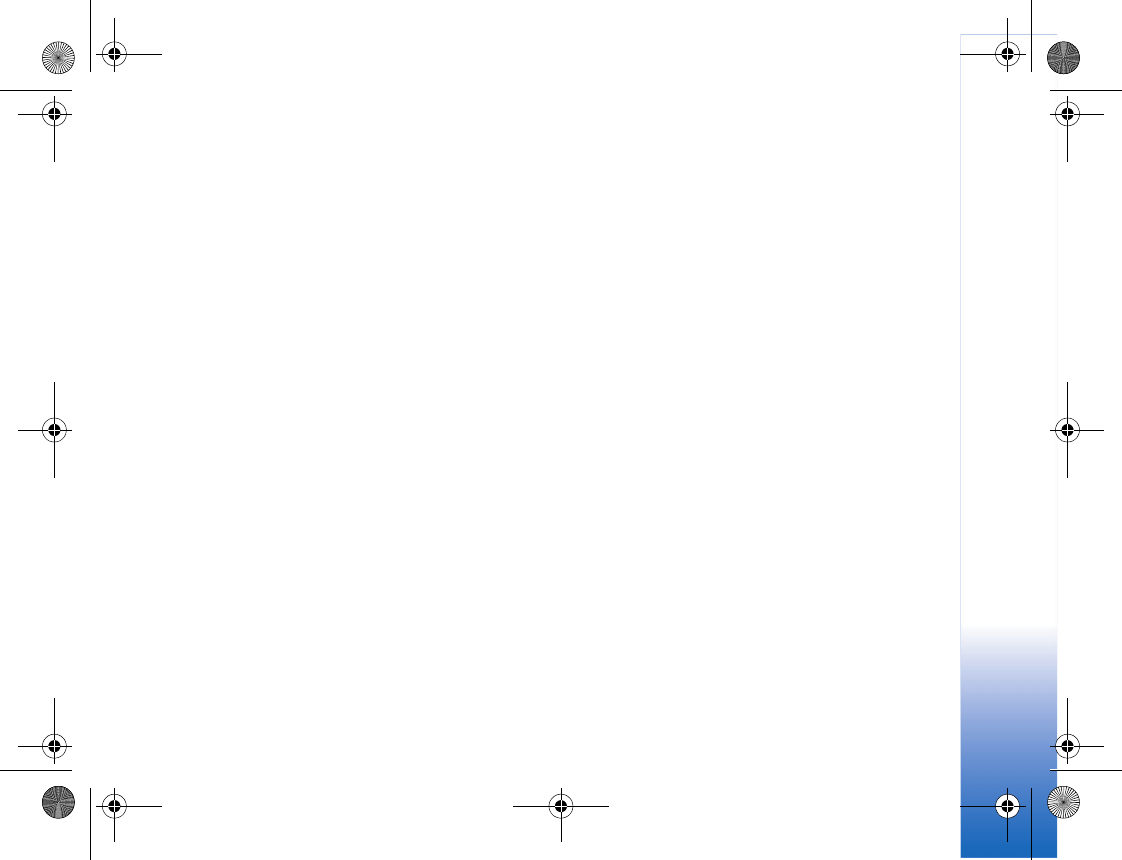
Enhancements
125
Audio
• Headsets (HS-20, HS-28, HS-23, HS-31, HS-5, HS-29,
HS-69)
• Wireless Headsets (HS-21W, HS-24W, HS-25W, HS-
26W, HS-36W, HS-50W, HS-51W, HS-57W, HS-58W,
HS-59W)
• Inductive Loopset (LPS-4)
•Audio Adapter (AD-41, AD-46, AD-15, AD-45)
Messaging
• Wireless Keyboard (SU-8W)
• Digital Pen (SU-27W)
Music
• Music stand (MD-1)
• Music Headphone (HS-61)
• Active Music Headphone (HS-62)
Carrying
•Protective pouch (CL-1)
• Wrist Strap (CP-134)
• Carrying Case (CP-108, CP-109, CP-110)
Car
• Mobile Charger (DC-4)
• Wireless Plug-in Car Handsfree (HF-6W, HF-33W)
• Wireless Car Kits (CK-7W, CK-20W)
• Navigation pack (LD-2)
• Universal Holder (CR-39)
R1114_en.book Page 125 Thursday, October 19, 2006 3:43 PM

Battery information
126
Battery information
Charging and discharging
Your device is powered by a rechargeable battery. The full
performance of a new battery is achieved only after two or
three complete charge and discharge cycles. The battery can
be charged and discharged hundreds of times but it will
eventually wear out. When the talk and standby times are
noticeably shorter than normal, replace the battery. Use only
Nokia approved batteries, and recharge your battery only with
Nokia approved chargers designated for this device.
If a replacement battery is being used for the first time or if
the battery has not been used for a prolonged period, it may
be necessary to connect the charger and then disconnect and
reconnect it to begin charging the battery.
Unplug the charger from the electrical plug and the device
when not in use. Do not leave a fully charged battery
connected to a charger, since overcharging may shorten its
lifetime. If left unused, a fully charged battery will lose its
charge over time.
If the battery is completely discharged, it may take a few
minutes before the charging indicator appears on the display
or before any calls can be made.
Use the battery only for its intended purpose. Never use any
charger or battery that is damaged.
Do not short-circuit the battery. Accidental short-circuiting
can occur when a metallic object such as a coin, clip, or pen
causes direct connection of the positive (+) and negative (-)
terminals of the battery. (These look like metal strips on the
battery.) This might happen, for example, when you carry a
spare battery in your pocket or purse. Short-circuiting the
terminals may damage the battery or the connecting object.
Leaving the battery in hot or cold places, such as in a closed
car in summer or winter conditions, will reduce the capacity
and lifetime of the battery. Always try to keep the battery
between 15°C and 25°C (59°F and 77°F). A device with a hot
or cold battery may not work temporarily, even when the
battery is fully charged. Battery performance is particularly
limited in temperatures well below freezing.
Do not dispose of batteries in a fire as they may explode.
Batteries may also explode if damaged. Dispose of batteries
according to local regulations. Please recycle when possible.
Do not dispose as household waste.
The BL-5BT battery provides up to 132 minutes (WCDMA) /
250 minutes (GSM) of talk time and up to 200 hours (WCDMA)
/ 200 hours (GSM) of standby time. Battery talk and standby
times are estimates only and depend on signal strength,
network conditions, features used, battery age and condition,
temperatures to which battery is exposed, and many other
factors. The amount of time a phone is used for calls will affect
R1114_en.book Page 126 Thursday, October 19, 2006 3:43 PM

Battery information
127
its standby time. Likewise, the amount of time that the phone
is turned on and in standby mode will affect its talk time.
Nokia battery authentication
guidelines
Always use original Nokia batteries for your safety. To check
that you are getting an original Nokia battery, purchase it from
an authorized Nokia dealer, look for the Nokia Original
Enhancements logo on the packaging and inspect the
hologram label using the following steps:
Successful completion of the four steps is not a total
assurance of the authenticity of the battery. If you have any
reason to believe that your battery is not an authentic original
Nokia battery, you should refrain from using it, and take it to
the nearest authorized Nokia service point or dealer for
assistance. Your authorized Nokia service point or dealer will
inspect the battery for authenticity. If authenticity cannot be
verified, return the battery to the place of purchase.
Authenticate hologram
1When looking at the hologram on
the label, you should see the Nokia
connecting hands symbol from
one angle and the Nokia Original
Enhancements logo when looking
from another angle.
2When you angle the hologram
left, right, down, and up, you
should see 1, 2, 3, and 4 dots on
each side respectively.
3Scratch the side of the label to
reveal a 20-digit code, for
example
12345678919876543210. Turn
the battery so that the numbers
are facing upwards. The 20-digit
code reads starting from the
number at the top row followed
by the bottom row.
4Confirm that the 20-digit code is
valid by following the instructions
at www.nokia.com/batterycheck.
What if your battery is not authentic?
If you cannot confirm that your Nokia battery with the
hologram on the label is an authentic Nokia battery, please do
not use the battery. Take it to the nearest authorized Nokia
R1114_en.book Page 127 Thursday, October 19, 2006 3:43 PM
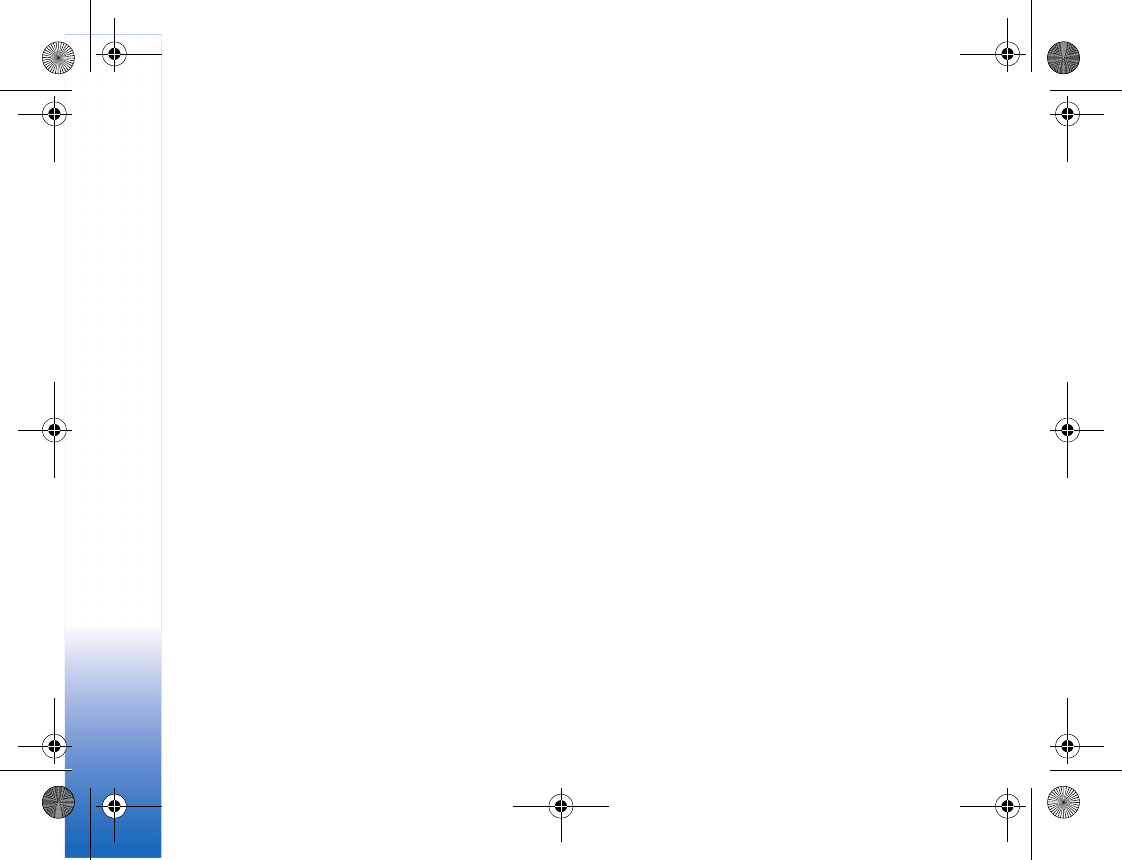
Battery information
128
service point or dealer for assistance. The use of a battery that
is not approved by the manufacturer may be dangerous and
may result in poor performance and damage to your device
and its enhancements. It may also invalidate any approval or
warranty applying to the device.
To find out more about original Nokia batteries, visit
www.nokia.com/battery.
R1114_en.book Page 128 Thursday, October 19, 2006 3:43 PM
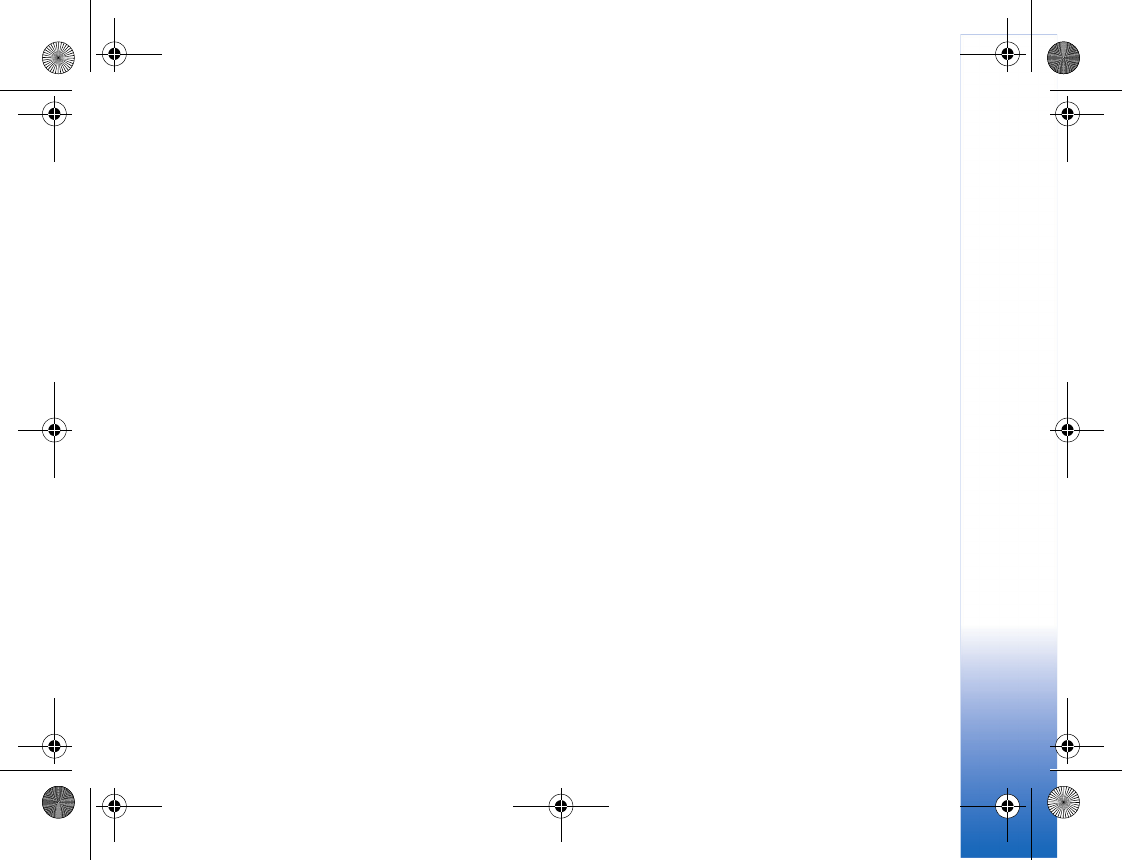
Care and maintenance
129
Care and maintenance
Your device is a product of superior design and craftsmanship
and should be treated with care. The suggestions below will
help you protect your warranty coverage.
• Keep the device dry. Precipitation, humidity, and all types
of liquids or moisture can contain minerals that will
corrode electronic circuits. If your device does get wet,
remove the battery, and allow the device to dry completely
before replacing it.
• Do not use or store the device in dusty, dirty areas. Its
moving parts and electronic components can be damaged.
• Do not store the device in hot areas. High temperatures
can shorten the life of electronic devices, damage
batteries, and warp or melt certain plastics.
• Do not store the device in cold areas. When the device
returns to its normal temperature, moisture can form
inside the device and damage electronic circuit boards.
• Do not attempt to open the device other than as instructed
in this guide.
• Do not drop, knock, or shake the device. Rough handling
can break internal circuit boards and fine mechanics.
• Do not use harsh chemicals, cleaning solvents, or strong
detergents to clean the device.
• Do not paint the device. Paint can clog the moving parts
and prevent proper operation.
• Use a soft, clean, dry cloth to clean any lenses (such as
camera, proximity sensor, and light sensor lenses).
• Use only the supplied or an approved replacement
antenna. Unauthorized antennas, modifications, or
attachments could damage the device and may violate
regulations governing radio devices.
• Use chargers indoors.
• Always create a backup of data you want to keep (such as
addresses and calendar notes) before sending your device
to a service facility.
• To reset the device from time to time for optimum
performance, power off the device, and remove the
battery. Make back-up copies of all important data.
All of the above suggestions apply equally to your device,
battery, charger, or any enhancement. If any device is not
working properly, take it to the nearest authorized service
facility for service.
R1114_en.book Page 129 Thursday, October 19, 2006 3:43 PM
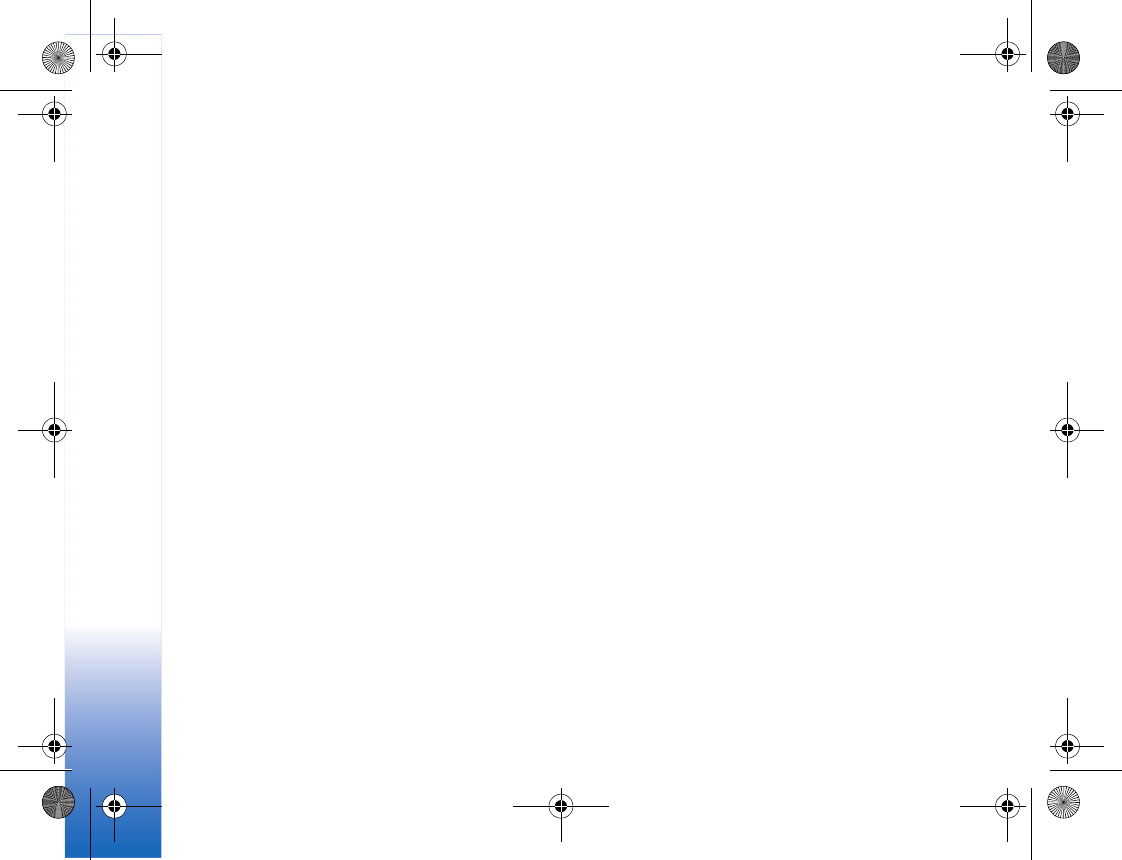
Additional safety information
130
Additional safety information
Your device and its enhancements may contain small parts.
Keep them out of the reach of small children.
Operating environment
Remember to follow any special regulations in force in any
area, and always switch off your device when its use is
prohibited or when it may cause interference or danger. Use
the device only in its normal operating positions. This device
meets RF exposure guidelines when used either in the normal
use position against the ear or when positioned at least
1.5 centimeters (5/8 inch) from the body. When a carry case,
belt clip, or holder is used for body-worn operation, it should
not contain metal and should position the device the above-
stated distance from your body.
To transmit data files or messages, this device requires a good
quality connection to the network. In some cases,
transmission of data files or messages may be delayed until
such a connection is available. Ensure that the above
separation distance instructions are followed until the
transmission is completed.
Parts of the device are magnetic. Metallic materials may be
attracted to the device. Do not place credit cards or other
magnetic storage media near the device, because information
stored on them may be erased.
Medical devices
Operation of any radio transmitting equipment, including
wireless phones, may interfere with the functionality of
inadequately protected medical devices. Consult a physician or
the manufacturer of the medical device to determine if they
are adequately shielded from external RF energy or if you have
any questions. Switch off your device in health care facilities
when any regulations posted in these areas instruct you to do
so. Hospitals or health care facilities may be using equipment
that could be sensitive to external RF energy.
Pacemakers Pacemaker manufacturers recommend that a
minimum separation of 15.3 centimeters (6 inches) be
maintained between a wireless phone and a pacemaker to
avoid potential interference with the pacemaker. These
recommendations are consistent with the independent
research by and recommendations of Wireless Technology
Research. Persons with pacemakers should:
• always keep the device more than 15.3 centimeters
(6 inches) from their pacemaker;
• not carry the device in a breast pocket;
• hold the device to the ear opposite the pacemaker to
minimize the potential for interference.
If you suspect interference, switch off your device, and move
the device away.
R1114_en.book Page 130 Thursday, October 19, 2006 3:43 PM
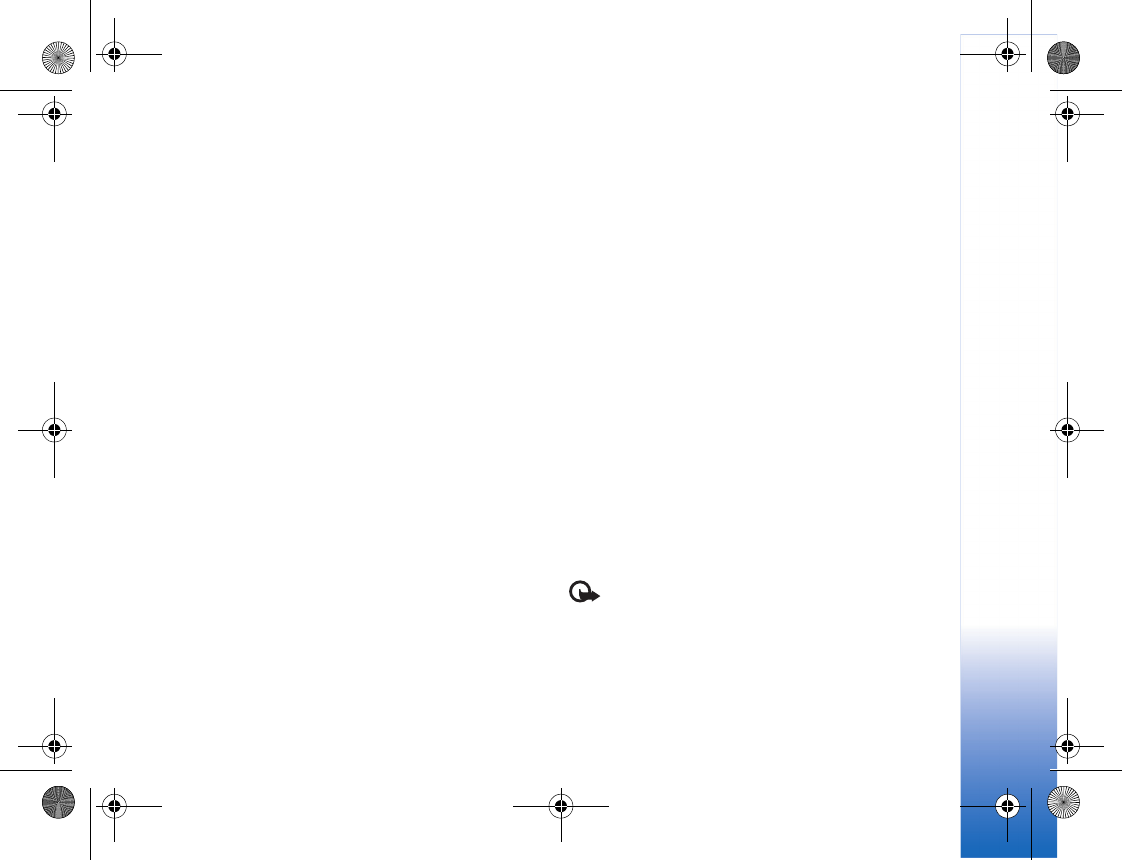
Additional safety information
131
Hearing aids Some digital wireless devices may interfere
with some hearing aids. If interference occurs, consult your
service provider.
Vehicles
RF signals may affect improperly installed or inadequately
shielded electronic systems in motor vehicles such as
electronic fuel injection systems, electronic antiskid (antilock)
braking systems, electronic speed control systems, and air bag
systems. For more information, check with the manufacturer,
or its representative, of your vehicle or any equipment that has
been added.
Only qualified personnel should service the device, or install
the device in a vehicle. Faulty installation or service may be
dangerous and may invalidate any warranty that may apply to
the device. Check regularly that all wireless device equipment
in your vehicle is mounted and operating properly. Do not store
or carry flammable liquids, gases, or explosive materials in the
same compartment as the device, its parts, or enhancements.
For vehicles equipped with an air bag, remember that air bags
inflate with great force. Do not place objects, including
installed or portable wireless equipment in the area over the
air bag or in the air bag deployment area. If in-vehicle wireless
equipment is improperly installed, and the air bag inflates,
serious injury could result.
Using your device while flying in aircraft is prohibited. Switch
off your device before boarding an aircraft. The use of wireless
teledevices in an aircraft may be dangerous to the operation
of the aircraft, disrupt the wireless telephone network, and
may be illegal.
Potentially explosive environments
Switch off your device when in any area with a potentially
explosive atmosphere, and obey all signs and instructions.
Potentially explosive atmospheres include areas where you
would normally be advised to turn off your vehicle engine.
Sparks in such areas could cause an explosion or fire resulting
in bodily injury or even death. Switch off the device at
refueling points such as near gas pumps at service stations.
Observe restrictions on the use of radio equipment in fuel
depots, storage, and distribution areas; chemical plants; or
where blasting operations are in progress. Areas with a
potentially explosive atmosphere are often, but not always,
clearly marked. They include below deck on boats, chemical
transfer or storage facilities, vehicles using liquefied
petroleum gas (such as propane or butane), and areas where
the air contains chemicals or particles such as grain, dust or
metal powders.
Emergency calls
Important: Wireless phones, including this device,
operate using radio signals, wireless networks, landline
networks, and user-programmed functions. Because of this,
connections in all conditions cannot be guaranteed. You
should never rely solely on any wireless device for essential
communications like medical emergencies.
R1114_en.book Page 131 Thursday, October 19, 2006 3:43 PM
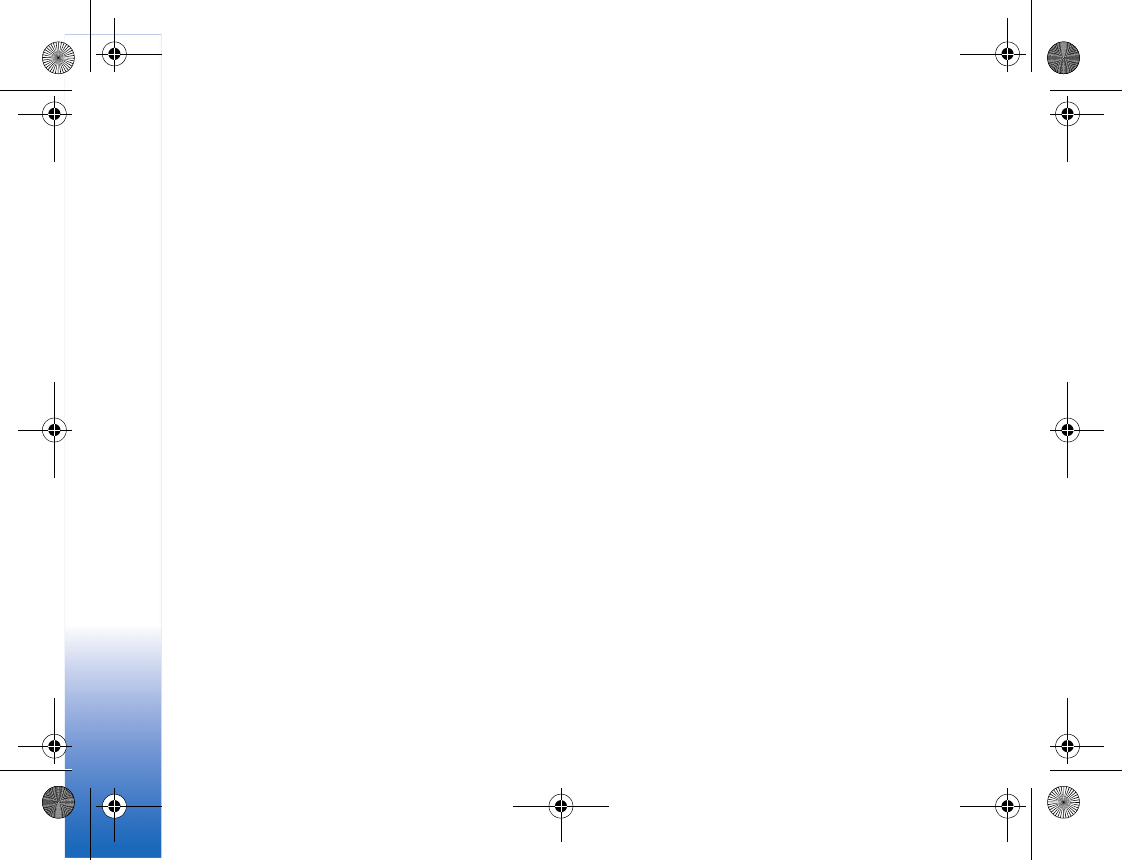
Additional safety information
132
To make an emergency call:
1If the device is not on, switch it on. Check for adequate
signal strength.
Some networks may require that a valid SmartChip is
properly inserted in the device.
2Press the end key as many times as needed to clear the
display and ready the device for calls.
3Enter the official emergency number for your present
location. Emergency numbers vary by location.
4Press the call key.
If certain features are in use, you may first need to turn those
features off before you can make an emergency call. Consult
this guide or your service provider for more information.
When making an emergency call, give all the necessary
information as accurately as possible. Your wireless device
may be the only means of communication at the scene of an
accident. Do not end the call until given permission to do so.
Certification information (SAR)
THIS MOBILE DEVICE MEETS GUIDELINES FOR EXPOSURE TO
RADIO WAVES.
Your mobile device is a radio transmitter and receiver. It is
designed not to exceed the limits for exposure to radio waves
recommended by international guidelines. These guidelines
were developed by the independent scientific organization
ICNIRP and include safety margins designed to assure the
protection of all persons, regardless of age and health.
The exposure guidelines for mobile devices employ a unit of
measurement known as the Specific Absorption Rate or SAR.
The SAR limit stated in the ICNIRP guidelines is 2.0 watts/
kilogram (W/kg) averaged over 10 grams of tissue. Tests for
SAR are conducted using standard operating positions with
the device transmitting at its highest certified power level in
all tested frequency bands. The actual SAR level of an
operating device can be below the maximum value because
the device is designed to use only the power required to reach
the network. That amount changes depending on a number of
factors such as how close you are to a network base station.
The highest SAR value under the ICNIRP guidelines for use of
the device at the ear is 0.68 W/kg.
Use of device accessories and enhancements may result in
different SAR values. SAR values may vary depending on
national reporting and testing requirements and the network
band. Additional SAR information may be provided under
product information at www.nokia.com.
Your mobile device is also designed to meet the requirements
for exposure to radio waves established by the Federal
Communications Commission (USA) and Industry Canada.
These requirements set a SAR limit of 1.6 W/kg averaged over
1 gram of tissue. The highest SAR value reported under this
standard during product certification for use at the ear is 0.43
W/kg and when properly worn on the body is 0.78 W/kg.
Information about this device model can be found at
www.fcc.gov/oet/fccid by searching the equipment
authorization system using FCC ID: QURRM-128.
R1114_en.book Page 132 Thursday, October 19, 2006 3:43 PM
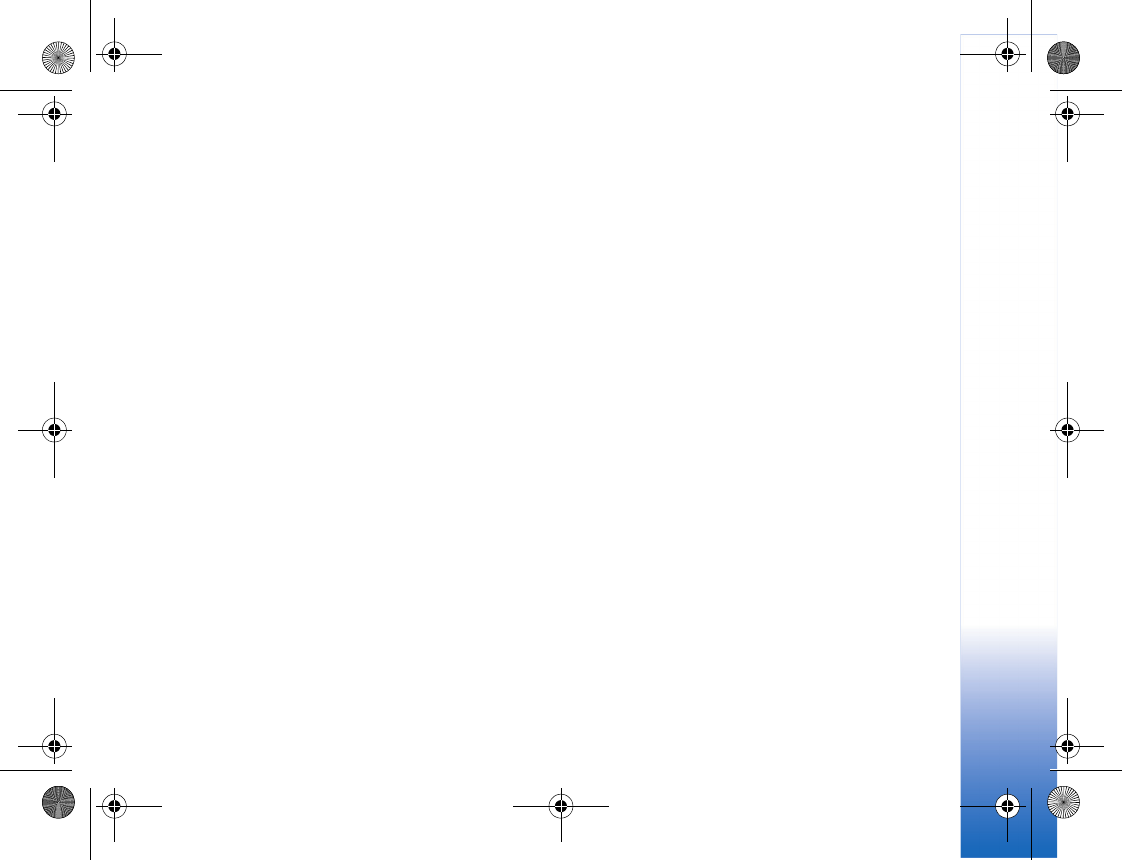
Additional safety information
133
Technical information
Feature Specification
Weight 4.36 oz (123.5 g) with BL-5BT Li-Ion Battery
Size
Volume: 5.68 in3 (93.0 cm3)
Length: 3.74 in (95 mm)
Width: 2.05 in (52 mm)
Thickness: 0.80 in (20.2 mm) with camera
Frequency range
GSM 850: 824–849 MHz (TX), 869–894 MHz (RX)
GSM 900: 880–915 MHz (TX), 925–960 MHz (RX)
GSM 1800: 1710–1785 MHz (TX), 1805–1880 MHz (RX)
GSM 1900: 1850–1910 MHz (TX), 1930–1990 MHz (RX)
UMTS 850: 824–849 MHz (TX), 869–894 MHz (RX)
UMTS 1900: 1850–1910 MHz (TX), 1930–1990 MHz (RX)
Transmitter output power Up to 2 W
Battery voltage 3.7 V dc
Operating temperature 59°F to + 77°F (15°C to + 25°C)
R1114_en.book Page 133 Thursday, October 19, 2006 3:43 PM
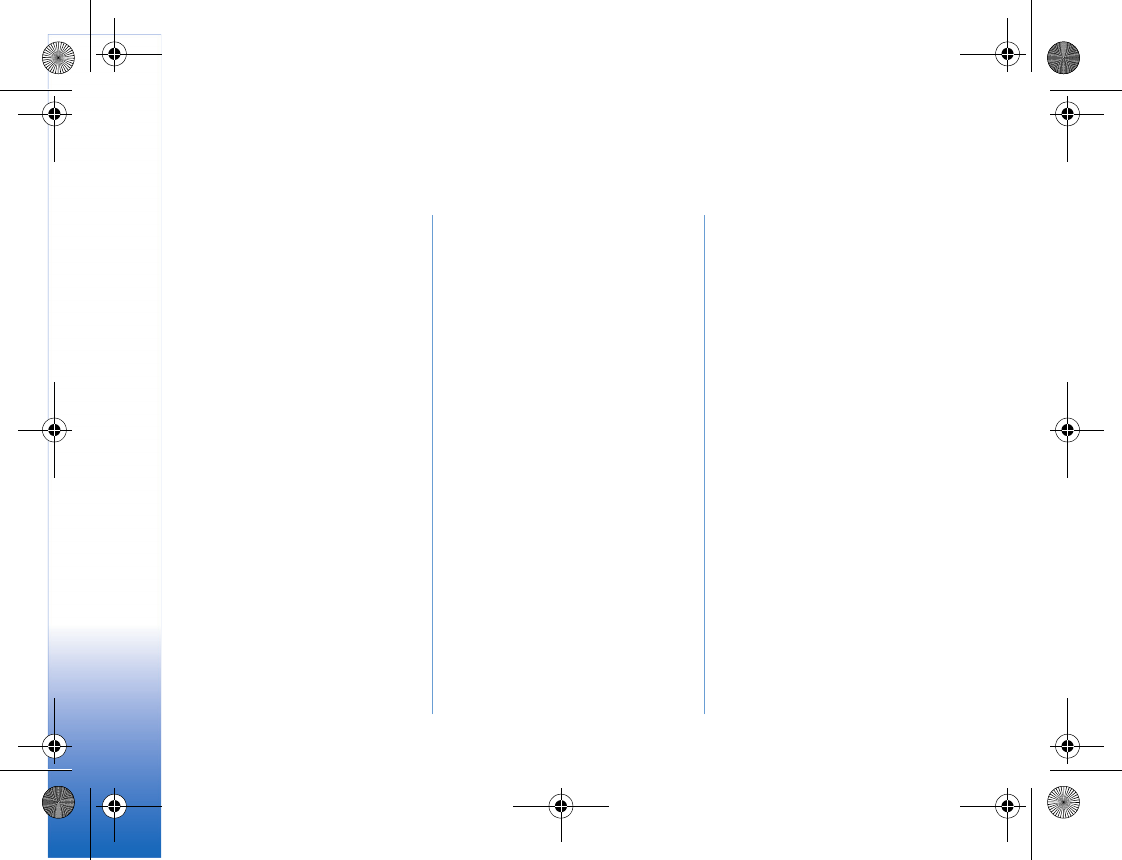
Index
134
Index
A
access points
settings 102
activation keys 43
active standby mode 97
alarm clock 21
application manager 109
applications
installing 110
Java 109
removing 111
audio
file formats 36
audio file formats 36
B
backing up 23
batteries
authenticating 127
Bluetooth
connectivity 112
device address 114
headset 108
pairing 114
sending data 114
switching off 115
bookmarks 78
browsing Internet 79
C
cache, clearing 80
calculator 89
calendar
creating entries 82
deleting entries 83
synchronizing Nokia PC Suite 82
call log
See log
calls
answering 74
declining 74
duration 75
international 72
missed 75
received 75
settings 101
settings for call forwarding 107
transferring 74
camera
active toolbar 29
adjusting lighting and color 32
editing videos 50
flash 31
image setup settings 32
saving video clips 33
self-timer 33
sequence mode 33
still image camera settings 31
video recorder settings 35
certificates 105
chargers 10
chat
See instant messaging
clear screen
See standby mode
clock
alarm 21
settings 21
codes 104
computer connections 117
conference call 72
connection settings 102
contact cards
inserting pictures 69
sending 69
R1114_en.book Page 134 Thursday, October 19, 2006 3:43 PM
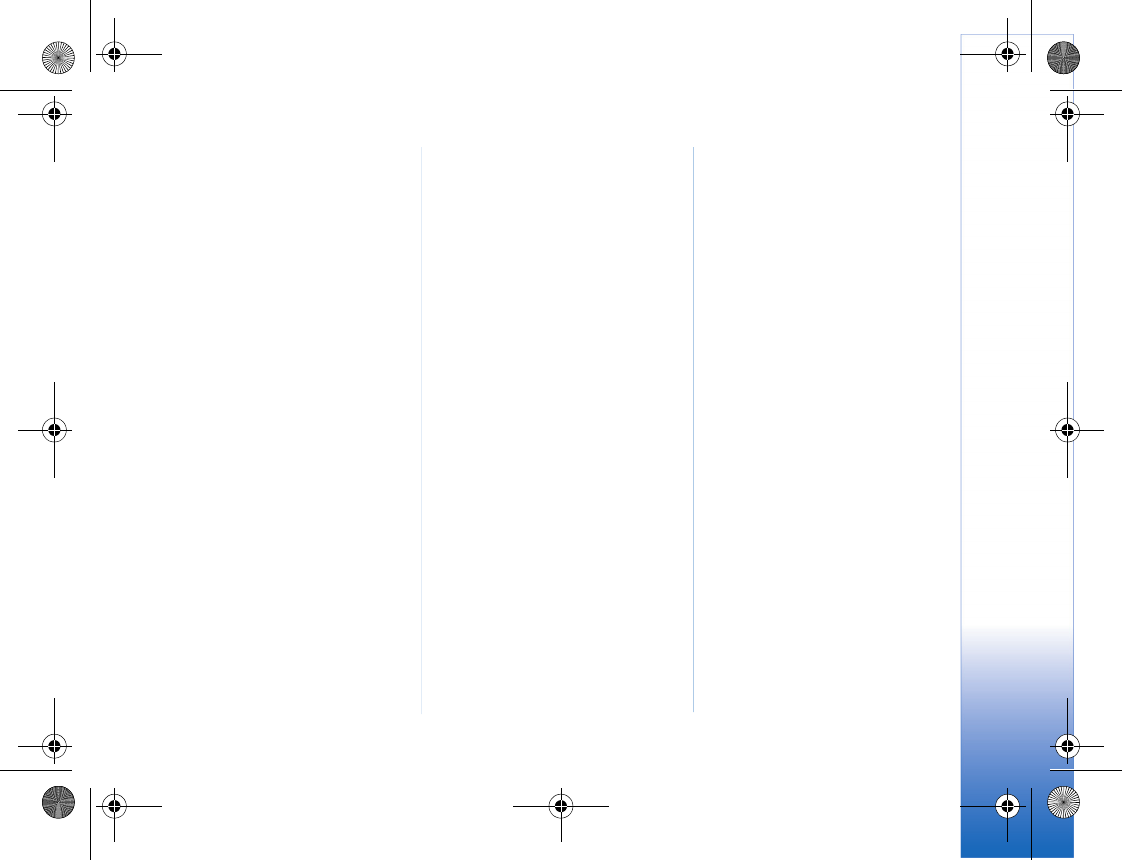
Index
135
storing touch tones 75
converter 89
copying
contacts between the SIM card and
device memory 71
copyright protection
see activation keys
D
data cable 116
data connections
details 117
ending 117
indicators 18
date 21
delivery reports
denying 65
erasing 76
receiving 64
device manager 118
dictionary 56
digital rights management, DRM
see activation keys
display 100
E
edit images 50
editing videos 50
e-mail
automatic retrieving 63
deleting messages 63
opening 63
remote mailbox 62
retrieving from mailbox 62
settings 66
viewing attachments 63
emergency calls 9, 131
enhancements 108, 124
F
file formats
.jad 109
.jar 109, 110
.sis 109
Music player 36
RealPlayer 90
file manager 23
fixed dialing 71
FM radio 93
G
gallery 46
active toolbar 47
edit images 50
free memory 48
ordering files in albums 49
print basket 49
print images 48
slide show 53
H
hands-free operation
see loudspeaker
headset settings 108
help application 27
I
indicators 18
installing applications 110
instant messaging
blocking 87
connecting to a server 85
recording messages 87
sending instant messages 86
Internet
See Web
Internet access points (IAP)
See access points
J
Java
See applications
L
language settings 99
lock code 105
log
erasing contents 76
log duration 76
R1114_en.book Page 135 Thursday, October 19, 2006 3:43 PM
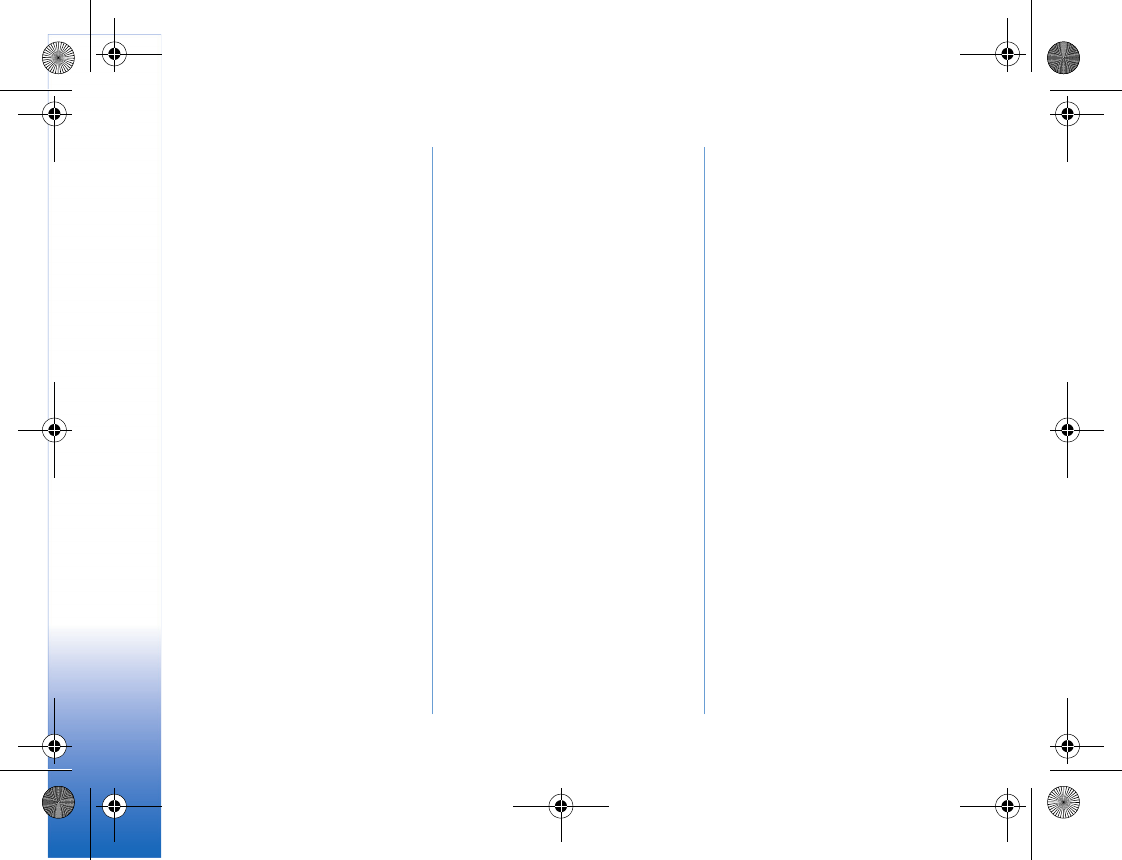
Index
136
loopset settings 108
loudspeaker 20
M
mailbox 62
media files
file formats 36, 90
memory
clearing memory 24, 75
viewing memory consumption 24
memory card 22
memory card tool 23
menu, rearranging 95
Message reader 68
messaging
cell broadcast 68
e-mail 58
inbox 60, 68
mailbox 62
multimedia messages 58
text messages 58
miniSD cards 22
missed calls 75
modes
fold closed 16
fold open 17
movies, muvees
quick muvees 52
multimedia key 25
multimedia messages 58
music
as ringtones 39
file formats 36
Music player 36
equalizer 39
file formats 36
music player
playlists 37
Music shop 42
N
network services 9
Nokia PC Suite
calendar data 82
synchronization 117
transferring music files to your
memory card 40
viewing device memory data 24
notes 90
O
office applications 89
One-touch dialing 73
P
packet data connections
settings 103
PC connections 117
PC Suite
see Nokia PC Suite
personalization 97
phone label 12
phonebook
See contact cards
PIN codes 105
predictive text input 56
print images 48
printing
calendar entries 83
e-mails 63
notes 90
profiles 95
protocols
IMAP4 66
IPv4 and IPv6 103
POP3 66
WAP 9
Q
Quickoffice 9
R
radio 93
RealPlayer 90
recent calls 75
recorder 90
remote mailbox 62
remote SIM mode 113
R1114_en.book Page 136 Thursday, October 19, 2006 3:43 PM
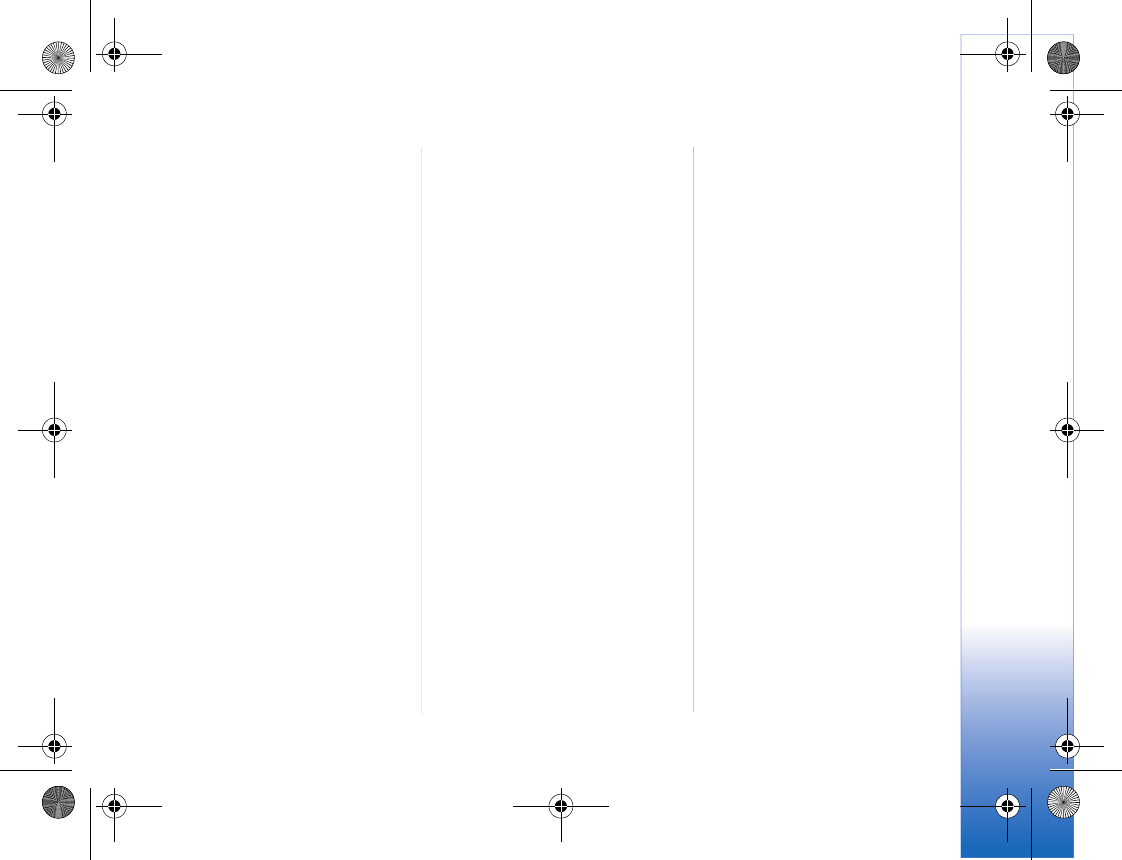
Index
137
ringing tones
personal ringing tone 70, 71
receiving in a text message 61
ringtones
songs 39
S
SAR (specific absorption rate) 132
scenes
image scenes 32
video scenes 32
security code
See lock code
sending
contact cards, business cards 69
video clips 51
service commands 56
Services
See Web
settings
access codes 104
access points 102
Bluetooth connectivity 113
call forwarding 107
call restriction 107
certificates 105
data connections 102
date and time 104
display 100
IM 85, 87
language 99
lock code 105
messaging 64
original settings 99
personalizing the phone 95
PIN code 105
screen saver 100
UPIN code 105
UPUK code 105
shortcuts 18
SIM card
copying names and numbers to
phone 71
messages 64
names and numbers 71
sis file 109
snooze 21
software
installing applications 110
removing applications 111
transferring a file to your device
110
songs
as ringtones 39
file formats 36
sound clips 46
sounds
adjusting volume 20
muting a ringing tone 74
recording sounds 90
standby mode 95
svg files 53
synchronization 117
T
text messages
character limit 59
receiving 60
sending 58
settings 64
writing 58
themes 97
time 21
traditional text input 56
transferring content from another
device 25
troubleshooting 121
tutorial 27
U
UPIN codes 105
UPUK codes 105
USSD commands 56
V
video clips 46
video player
R1114_en.book Page 137 Thursday, October 19, 2006 3:43 PM
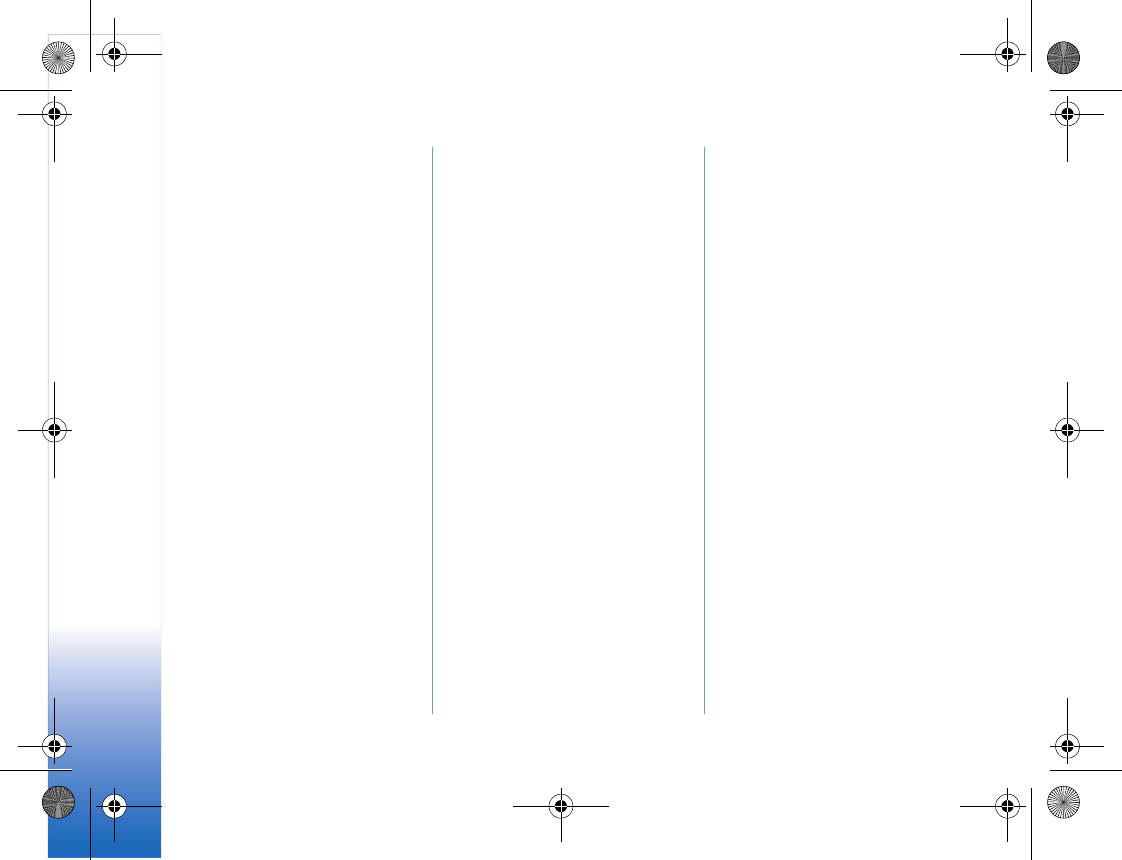
Index
138
See RealPlayer
voice commands 108
voice dialing 73
voice mailbox
changing the phone number 72
forwarding calls to voice mailbox
107
voice messages 72
voice tags
making calls 73
volume control
adjusting volume 20
during a call 72
loudspeaker 20
W
wallpapers
changing 97
using pictures 31, 47
Web
access points 102
browser 45, 78
R1114_en.book Page 138 Thursday, October 19, 2006 3:43 PM